Jack Ross's Blog, page 3
February 4, 2025
The Uncollected Henry James
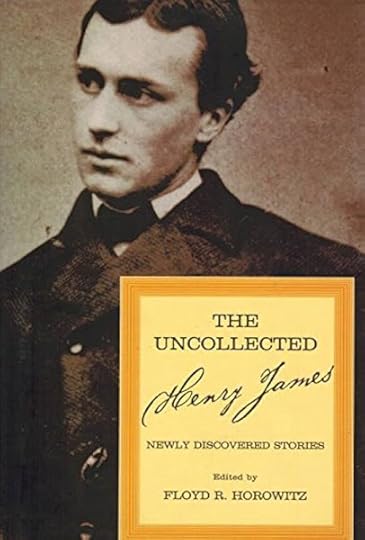 Floyd R. Horowitz, ed.: The Uncollected Henry James (2004)
Floyd R. Horowitz, ed.: The Uncollected Henry James (2004)The moment I saw this book in a second-hand shop I knew I had to have it. It's exactly the kind of thing I love: a monomaniac academic's life work, nestled neatly between two covers.
That's not to say that it doesn't come with impressive literary credentials. As the blurb on the back-cover puts it:
More than two decades of research, study, and literary detection lie behind this treasury of stories by one of the undisputed giants in the field of American fiction, as Professor Floyd Horowitz here offers a collection of tales that he himself has authenticated to be the work of the prodigiously gifted Henry James, ... justly remembered for his novellas and scores of short stories. And there may indeed be scores more [my emphasis], as this important volume shows. Published anonymously or under noms de plume in magazines like nineteenth-century New York's favourite The Knickerbocker, Frank Leslie's Lady's Magazine, The National Magazine, and The Continental, these previously uncollected pieces represent both apprentice work and early stories that already bear the mark of Jamesian artistry. Written in a period of more than ten years before James's first signed fiction appeared (in 1865) ... these uncovered stories add significantly to the James canon.Well, you can't say better than that! So precocious was this studious young man that he apparently wrote (and published) at least 24 stories between the ages of 9 (!) and 26 as a kind of side-hustle to his burgeoning official career as a professional author, which began with "The Story of a Year" in 1865, and eventually grew to include no fewer than 112 stories (as you'll see if you consult this list of his work in that genre).
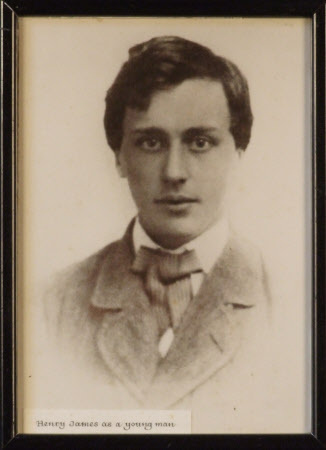 "Henry James as a Young Man" (1843-1916)
"Henry James as a Young Man" (1843-1916)My comments above may sound a little sceptical, but they're not meant to be. After all, most young writers fill page after page with more-or-less accomplished juvenilia before they eventually begin to publish - and many are subsequently anxious to suppress any evidence of early work which appeared in print before they were ready ...
And, in at least partial support of Horowitz's claims, the first item on the list of authenticated James short stories, "A Tragedy of Error" (1864) was indeed published anonymously, and only identified by his biographer Leon Edel through a chance reference in a letter.
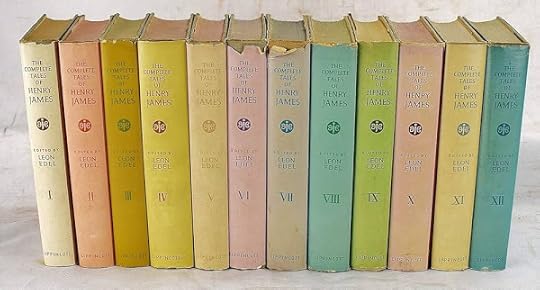 Leon Edel, ed. The Complete Tales of Henry James (12 vols: 1962-64)
Leon Edel, ed. The Complete Tales of Henry James (12 vols: 1962-64)For that matter, the first dozen or so of his canonical stories could probably be quietly shelved without any great loss to posterity. The Master himself only included a little over half of the 100-odd novellas and short stories he'd previously published in the multi-volume New York Edition (1907-09), which he definitely intended to stand as his last word on the matter.
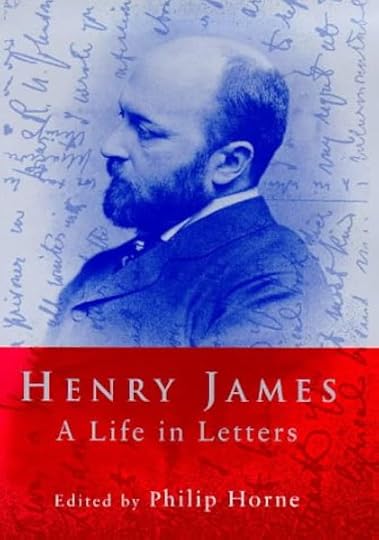 Philip Horne, ed. Henry James: A Life in Letters (1999)
Philip Horne, ed. Henry James: A Life in Letters (1999)So what are these new stories like? And, more to the point, are they really all by Henry James? Distinguished Jamesian Philip Horne, editor of the Life in Letters pictured above, is, unfortunately - according to the précis at the top of his review - "not convinced of the authorship of Floyd R Horowitz's 'newly discovered' Henry James stories." That, however, "does not mean that they are not worth reading."
His Guardian article is too long and closely argued to quote here in detail, but I thought I might tease out a few of the more telling points:
Horowitz's central notion is that young James had a secret life as "Leslie Walter", consistently using that pseudonym to get his stories into (mostly unremunerated) print: eight of those here, mostly later ones, seem to be attributable to that author.Horne, however, detects certain problems with this hypothesis:
I discovered, for example, that in January 1869, well after James had broken cover under his own name, "Lesley Walter" published a pretty awful sentimental poem called "Among the Lilies" in the Galaxy: Horowitz doesn't mention the supposed alter ego's unJamesian propensity for verse. And then Leslie Walter's rather monotonous subject matter, supposedly showing a closeness to James's father's Swedenborgian philosophy, seems just conventionally pious ... Indeed, these tales often amount to cases of what [Henry James] used to call with withering scorn "flagrant morality". Horowitz might have done better to claim they were parodies.But he goes on to concede:
This is not to say that one steeped in James, and reading for resemblance, doesn't occasionally come across something that seems strikingly close to the master's voice in these tales, or fleeting parallels of situation. Horowitz has built a certain plausible deniability into his case, moreover, in the sense that these stories are presented as apprentice works, written to the house style of the Knickerbocker or the Newport Mercury, from a period mostly before we have any authenticated James fiction.In other words, anything unlike James can be attributed to his desperation to break into print by aping each journal's house-style. Anything that is like him is clear proof of his authorship. Either way, Horowitz can claim to be vindicated. Horne, however, is not having any:
The greatest value and interest of this collection ... is ultimately not that it's by James, but that it isn't. Short stories reveal worlds even when they're affected or sentimental or badly written, and this book constitutes a vivid picture of the literary, cultural and social universe James entered. Apart from showing us just how original he actually was, it reeks of the dead past ...
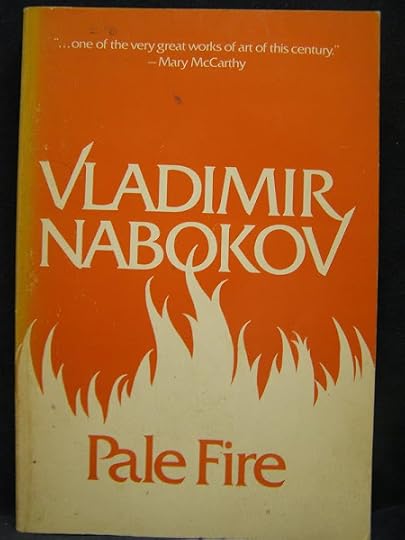 Vladimir Nabokov: Pale Fire (1962)
Vladimir Nabokov: Pale Fire (1962)"From time to time one catches a whiff of Pale Fire mania in the confident circularity of Horowitz's logic," Horne comments about the former's methodology - the magic wand which rendered this Computer Science professor capable of nosing out lost pieces of Jamesiana amongst all the reams of abandoned fiction he'd been assembling for the past thirty years.
Pale Fire , for those of you unfamiliar with this most teasing and, in some respects, most worrying of Nabokov's fictions, "is presented as a 999-line poem titled "Pale Fire", written by the fictional poet John Shade, with a foreword, lengthy commentary and index written by Shade's neighbor and academic colleague, Charles Kinbote."
Kinbote, who is (most readers would agree) a delusional monomaniac, "inherited" (i.e. stole) the manuscript of "Pale Fire" after John Shade's murder, and is now attempting to prove in his commentary-cum-autobiography that this poem, which never directly mentions the subject, is nevertheless is almost entirely about him and the (possibly imaginary) country of Zembla, whose lost king he may or may not be.
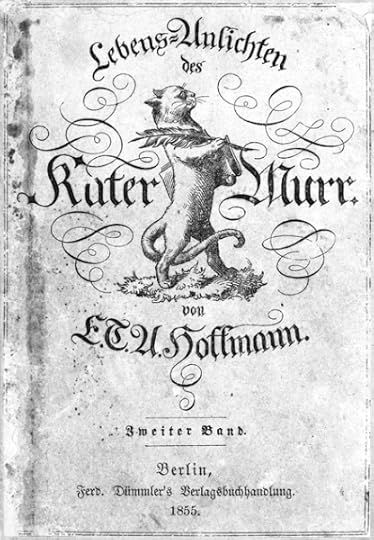 E. T. A. Hoffmann: Lebens-Ansichten des Katers Murr nebst fragmentarischer Biographie
E. T. A. Hoffmann: Lebens-Ansichten des Katers Murr nebst fragmentarischer Biographiedes Kapellmeisters Johannes Kreisler in zufälligen Makulaturblättern (1855)
Clear? No? You're not alone in feeling a bit puzzled. Suffice it to say that the nutty, monocular professor is a commonplace of post-modern fiction - but actually the idea of writing a self-refuting, self-satirising commentary on what is alleged to be someone else's work goes way back beyond that: to E. T. A. Hoffmann's Life and Opinions of the Tomcat Murr together with a fragmentary Biography of Kapellmeister Johannes Kreisler on Random Sheets of Waste Paper (1819-21); or, even further, to Laurence Sterne's Life and Opinions of Tristram Shandy (1759-67); or, for that matter, to the fons et origo of most of Sterne's erudition, Robert Burton's Anatomy of Melancholy (1621).
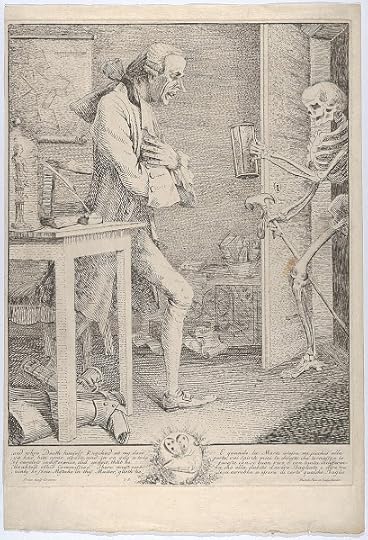 Tristram Shandy: "And When Death Himself Knocked at My Door" (1769)
Tristram Shandy: "And When Death Himself Knocked at My Door" (1769)So how exactly did Professor Horowitz set about distinguishing Henry James's work from all the other sludge in these ancient journals from the 1850s and 1860s? Philip Horne summarises the two, rather technical, appendices in Horowitz's book as follows:
First, by reading his way through the myriad American magazines and journals of the period, "using a set of critical discriminators". These included "the use of particular words, the employment of what I came to recognise as distinctive syntactical and word patterns, the use of puns and other wordplay, as well as the repetition of symbolic allusions, themes, and ideas". He also found "corroborating ideational evidence in the texts", which built up, in his vision, into "a coherent linguistic and philosophical framework that was consistent with the structures and themes of James's later, signed work". In other words, the evidence is massively internal, and interpretative - one might say subjective.It puts me in mind of that old hymn about Jesus we used to sing at Sunday School:
You ask me how I know He lives?In other words, I don't know, but I'd like to pretend that I do.
He lives within my heart.
This "I know it when I see it" argument, familiar from Supreme Court Justice Potter Stewart's classic 1964 definition of obscenity, is backed up by some pretty hard science in Horowitz's case, however:
In an appendix called "The Computer and the Search for Henry James", Horowitz took the 20,783 words known to have been written by James between 1858 and 1871 and ran stylometric tests on the tales he'd attributed to James - the test being similarity of vocabulary (single words). This yielded a total of 72 stories by James, and another 12 "probably written by James". I was unable to follow the complicated details of his explanation, but confess to an impression that the hurdle set for identification as Jamesian was worryingly low. Stories with the same kinds of setting and with similar themes will surely generate many chimings of vocabulary without being being really similar in style. And there's no test of quality: some of these tales are pretty execrable.72 (+ 12 doubtful cases) is a pretty high number for us to credit. After all, these are stories James allegedly published, not simply wrote, during this period. He must have been banging them out, rain or shine, at a rate of about one a month!
But wait, there's more!
The allusion test, in another appendix called "Allusion as Proof in the Search for Henry James", turns out to mean echoes of things in books in Henry James senior's library, including the Arabian Nights and the King James Bible. Horowitz also detected his young Henry James in putative quasi-Oulipian games with his copy of Anthon's Latin Primer and Reader, taking English words from different columns of the Latin vocabulary lists to generate stories. The problem with these "tests" seemed to me that either the source was very widely known (for example the Bible) or that the words used were not so unusual as to be striking (the Anthon words used to cement Horowitz's case in the short passage he selects as most convincing include "with", "made", "will", "against" and "all") ...Even the most credulous of readers will probably part company with Horowitz when he starts to explain just how James could construct an almost unlimited number of stories out of odd words which just happened to be placed more-or-less contiguously in his Latin Grammar! It all sounds just a little too uncomfortably like those calculations about infinite numbers of monkeys tapping away on infinite typewriters.
Perhaps it's just as well that Horowitz never got to publish the follow-up book Searching for Henry James promised on the blurb for The Uncollected Henry James. At least, I don't think he did. I haven't succeeding in finding any allusions to it online, even in self-published form. What I did find, sadly, was the following for the author himself.
From this I learned that Floyd Horowitz (1930-2014) taught Computer Science at Kansas University for over 30 years, then English at Hunter College, New York for another five years, until his retirement in 1996. He died on August 9th, 2014 "from complications of vascular dementia."
De mortuis nil nisi bonum, as the saying has it: Speak no ill of the dead. I can't help wondering a bit, though. There are some very odd statements - not to mention strikingly eccentric word-choices - in those two appendices at the end of Prof. Horowitz's book. Just how carefully did his editors actually check them before clearing the text for publication?
His obituary concludes, rather poignantly, "He is now at peace."
•
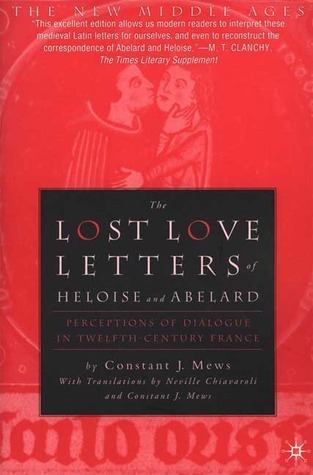 The Lost Love Letters of Heloise and Abelard (1999)
The Lost Love Letters of Heloise and Abelard (1999)Constant J. Mews. The Lost Love Letters of Heloise and Abelard: Perceptions of Dialogue in Twelfth-Century France. Trans. Neville Chiavaroli & Constant J. Mews. 1999. The New Middle Ages. Ed. Bonnie Wheeler. Palgrave. New York: St. Martin's Press, 2001.Mind you, just because it walks like a duck and quacks like a duck doesn't necessarily mean that it is a duck. I recall having a similar uneasy feeling roughly halfway through the book above, by Prof. Constant Mews, son of the composer Douglas Mews, whom I remember very well from my years singing in the Auckland University choir.
Mews's claim to have identified a lost correspondence between medieval scholastic philosopher Peter Abelard and his lover Héloïse d'Argenteuil seemed just a little too good to be true.
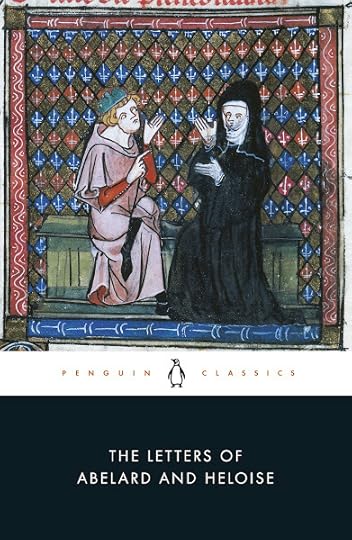 The Letters Of Abelard And Heloise (1999)
The Letters Of Abelard And Heloise (1999)Pretty much everyone interested in the story of these two star-crossed lovers is familiar with the book above: a translation of a Latin correspondence between the two conducted many years after Abelard's seduction of the young girl Heloise, whom he'd been hired to tutor by her uncle Fulbert, a canon of Notre Dame.
The Letters of Abelard and Heloise. Trans. Betty Radice. Penguin Classics. Harmondsworth: Penguin, 1974.
The uncle, as you've no doubt heard, took a fearful revenge on the lustful philosopher. He arranged for him to be castrated by some hired ruffians. Abelard survived, just barely, but that and a number of other scandals (including accusations of heresy) made it almost impossible for him to advance in the church.
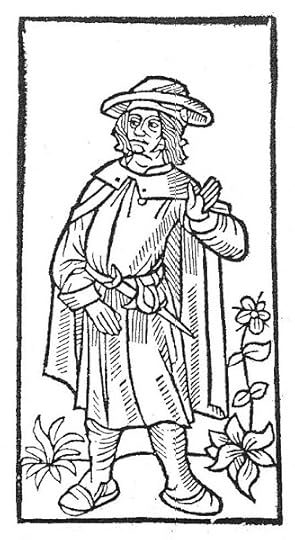 François Villon (1431-c.1463)
François Villon (1431-c.1463)The story was so famous that it's even referred to in fifteenth-century jailbird poet François Villon's famous "Ballade des dames du temps jadis" [Ballad of Ladies of Past Times]:
Où est la très sage Heloïs,
Pour qui fut chastré et puis moyne
Pierre Esbaillart à Sainct-Denys?
Pour son amour eut cest essoyne.
[Where is the very wise Heloise,
For whom Peter Abelard was castrated
then made a monk at Daint Denis?
For his love had this travail.]
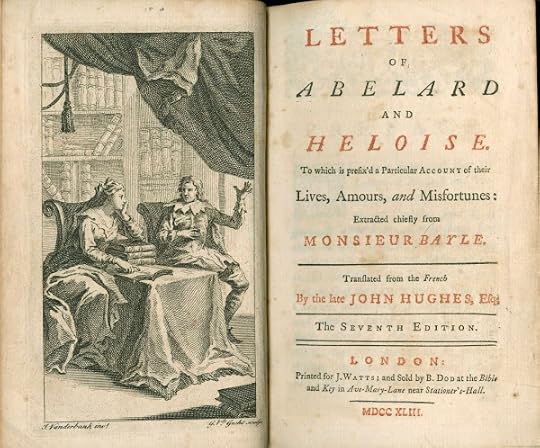 John Hughes: Letters of Abelard and Heloise to Which Is Prefix'd a Particular Account of Their Lives, Amours, and Misfortunes (1743)
John Hughes: Letters of Abelard and Heloise to Which Is Prefix'd a Particular Account of Their Lives, Amours, and Misfortunes (1743)Most readers prefer Heloise's honest and insightful letters to the pompous, top-lofty prevarications of the great scholar, who presumes to lecture her on virtue despite his own obvious shortcomings in that regard.
Mews, however, argues that some earlier letters exchanged by the couple, possibly at the time they first met, have survived in the form of a book of "exemplary letters" for the use of students. As one reviewer commented:
Although the correspondence reproduced and translated [by Mews] has been available to scholars in Latin since Ewald Könsgen's 1974 publication, Mews' edition is the first to translate the letters into English and devote to them the comprehensive commentary they deserve. Könsgen may have made the first tentative suggestions that they might be the letters of Heloise and Abelard, but it is Mews who offers convincing evidence that they are.
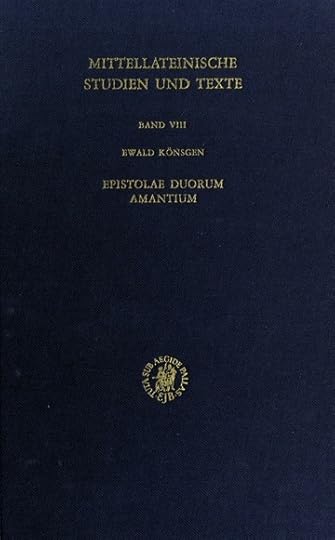 Ewald Könsgen: Epistolae duorum amantium (1974)
Ewald Könsgen: Epistolae duorum amantium (1974)In her own, more comprehensive review, Barbara Newman explains that:
Ewald Könsgen's edition of the twelfth-century Latin text he titled Epistolae duorum amantium: Briefe Abaelards und Heloises? [Correspondence of Two Lovers: Letters by Abelard and Heloise?] (Leiden: Brill, 1974), could not have appeared at a worse time. Scholars had been debating the authenticity of Abelard's famous exchange with Heloise for almost a century, but that controversy, after remaining at a simmer for decades, had just reached the boiling point. At a conference at Cluny in 1972, John Benton had proposed that the entire correspondence was forged in the late thirteenth century to influence a disputed election at the Paraclete. In the same year, D. W. Robertson argued in Abelard and Heloise (New York: Dial Press, 1972) that the real forger was Abelard, who created the literary fiction of Heloise's letters as part of an exemplary treatise on conversion ...Which is not to say that Mews's own claims for the correspondence have been accepted by everyone. His critics, however, are quick to deny the accusation that "they are motivated by professional envy at not having got there first."
In such a climate, no scholar could have been expected to stake his credibility on the anonymous love letters discovered by Könsgen in a late 15th-century manuscript from Clairvaux. Könsgen himself, after all, appended a question mark to his title, arguing only that the letters must have been composed in the Ile-de-France in the early twelfth century by two people "like" Abelard and Heloise. Even Peter Dronke, the staunchest defender of Heloise's writing, did not want to connect the famous lovers with this newly edited correspondence. Such an ascription would have seemed literally too good - or too self-interested - to be true. So Könsgen's edition attracted little notice and vanished without a ripple.
"It's not jealousy, it's a question of method," said Monique Goullet, director of research in medieval Latin at Paris's Sorbonne University. "If we had proof that it was Abelard and Heloise then everyone would calm down. But the current position among literature scholars is that we are shocked by too rapid an attribution process."While, as Barbara Newman asserts, "the majority of scholars now accept the established letters as authentic", the burden of proof is certainly on Mews to demonstrate "beyond a reasonable doubt that the authors of these letters were indeed Heloise and Abelard."
Mews argues on both textual and contextual grounds, providing evidence that: (1) learned women did exchange Latin poems and letters with their male admirers in the early twelfth century; (2) the fragmentary narrative that emerges from the recently discovered letters is consistent in all particulars with what we know of Abelard and Heloise; and (3) most important, the philosophical vocabulary, literary style, classical allusions, and contrasting positions on love apparent in Könsgen's letters are so thoroughly consistent with the known writings of Heloise and Abelard that the supposition of their authorship is simpler than any alternative hypothesis.
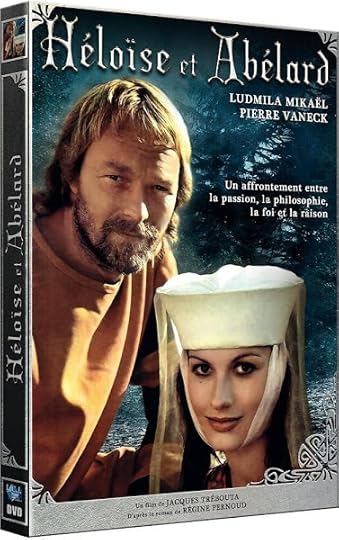 Jacques Trébouta, dir.: Héloïse et Abélard (1973)
Jacques Trébouta, dir.: Héloïse et Abélard (1973)I guess what surprised me most, after reading Mews's book, was the fact that there hadn't been a lot more fuss about so immense and exciting a claim. After all, the love story between Abelard and Heloise, and in particular the character of Heloise herself, have been revisited repeatedly in popular novels and movies, as well as being exhaustively picked over as a theme in medieval studies. Why, then, isn't Mews's book shelved beside Betty Radice's classic translation of the "established letters"?
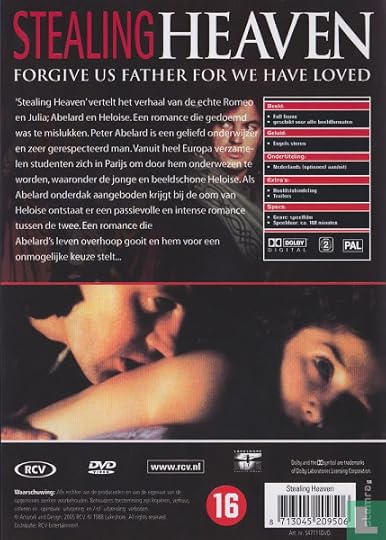 Clive Donner, dir. Stealing Heaven (1988)
Clive Donner, dir. Stealing Heaven (1988)Mews is certainly no fool, and his claims for these letters have been subjected to considerable scrutiny. The alternative explanations offered by some of his critics that it may be "a literary work written by one person who decided to reconstitute the writings of Abelard and Heloise," or "a stylistic exercise between two students who imagined themselves as the lovers, or that it was written by another couple," are perhaps rather less convincing than their own authors may imagine.
As Barbara Newman puts it:
the woman of the Troyes letters simply sounds like Heloise and like no other medieval Latin writer known to us.I wish that that could be the last word on the matter, but I fear that the jury will remain out for a long time yet: possibly forever.
•
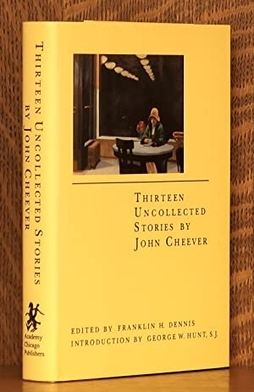 John Cheever: Thirteen Uncollected Stories (1994)
John Cheever: Thirteen Uncollected Stories (1994)So, we have one probable attribution: the "new" Heloise and Abelard letters; and one rather more dubious item, the "uncollected" Henry James stories. Let's conclude with another bibliographical curiosity, these 13 stories by American author John Cheever.
Thirteen Uncollected Stories by John Cheever. Ed. Franklin H. Dennis. Introduction by George W. Hunt, S.J. Note by Matthew Bruccoli. Chicago: Academy Chicago Publishers, 1994.
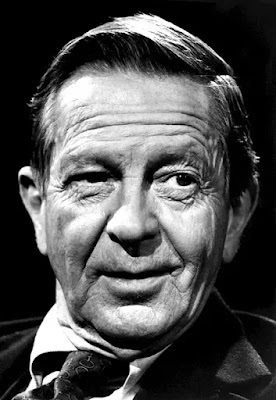 John Cheever (1912-1982)
John Cheever (1912-1982)This is how Wikipedia describes the débâcle surrounding their appearance:
The publication of Thirteen Uncollected Stories by John Cheever had its genesis in a copyright dispute beginning in 1988 between a small publisher, Academy Chicago Publishers, and Cheever's widow, Mary Wintemitz Cheever. Mary Cheever had entered into a contract with Academy for the nominal fee of $1500 to permit publication of a sampling of Cheever's uncollected early short fiction, pending family consultation. When the publisher sought to include all the works not published in The Stories of John Cheever (1978) — a total of 68 stories — a protracted legal struggle ensued.Here there are no doubts at all about the stories' status and genesis: just the desirability of having them in print, alongside the more mature work of this consummate fictional stylist.
Mary Cheever prevailed, but Academy Chicago succeeded in securing publication rights to a total of thirteen stories whose copyrights had lapsed. These are the stories that appear in Thirteen Uncollected Stories by John Cheever.
But that's not really how most academics think: they see the recovery of lost texts as the crown of their scholarly achievements. No wonder so many writers end up burning all their papers - if they get the chance, that is!
Having a foot in both camps, I can sympathise with both of these attitudes. For the most part, I tend to side with the writers. Who knows, though? Which of us isn't ready to call down blessings on the head of Max Brod for not heeding the instructions of his friend Franz Kafka to burn all of his unpublished literary remains, including The Trial, The Castle, and America?
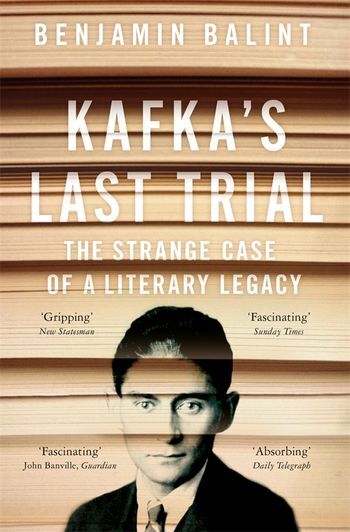 Benjamin Balint: Kafka's Last Trial: The Case of a Literary Legacy (2018)
Benjamin Balint: Kafka's Last Trial: The Case of a Literary Legacy (2018)•
Published on February 04, 2025 12:29
January 24, 2025
Favourite Children's Authors: Rosemary Sutcliff
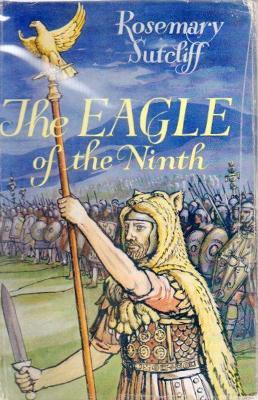 Rosemary Sutcliff: The Eagle of the Ninth (1954)
Rosemary Sutcliff: The Eagle of the Ninth (1954)I wonder how kids nowadays would respond to a book like this? It's exerted a strange fascination over me ever since I first read it in our little school library when I was about 10 or 11 - not so much the details of Roman Army life as the curious atmosphere of the land beyond the frontier: the tribal territories past Hadrian's wall which Marcus Flavius Aquila is forced to negotiate in order to recover the Eagle emblem of his father's legion, the lost Ninth.
In particular, I was impressed by the decision of the sole survivor of the massacred army to stay where he was: "There is no way back past the waters of Lethe." I didn't know (then) what the waters of Lethe were, or even how to pronounce the word, but I got the point. Like a white settler adopted by a Native American community, his incentive to rejoin "civilisation" seemed strangely lacking.
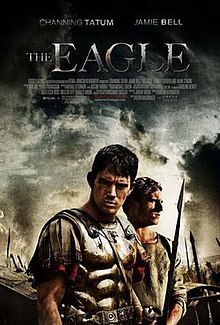 Kevin Macdonald, dir.: The Eagle (2011)
Kevin Macdonald, dir.: The Eagle (2011)That was where the (fairly) recent movie fell short for me - there was too much emphasis on macho heroics, and Channing Tatum was not at all my image of the sensitive, cerebral Marcus of Sutcliff's book.
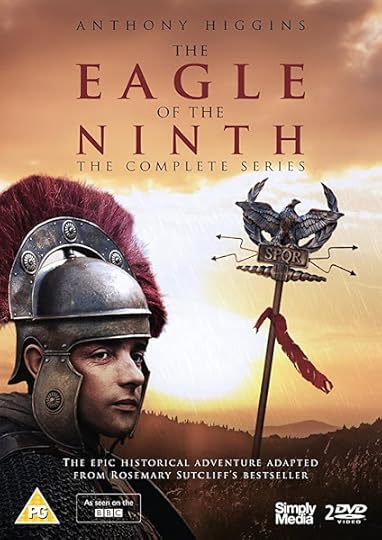 Michael Simpson & Baz Taylor, dir.: The Eagle of the Ninth (1977)
Michael Simpson & Baz Taylor, dir.: The Eagle of the Ninth (1977)There is, apparently, an old British TV miniseries as well, but I've never seen it. It looks pretty clunky from the excerpts included on the imdb, but it would be rather amusing to see Patrick Malahide playing a Pictish tribesman at what must have been the very outset of his career ...
So popular was The Eagle of the Ninth when it first appeared, that Rosemary Sutcliff decided to use Marcus's family, the Aquilas, as the basis for a whole series of novels about the last days of Roman rule in England - and the growth of a new, Anglo-Saxon culture in its place. In each of these books reference is made at some point to an emerald seal ring with a dolphin embossed on it, which had been handed down in the family for generations.
Here (courtesy of Wikpedia) are all eight novels in order - not of publication, but of fictional chronological sequence:
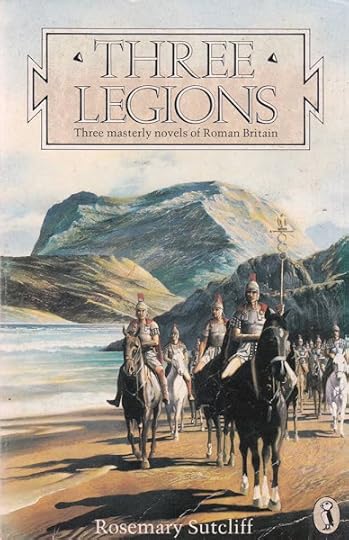 Rosemary Sutcliff: Three Legions (1980)
Rosemary Sutcliff: Three Legions (1980)The Eagle of the Ninth Series:
The Eagle of the Ninth (1954)The Silver Branch (1957)Frontier Wolf (1980)The Lantern Bearers (1959)Sword at Sunset (1963)Dawn Wind (1961)Sword Song (1997)The Shield Ring (1956)
Sutcliff herself was clearly someone who had to surmount more than her fair share of challenges. Confined to a wheelchair from most of her adult life as a result of contracting Still's disease (or juvenile rheumatoid arthritis) as a child, she grew up in Malta and various other bases where her father, a Naval Officer, was stationed.
As a result she had a rather unconventional education, not even learning to read until she was 9 years old. She eventually left school at 14 to attend Art College. After graduating from there, she worked initially as a painter of miniatures. She published her first book, The Chronicles of Robin Hood, in 1950, at the age of 30. The Eagle of the Ninth, her sixth novel, came out in 1954.
Having been runner-up for the Carnegie Medal for the year's best children's book by a British writer on four previous occasions, she eventually won it in 1959 for The Lantern-Bearers.
Perhaps I'm prejudiced, but the books she wrote in the 1950s and early 1960s seem to me more powerful and lasting than much of her later work. That may simply be a matter of having read them at the right age, however. Certainly it was during that period that her own engagement with the Arthurian legend began.
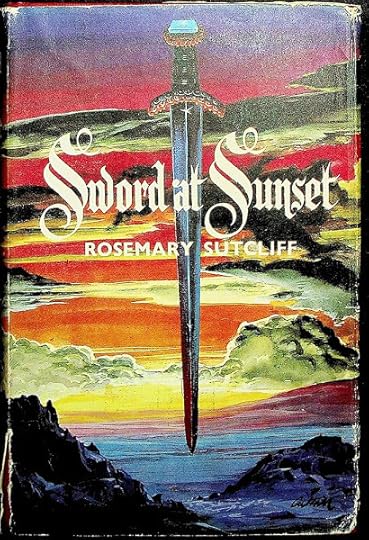 Rosemary Sutcliff: Sword at Sunset (1963)
Rosemary Sutcliff: Sword at Sunset (1963)Arthurian novels:
The Lantern Bearers (1959) Sword at Sunset (1963) Tristan and Iseult (1971)The Arthurian Trilogy:The Sword and the Circle (1981)The Light Beyond the Forest (1979)The Road to Camlann (1981) The Shining Company (1990)
Her most powerful and enduring contribution to the subject, Sword at Sunset, begins - like Mary Stewart's The Crystal Cave - with an epigraph: Francis Brett Young's poem "Hic Jacet Arthurus Rex Quondam Rexque Futurus
It's interesting, in retrospect, to observe just how much this "End of Empire" theme resonated with Sutcliff, as with many other writers of the post-war generation. Imperial Rome was clearly, for them, almost interchangeable with Imperial Britain - and their intense nostalgia for the order and unquestioned assumptions of childhood creeps into all their accounts of "Saxon hordes" overwhelming the last few urbane flickers of Roman civilisation.
Arthur is gone . . . Tristram in Careol
Sleeps, with a broken sword - and Yseult sleeps
Beside him, where the Westering waters roll
Over drowned Lyonesse to the outer deeps.
Lancelot is fallen . . . The ardent helms that shone
So knightly and the splintered lances rust
In the anonymous mould of Avalon:
Gawain and Gareth and Galahad - all are dust.
Where do the vanes and towers of Camelot
And tall Tintagel crumble? Where do those tragic
Lovers and their bright eyed ladies rot?
We cannot tell, for lost is Merlin's magic.
And Guinevere - Call her not back again
Lest she betray the loveliness time lent
A name that blends the rapture and the pain
Linked in the lonely nightingale's lament.
Nor pry too deeply, lest you should discover
The bower of Astolat a smokey hut
Of mud and wattle - find the knightliest lover
A braggart, and his lilymaid a slut.
And all that coloured tale a tapestry
Woven by poets. As the spider's skeins
Are spun of its own substance, so have they
Embroidered empty legend - What remains?
This: That when Rome fell, like a writhen oak
That age had sapped and cankered at the root,
Resistant, from her topmost bough there broke
The miracle of one unwithering shoot.
Which was the spirit of Britain - that certain men
Uncouth, untutored, of our island brood
Loved freedom better than their lives; and when
The tempest crashed around them, rose and stood
And charged into the storm's black heart, with sword
Lifted, or lance in rest, and rode there, helmed
With a strange majesty that the heathen horde
Remembered when all were overwhelmed;
And made of them a legend, to their chief,
Arthur, Ambrosius - no man knows his name -
Granting a gallantry beyond belief,
And to his knights imperishable fame.
They were so few . . . We know not in what manner
Or where they fell - whether they went
Riding into the dark under Christ's banner
Or died beneath the blood-red dragon of Gwent.
But this we know; that when the Saxon rout
Swept over them, the sun no longer shone
On Britain, and the last lights flickered out;
And men in darkness muttered: Arthur is gone . . .
Sutcliff, however, was unusual in being able to see the other side of the equation as well. Her doomed Saxon warriors facing the oncoming Norsemen in The Shield Wall shows an evenhandedness of treatment, as well as a determination to back underdogs against aggressive invaders somewhat reminiscent of the revisionist historical novels of her near-contemporary Geoffrey Trease.
Sutcliff's later works on King Arthur largely content themselves with retelling Malory. But Sword at Sunset is still well worth reading. Her intimate knowledge of weariness and despair seems to have made her exceptionally good at depicting self-doubting, non-triumphant heroes.
That's what continues to ring true in her books, and makes her portrayal of the savage, tormented Cuchulain, the so-called "Hound of Ulster", so much more successful than her dutiful recital of The High Deeds of Finn MacCool.
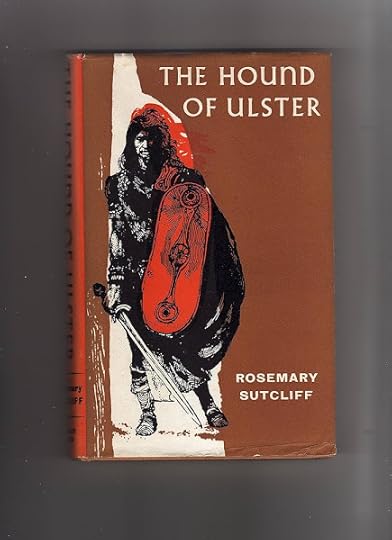 Rosemary Sutcliff: The Hound of Ulster (1963)
Rosemary Sutcliff: The Hound of Ulster (1963)When I think now about my first acquaintance with her books, I remember that I was almost afraid of them. She wasn't content with simple plots about everyday dilemmas: there was genuine violence and fear in almost all of them, as well as a lot more squalid (and smelly) local detail than was typical in children's historical novels of the time.
I can't help thinking that the hardships of her own life must have played against the sentimental romanticism implanted by her mother to create a strikingly realistic - and, for the time, very well researched - series of fantasies of the past. Books such as Warrior Scarlet or Outcast do not sugarcoat the subjects of violence and dispossession.
At times, as in Dawn Wind, she let her guard down and allowed a few rays of hope to steal in - her preference though, as in Francis Brett Young's poem, seems always to have been for the defiant last stand.
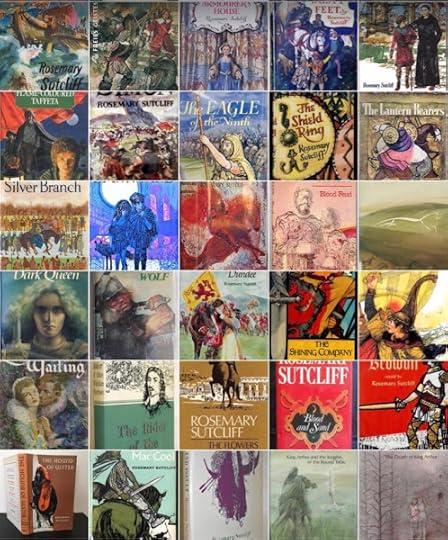 Anthony Lawton: Which book do readers think is Rosemary Sutcliff’s best? (2022)
Anthony Lawton: Which book do readers think is Rosemary Sutcliff’s best? (2022)•
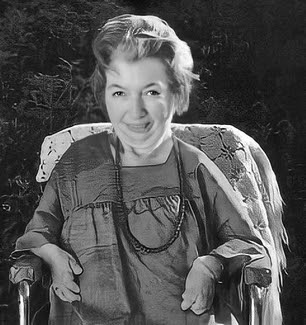 Rosemary Sutcliff (1984)
Rosemary Sutcliff (1984)Rosemary Sutcliff
(1920-1992)
Books I own are marked in bold:Children's Novels:
The Chronicles of Robin Hood. Illustrated by C. Walter Hodges (1950)The Queen Elizabeth Story. Illustrated by C. Walter Hodges (1950)The Armourer's House. Illustrated by C. Walter Hodges (1951)The Armourer's House. Illustrated by C. Walter Hodges. 1951. Oxford Children’s Library. London: Oxford University Press, 1962. Brother Dusty-Feet. Illustrated by C. Walter Hodges (1952)Brother Dustyfeet. Illustrated by C. Walter Hodges. 1952. Oxford Children’s Library. London: Oxford University Press, 1961. Simon. Illustrated by Richard Kennedy (1953)Simon. Illustrated by C. Walter Hodges. 1953. Oxford Children’s Library. London: Oxford University Press, 1959. The Eagle of the Ninth. Illustrated by C. Walter Hodges (1954)The Eagle of the Ninth. Illustrated by C. Walter Hodges. 1954. London: Oxford University Press, 1973.Included in: Three Legions: The Eagle of the Ninth; The Silver Branch; The Lantern Bearers. 1954, 1957, 1959, 1980. Puffin Books. Harmondsworth: Penguin, 1985. Outcast. Illustrated by Richard Kennedy (1955)Outcast. 1955. Illustrated by Richard Kennedy. 1955. New Oxford Library. London: Oxford University Press, 1980. The Shield Ring. Illustrated by C. Walter Hodges (1956)The Shield Ring. Illustrated by C. Walter Hodges. 1956. London: Oxford University Press, 1957. The Silver Branch. Illustrated by Charles Keeping (1957)The Silver Branch. Illustrated by Charles Keeping. 1957. Puffin Books. Harmondsworth: Penguin, 1980.Included in: Three Legions: The Eagle of the Ninth; The Silver Branch; The Lantern Bearers. 1954, 1957, 1959, 1980. Puffin Books. Harmondsworth: Penguin, 1985. Warrior Scarlet. Illustrated by Charles Keeping (1958)Warrior Scarlet. Illustrated by Charles Keeping. 1958. Puffin Books. Harmondsworth: Penguin, 1976.Iincluded in: The Best of Rosemary Sutcliff: Warrior Scarlet; The Mark of the Horse Lord; Knight's Fee. Illustrated by Charles Keeping. 1958, 1963, 1960. London: Chancellor Press, 1987. The Lantern Bearers (1959)The Lantern Bearers. Illustrated by Charles Keeping. 1959. London: Oxford University Press, 1972.Included in: Three Legions: The Eagle of the Ninth; The Silver Branch; The Lantern Bearers. 1954, 1957, 1959, 1980. Puffin Books. Harmondsworth: Penguin, 1985. Knight's Fee. Illustrated by Charles Keeping (1960)Knight's Fee. Illustrated by Charles Keeping. 1960. Oxford Children’s Library. London: Oxford University Press, 1974.Iincluded in: The Best of Rosemary Sutcliff: Warrior Scarlet; The Mark of the Horse Lord; Knight's Fee. Illustrated by Charles Keeping. 1958, 1963, 1960. London: Chancellor Press, 1987. Bridge Builders. Illustrated by Douglas Relf (1960)Beowulf: Dragonslayer. Illustrated by Charles Keeping (1961)Dawn Wind. Illustrated by Charles Keeping (1961)Dawn Wind. Illustrated by Charles Keeping. 1961. London: Oxford University Press, 1970. The Hound of Ulster. Illustrated by Victor Ambrus (1963)The Hound of Ulster. Illustrated by Victor Ambrus. London: The Bodley Head, 1963. The Mark of the Horse Lord. Illustrated by Charles Keeping (1965)Iincluded in: The Best of Rosemary Sutcliff: Warrior Scarlet; The Mark of the Horse Lord; Knight's Fee. Illustrated by Charles Keeping. 1958, 1965, 1960. London: Chancellor Press, 1987. The Chief's Daughter. Illustrated by Victor Ambrus (1967)The Chief's Daughter. 1966. Illustrated by Victor Ambrus. 1967. Piccolo. London: Pan Books, 1978. The High Deeds of Finn MacCool. Illustrated by Michael Charleton (1967)The High Deeds of Finn MacCool. Illustrated by Michael Charlton. London: The Bodley Head, 1967. A Circlet of Oak Leaves. Illustrated by Victor Ambrus (1968)The Witch's Brat. Illustrated by Richard Lebenson (1970)The Truce of the Games. Illustrated by Victor Ambrus (1971)Tristan and Iseult (1971)Tristan and Iseult. 1971. Illustrated by Victor Ambrus. Puffin Books. Harmondsworth: Penguin, 1974. Heather, Oak, and Olive: Three Stories ["The Chief's Daughter", 1967; "A Circlet of Oak Leaves", 1968; "A Crown of Wild Olive", 1971]. Illustrated by Victor Ambrus (1972)The Capricorn Bracelet: Six Stories. Illustrated by Charles Keeping & Richard Cuffari (1973)The Changeling. Illustrated by Victor Ambrus (1974)[with Margaret Lyford-Pike] We Lived in Drumfyvie (1975)Blood Feud. Illustrated by Charles Keeping (1976)Blood Feud. 1976. Illustrated by Charles Keeping. Puffin Books. Harmondsworth: Penguin, 1978. Sun Horse, Moon Horse. Illustrated by Shirley Felts (1977)Sun Horse, Moon Horse. 1977. Decorations by Shirley Felts. Knight Books. London: Hodder & Stoughton, 1982. Shifting Sands. Illustrated by Laslzo Acs (1977)Song for a Dark Queen (1978)The Light Beyond the Forest. Illustrated by Shirley Felts (1979)Three Legions [aka Eagle of the Ninth Chronicles (2010)] ["The Eagle of the Ninth", 1954; "The Silver Branch", 1957; "The Lantern Bearers", 1959] (1980)Three Legions: The Eagle of the Ninth; The Silver Branch; The Lantern Bearers. 1954, 1957, 1959, 1980. Puffin Books. Harmondsworth: Penguin, 1985. Frontier Wolf (1980)Frontier Wolf. 1980. Puffin Books. Harmondsworth: Penguin, 1984. Eagle's Egg. Illustrated by Victor Ambrus (1981)The Sword and the Circle. Illustrated by Shirley Felts (1981)The Road to Camlann. Illustrated by Shirley Felts (1981)Bonnie Dundee (1983)Bonnie Dundee. 1983. Puffin Books. Harmondsworth: Penguin, 1985. Flame-coloured Taffeta. Illustrated by Rachel Birkett (1986)The Roundabout Horse. Illustrated by Alan Marks (1986)A Little Dog Like You. Illustrated by Jane Johnson (1987)The Best of Rosemary Sutcliff ["Warrior Scarlet", 1958; "The Mark of the Horse Lord", 1965; "Knight's Fee", 1960]. Illustrated by Charles Keeping (1987)The Best of Rosemary Sutcliff: Warrior Scarlet; The Mark of the Horse Lord; Knight's Fee. Illustrated by Charles Keeping. 1958, 1965, 1960. London: Chancellor Press, 1987. The Shining Company (1990)The Minstrel and the Dragon Pup. Illustrated by Emma Chichester Clark (1993)Black Ships Before Troy. Illustrated by Alan Lee (1993)Chess-Dream in a Garden. Illustrated by Ralph Thompson (1993)The Wanderings of Odysseus. Illustrated by Alan Lee (1995)Sword Song (1997)Sword Song. 1997. Red Fox Classics. London: Random House Children’s books, 2001. King Arthur Stories: Three Books in One [aka The King Arthur Trilogy (2007)] ["The Sword and the Circle", 1981; "The Light Beyond the Forest", 1979; "The Road to Camlann", 1981] (1999)
Novels for adults:
Lady in Waiting (1957)The Rider of the White Horse (1959)The Rider of the White Horse. London: Hodder & Stoughton, 1959. Sword at Sunset (1963)Sword at Sunset. London: The Book Club, 1963. The Flowers of Adonis (1969)The Flowers of Adonis. 1969. London: Hodder Paperbacks, 1971. Blood and Sand (1987)Blood and Sand. London: Hodder & Stoughton, 1987.
Autobiography:
Blue Remembered Hills: A Recollection (1983)Blue Remembered Hills: A Recollection. 1983. Oxford: Oxford University Press, 1984.
Non-fiction:
Houses and History. Illustrated by William Stobbs (1960)Rudyard Kipling (1960)Heroes and History. Illustrated by Charles Keeping (1965)People of the Past: A Saxon Settler. Illustrated by John Lawrence (1965)
•
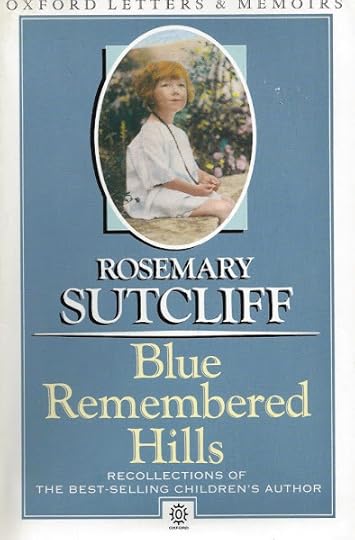 Rosemary Sutcliff: Blue Remembered Hills (1983)
Rosemary Sutcliff: Blue Remembered Hills (1983)•
Published on January 24, 2025 14:41
January 8, 2025
Favourite Children's Authors: Mary Stewart
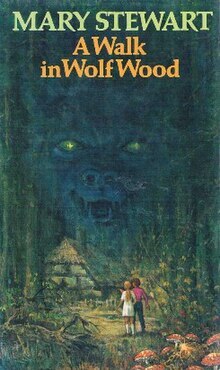 Mary Stewart: A Walk in Wolf Wood (1980)
Mary Stewart: A Walk in Wolf Wood (1980)It seems like an auspicious sign that I should have run across a first edition of Mary Stewart's A Walk in Wolf Wood in a vintage shop on New Year's Eve.
It's not my favourite among her children's books, but it's still a nice piece of timeslip fiction, with werewolves, and enchantments, and enchanted talismans, and all the usual appurtenances of her stories.
The American edition was actually subtitled "A Tale of Fantasy and Magic", in case potential buyers might be in doubt on the matter.
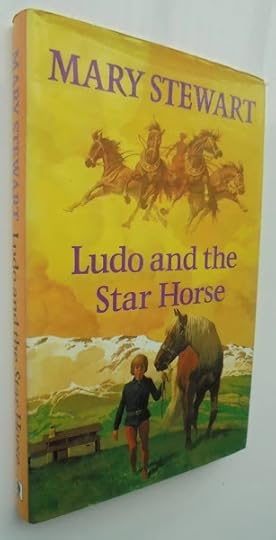 Mary Stewart: Ludo and the Star Horse (1974)
Mary Stewart: Ludo and the Star Horse (1974)More to the point, I'd only seen it previously as a rather scruffy little paperback, whereas this hardback looks exceptionally handsome alongside my copies of her other two books in the genre, Ludo and the Star Horse and The Little Broomstick.
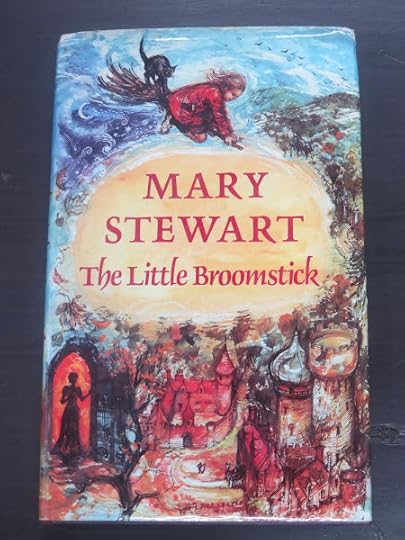 Mary Stewart: The Little Broomstick (1971)
Mary Stewart: The Little Broomstick (1971)The latter has recently been filmed - with a largely rewritten plot and somewhat sub-standard animation - as Mary and the Witch's Flower by Studio Ghibli. I'm normally a fan of their work, but in this case they didn't really succeed in catching the richly atmospheric simplicity of the original: a fantasy classic if ever there was one.
In particular, Endor College, Madam Mumblechook's School of Witchcraft and Wizardry seems like a definite prototype for J. K. Rowling's Hogwarts. And there are many other seemingly throwaway details in Stewart's story, such as the strangely offkilter nursery rhymes recited within the walls of the college, which have stayed stuck in my head for all these years.
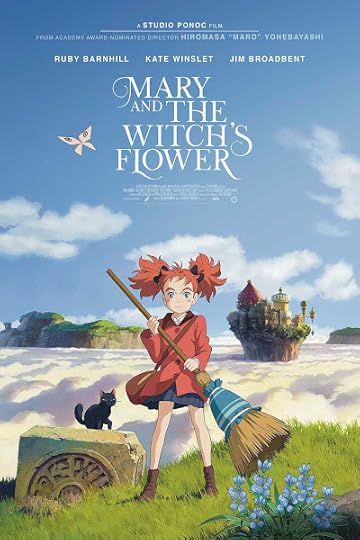 Hiromasa Yonebayashi, dir.: Mary and the Witch's Flower (2017)
Hiromasa Yonebayashi, dir.: Mary and the Witch's Flower (2017)The Little Broomstick is probably Stewart's best and most inventive children's book. And yet, despite that, I wouldn't call it my favourite among the three. Ludo and the Star Horse, her cleverly concocted guide to the signs of the Zodiac and other wonders of the night sky, is the one I never tire of.
Of course, as with most children's books, to get their full flavour you really have to have been there - to have read them when you were still a kid. The Little Broomstick was published when I was nine, and Ludo when I was twelve. I don't know when my parents first bought them, but probably on first publication, given the fact that both are first editions.
I certainly had no objections at that age to reading "girly" kid's books alongside the more boy's-own offerings of W. E. Johns, Arthur Catherall et al. My sister Anne was a fan of Mary Stewart's romance novels, which meant that I ended up reading all of those, too. Despite my initial misgivings, I found I really liked them - particularly the ones set in exotic locales such as Provence or the Greek Islands.
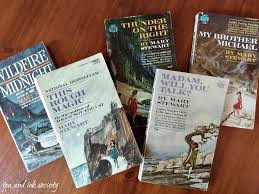 Mary Stewart: Romance Novels (2020)
Mary Stewart: Romance Novels (2020)It's alleged that Charles Darwin had two criteria for the novels he read as a respite from his labours: they had to have a happy ending, and the heroine must be good-looking. Much ink has been spilt on the rich irony of this juxtaposition: the prophet of biological determinism a closet sentimentalist in his off-hours!
There's something to be said for such comfortable generic expectations, though. Mary Stewart, the uncrowned "Queen of Romantic Suspense", understood exactly what her audience wanted: a frisson of fear, some dark shadows at the heart of the narrative, but no devastating surprises at the end. She was always more of an Ann Radcliffe than a Monk Lewis.
 Mary Stewart: The House of Letterawe
Mary Stewart: The House of LetteraweAnd so it might have gone on indefinitely. She published a new book virtually every year between 1955 and 1968. Her publishers were happy; the fans were satisfied; she seemed to have found her ideal role both in literature and life, in her grand estate on Loch Awe in the Scottish Highlands.
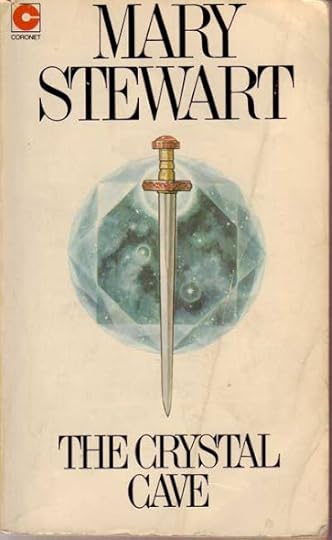 Mary Stewart: The Crystal Cave (1970)
Mary Stewart: The Crystal Cave (1970)But then something happened: something unprecedented and completely off-topic. She wrote the autobiography of a Dark Ages boy with prophetic gifts, a boy called Merlin. She called it The Crystal Cave, after a strange little poem by Orkney writer Edwin Muir:
O Merlin in your crystal caveFans of her romance novels had no idea what to make of all this. She did write a few more in that vein, at widely scattered intervals, but from now on she was firmly in the grip of the Arthurian bug, which I've written more about here and here.
Deep in the diamond of the day,
Will there ever be a singer
Whose music will smooth away
The furrow drawn by Adam's finger
Across the memory and the wave?
Or a runner who'll outrun
Man's long shadow driving on,
Break through the gate of memory
And hang the apple on the tree?
Will your magic ever show
The sleeping bride shut in her bower,
The day wreathed in its mound of snow
and Time locked in his tower?
I called it "England's Dreaming" in the second of these posts, where I tried to link this fascination with the possible historicity of a figure called "King Arthur" with the wider subject of literary psychogeography.
However you try to account for it, though, this fascinating mania was at its height in the 1960s and 70s - presumably as part of the contemporary revival of New Age ideologies of nature worship and revived paganism.
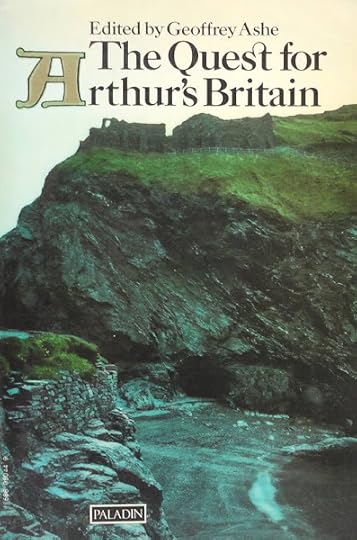 Geoffrey Ashe, ed.: The Quest for Arthur's Britain (1971)
Geoffrey Ashe, ed.: The Quest for Arthur's Britain (1971)Geoffrey Ashe's Quest for Arthur's Britain was one of the Bibles of the new faith - even more than his slew of other books on the subject - principally because it seemed to promise concrete archaeological evidence for the existence of a charismatic warlord who flourished in the late 5th century, at much the same time as the romanticised "King Arthur."
A kind of orthodoxy grew up which took for granted that the resistance of the last Romano-Britains against the incoming Saxons had given rise not only to the idea but also a good deal of the detail of the exploits of this "Arthur" - whatever he looked like, and wherever he was based.
The intensity of Mary Stewart's imagination enabled her to flesh out this Romano-British world, still full of the relics of empire but gradually sliding into the chaotic world of tribal rivalries and local warlords.
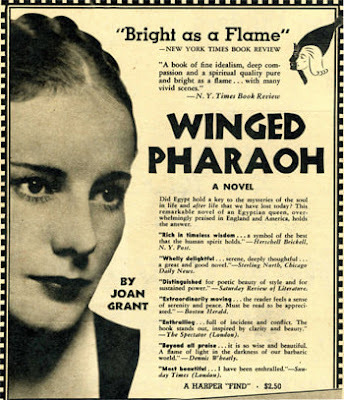 Joan Grant: Winged Pharaoh (1937)
Joan Grant: Winged Pharaoh (1937)Her book was, accordingly, a massive success. It remains not only tremendously readable but also strangely persuasive in its vision of those long-lost times, poised between Classical antiquity and the oncoming heroic age. It was as if she'd had a vision, or an out-of-body experience, along the lines of the "reincarnation novels" of English parapsychologist Joan Grant.
The difference was that Mary Stewart could write.
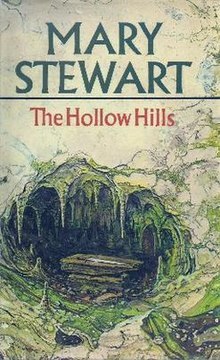 Mary Stewart: The Hollow Hills (1973)
Mary Stewart: The Hollow Hills (1973)Am I the only one to have found the sequel a little disappointing? Merlin gradually retreats from centre stage to share the limelight with the boy Arthur who (I'm sorry to say) has little of the same incandescent star power.
There's less (I suppose inevitably) of the magic of a child's intense perceptions of the world, and more of the necessary politics involved in setting up a kingdom in Dark Age Britain.
It's still all very well written, mind you - and it's hard to imagine any normal reader actually stopping reading following Stewart's expertly woven story at the end of book one, but I'm afraid that it's The Crystal Cave which remains the masterpiece. The other books simply serve to flesh out the theme it proposes.
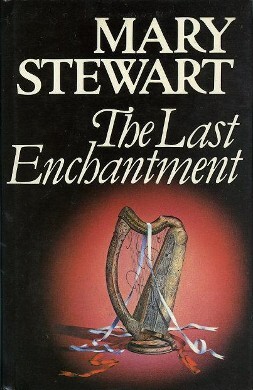 Mary Stewart: The Last Enchantment (1979)
Mary Stewart: The Last Enchantment (1979)Those of us who read these books when they first came out had a long weary wait before we could get out hands on The Last Enchantment. And it was bound to be a disappointment on some level, given this level of anticipation.
It's good enough. It completes the trilogy - Merlin's story is told to its end, though there are still some aspects of Arthur's left to fill in. Or so Stewart must have thought, anyway, as she went on to write a further instalment, devoted to the equally crucial figure of Mordred.
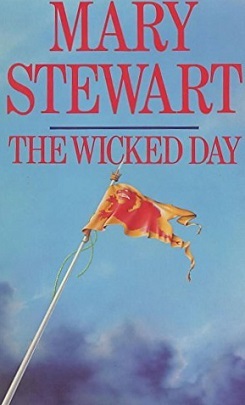 Mary Stewart: The Wicked Day (1983)
Mary Stewart: The Wicked Day (1983)He is, of course, in many ways the most interesting character in the whole story: the Judas to Arthur's Christ. No-one's exactly cracked him yet, but there have been some pretty good attempts along the way.
Is this one of them? Up to each reader to decide, I guess. ...
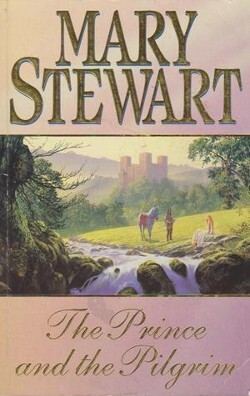 Mary Stewart: The Prince and the Pilgrim (1995)
Mary Stewart: The Prince and the Pilgrim (1995)And finally, last and definitely least, there's The Prince and the Pilgrim. Stewart was nearly 80 when she published this last addendum to her Arthurian world, and by then the kettle was no longer really on the boil.
The only reason I knew this book even existed was because I found a copy in a bach where I was staying one summer. Of course I promptly read it from cover to cover.
It's not really part of her main Arthurian sequence - nor is it simply a romance novel set in those historical times - but it has elements of both of those things. There's no real harm in it, but it's doubtful if there's much point in it either.
From anyone else, it would simply seem a straightforward potboiler, but I guess it's just the contrast with the wildly passionate writer of The Crystal Cave which makes it seem an unfortunate coda to her career as a visionary historical novelist.
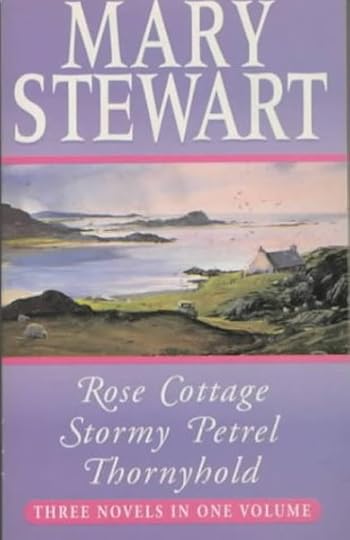 Mary Stewart Omnibus: Rose Cottage / Stormy Petrel / Thornyhold (1999)
Mary Stewart Omnibus: Rose Cottage / Stormy Petrel / Thornyhold (1999)She published a few last novella-length fictions in her original romance vein, with occasional flashes of the old brilliance, but the heart of her work lies earlier: in those first fresh novels, intoxicated by the love of travel and romance in foreign parts; also in the magic of the three children's books.
Above all, it rests on the unforgettable intensity of The Crystal Cave.
 Weird Tales: The Werewolf Howls (1941)
Weird Tales: The Werewolf Howls (1941)•
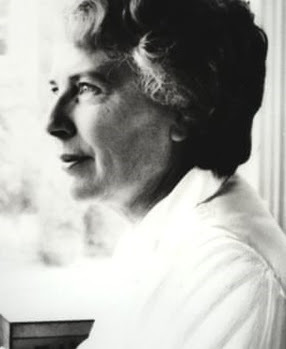 Mary Stewart
Mary StewartLady Mary Florence Elinor Stewart [née Rainbow]
(1916-2014)
Novels:
Madam, Will You Talk? (1955)Madam, Will You Talk? 1955. London: Hodder Paperbacks Ltd., 1971. Wildfire at Midnight (1956)Wildfire at Midnight. 1956. Coronet Books. London: Hodder Paperbacks Ltd., 1974. Thunder on the Right (1957)Thunder on the Right. 1957. Coronet Books. London: Hodder Paperbacks Ltd., 1972. Nine Coaches Waiting (1958)Nine Coaches Waiting. 1958. London: Hodder and Stoughton, 1964.The Castle of Danger [Young Adult version] (Longman simplified TESL Series, 1981) My Brother Michael (1959)My Brother Michael. 1959. Coronet Books. London: Hodder Paperbacks Ltd., 1973. The Ivy Tree (1961)The Ivy Tree. 1961. Coronet Books. London: Hodder Paperbacks Ltd., 1975. The Moon-Spinners (1962)The Moonspinners. 1962. Coronet Books. London: Hodder Paperbacks Ltd., 1973. This Rough Magic (1964)This Rough Magic. 1964. London: Hodder & Stoughton, 1966. Airs Above the Ground (1965)Airs Above the Ground. London: Readers Book Club, 1965. The Gabriel Hounds (1967)The Gabriel Hounds. 1967. London: Hodder Paperbacks Ltd., 1968. The Wind Off the Small Isles (1968)The Wind off the Small Isles. Illustrated by Laurence Irving. London: Hodder & Stoughton, 1968. Touch Not the Cat (1976)Touch Not the Cat. 1976. Coronet Books. London: Hodder and Stoughton, 1977. Thornyhold (1988)Stormy Petrel (1991)Stormy Petrel. London: BCA, by arrangement with Hodder and Stoughton, 1991. Rose Cottage (1997)
Series:
The Merlin Chronicles (1970-1995)The Crystal Cave (1970)The Crystal Cave. 1970. Hodder Paperbacks. London: Hodder & Stoughton, 1971. The Hollow Hills (1973)The Hollow Hills. London: Hodder & Stoughton, 1973. The Last Enchantment (1979)The Last Enchantment. 1979. Coronet Books. London: Hodder & Stoughton, 1980. The Wicked Day (1983)The Wicked Day. 1983. Coronet Books. London: Hodder & Stoughton, 1984. The Prince and the Pilgrim (1995)The Prince and the Pilgrim. 1995. Coronet Books. London: Hodder & Stoughton, 1996.
Children's novels:
The Little Broomstick (1971)The Little Broomstick. Illustrated by Shirley Hughes. Leicester: Brockhampton Press Ltd., 1971. Ludo and the Star Horse (1974)Ludo and the Star Horse. Illustrated by Gino D’Achille. Leicester: Brockhampton Press Ltd., 1974. A Walk in Wolf Wood (1980)A Walk in Wolf Wood. Illustrated by Doreen Caldwell. Hodder and Stoughton Children's Books. London: Hodder & Stoughton, 1980.
Poetry:
Frost on the Window: And other Poems (1990)
•
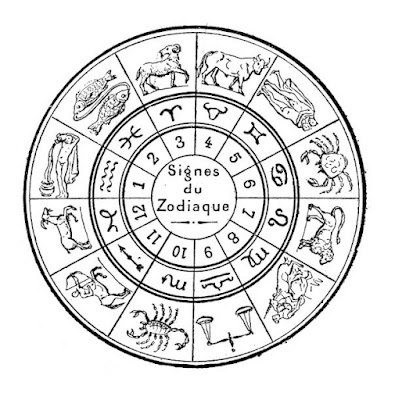 Signs of the Zodiac
Signs of the Zodiac
Aquarius: The Water-Bearer (January 20 – February 18)Deity: GANYMEDE, cupbearer of the gods Pisces: The Fish (February 19 - March 20)Deity: APHRODITE & EROS, goddess of love & god of desire Aries: The Ram (March 21 – April 19)Deity: ARES, god of war Taurus: The Bull (April 20 – May 20)Deity: ZEUS, king of the gods Gemini: The Twins (May 21 – June 20)Deity: APOLLO & ARTEMIS, the divine siblings Cancer: The Crab (June 21 – July 22)Deity: HERA, queen of the gods Leo: The Lion (July 23 – August 22)Deity: ZEUS, king of the gods Virgo: The Virgin (August 23 – September 22)Deity: DEMETER, goddess of agriculture Libra: The Scales (September 23 – October 22)Deity: THEMIS, goddess of justice Scorpio: The Scorpion (October 23 – November 21)Deity: ARTEMIS, goddess of the hunt Sagittarius: The Archer (November 22 – December 21)Deity: APOLLO, the archer Capricorn: The Sea-Goat (December 22 – January 19)Deity: PAN, god of the wild
•
Published on January 08, 2025 13:58
January 6, 2025
The World of Shakespeare
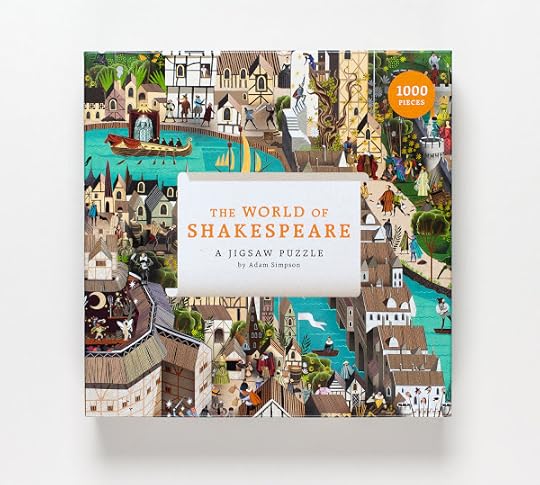 Adam Simpson: The World of Shakespeare (2019)
Adam Simpson: The World of Shakespeare (2019)I'm not sure if four times in a row constitutes a tradition, but this is the fourth time Bronwyn and I have seen the New Year in with a (for us, at least) maniacally difficult jigsaw puzzle.
In 2022 it was The World of Charles Dickens :

In 2023 it was The World of Dracula :
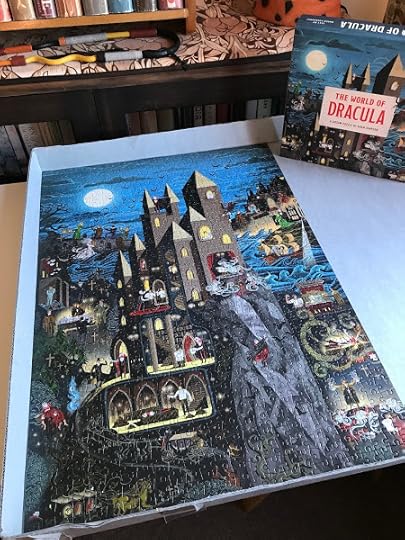
Last year, 2024, it was The World of Hercule Poirot :
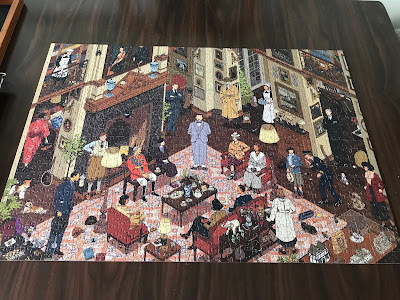
This year, 2025, it's Shakespeare in the hot seat:
 Adam Simpson: The World of Shakespeare (2019)
Adam Simpson: The World of Shakespeare (2019)I've already written a number of posts about Shakespeare - one about the sources for his plays; another about the differences between the quarto and folio editions of his works; and, most recently, one about that perennial question whether Shakespeare was really Shakespeare - or somebody else of the same name.
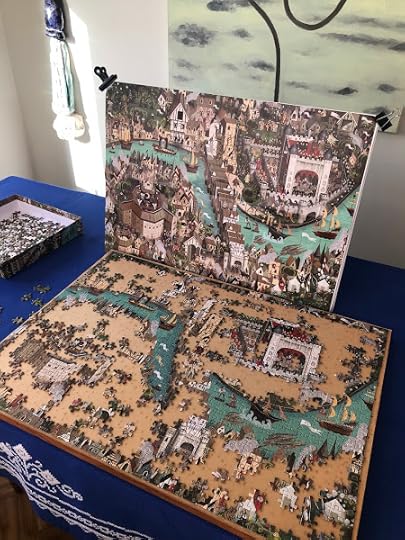 The World of Shakespeare
The World of ShakespearePhotograph: Bronwyn Lloyd (5/1/25)
To tell you the truth, it's a bit of a relief to get out from under that last question and down to the nitty-gritty details of Shakespeare's London: complete with rebel heads on pikes, Gloriana on a floating barge, and a variety of theatrical troupes performing his plays.
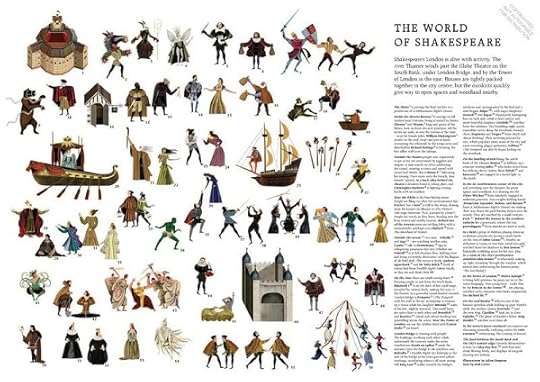 Adam Simpson: The World of Shakespeare (2019)
Adam Simpson: The World of Shakespeare (2019)As you'll have gathered, Shakespeare for me has mostly been a matter of books: biographies, collected editions, contextual "interpretations" ... Watching Kenneth Branagh's absurd adaptation of As You Like It the other day on Neon, though, I was struck by just how much fun Shakespeare can be.
The play is, admittedly, a rather silly one - and Branagh's decision to set it in Meiji-era Japan made literally no sense at all - but it was all still so delightful: exiled maidens running around in drag (for no obvious reason), pinning their love poems on the poor, long-suffering trees; melancholy Jaques spouting long speeches about nothing in particular. What's not to like?
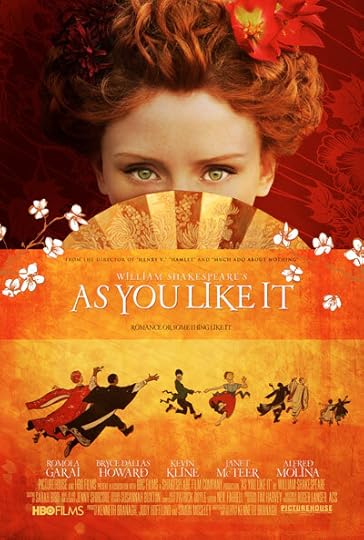 Kenneth Branagh, dir.: As You Like It (2006)
Kenneth Branagh, dir.: As You Like It (2006)It reminded me of the good old days when we used to sit down dutifully to watch each new instalment in Cedric Messina's (then Jonathan Miller's) long-running BBC Television Shakespeare (1978-85). There were some real revelations there. Who would have thought that his early Henry VI trilogy could be made into so gripping a Brechtian presentation on the roots of power? Who knew that the long-neglected Pericles could be made into such a profoundly beautiful and moving drama?
I ended up writing a poem about it, in fact:
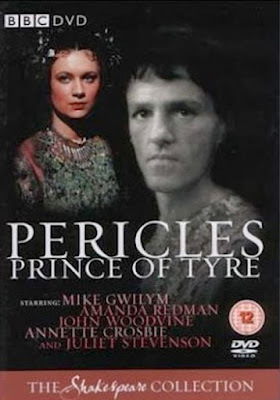 William Shakespeare (with George Wilkins?): Pericles, Prince of Tyre (1984)
William Shakespeare (with George Wilkins?): Pericles, Prince of Tyre (1984)The Late Romances: Pericles
We have reached the 3rd Act
& Pericles
is ranting on the deck
the young Marina
lies in her mother’s arms
(still cold & dark
before revival)
which is coast
which sea?
the billows surge
up to the heavens
bodies bound below
by mortal surges
&how fares the dead?
[8/6/86]
•
What can I say? I was young at the time ...
It's easy enough to get the chance to see the great tragedies, or the Roman plays, or the Richard II / Henry IV / Henry V tetralogy, but the virtue of this BBC version was that they did everything. Timon of Athens, Cymbeline, King John - you name it, it was there. The productions were wildly various in quality, mind you. Some were pretty hard to sit through, others delightful - but they gave you a sense of what each of those 37 plays could be.
As you can guess from the above, it was the late romances - Pericles, Cymbeline, The Winter's Tale, and The Tempest - which were the real thrill for me. You see the last two performed sometimes, but hardly ever the first two.
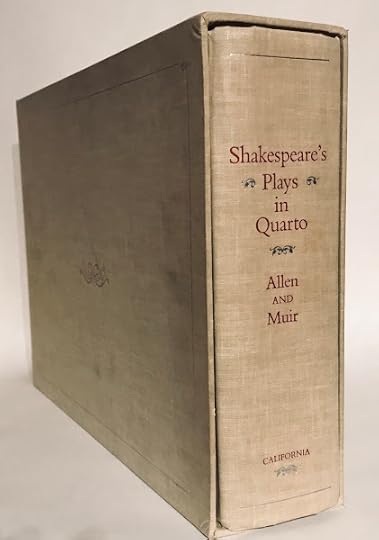 Michael J. B. Allen & Kenneth Muir, ed.: Shakespeare's Plays in Quarto (1981)
Michael J. B. Allen & Kenneth Muir, ed.: Shakespeare's Plays in Quarto (1981)I spent a good deal of time poring over the volume above in the Auckland University Library. So much time, in fact, that I eventually had to buy a copy for myself: a doorstopper if ever there was one!
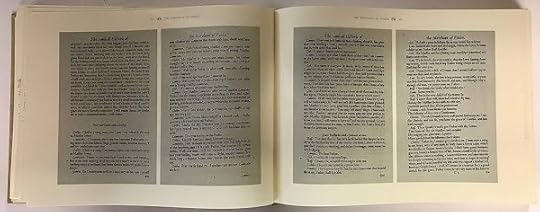 Shakespeare's Plays in Quarto
Shakespeare's Plays in QuartoIt's almost unreadable, to be honest - but if you need to track some errant detail of wording, there it is.
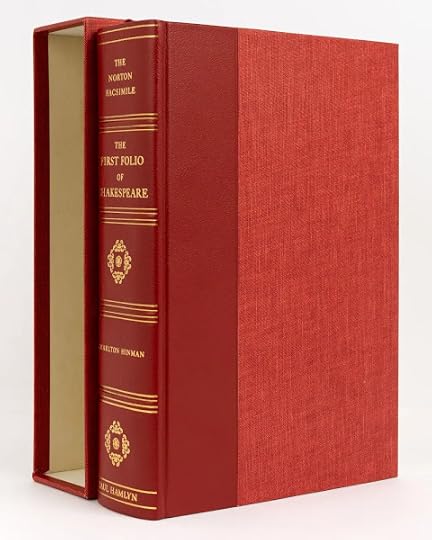 Charlton Hinman, ed.: The Norton Facsimile: The First Folio of Shakespeare (1968)
Charlton Hinman, ed.: The Norton Facsimile: The First Folio of Shakespeare (1968)The Shakespearean First Folio is a different matter. There are various facsimiles to choose from - it's unlikely that any of us will ever have the money (or the hubris) to purchase one of the few surviving copies of the original edition. You'd have to keep it in a bank vault, in any case!
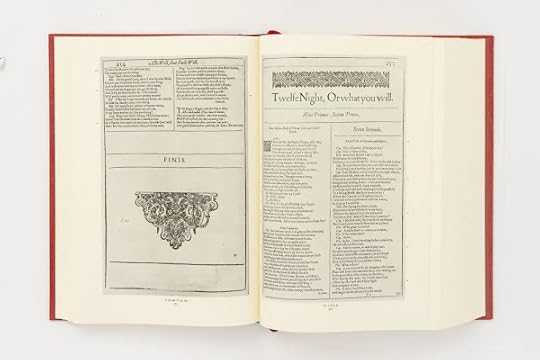 The First Folio of Shakespeare
The First Folio of ShakespeareIt's a very handsome volume - colossal, yes, but clearly laid out and printed, with a host of important creative and critical issues hanging on virtually every line.
In any case, if you're looking for an absorbing way to pass a few idle hours, I'm afraid I can't recommend The World of Shakespeare. It's by far the most difficult of the puzzles we've done to date. There are few tell-tale blocks of colour once you've laid down the blue of the Thames, and a ridiculous number of tricky spires, towers, turrets, gable rooftops and leafy gardens to fill in one by one.
There's certainly some satisfaction in getting it done, but I'm afraid that it's back to the grindstone now for me - as well, I fear, as the rest of you.
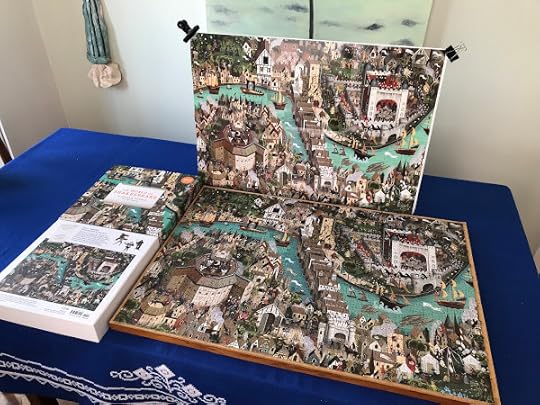
•
A Happy New Year to All in
2025!
•
Published on January 06, 2025 11:59
December 24, 2024
Christmas Books = Christmas Cheer!
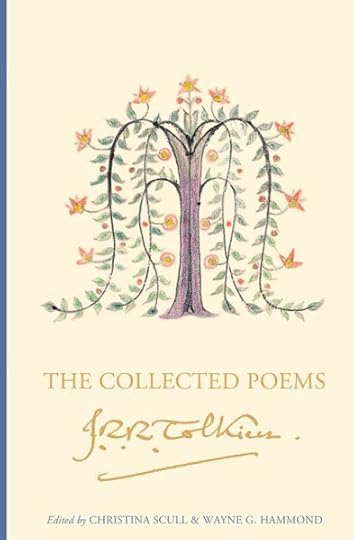 J. R. R. Tolkien: The Collected Poems (3 vols: 2024)
J. R. R. Tolkien: The Collected Poems (3 vols: 2024)Some years ago now I wrote a blogpost called "The Tolkien Industry." It seemed to cause a bit of a stir at the time, and even ended up being reprinted on the Scoop Review of Books (16/6/09).
What I thought were some fairly mild remonstrances at the relentless commercialisation of J. R. R. Tolkien's literary remains apparently touched a raw nerve in quite a few readers. A certain "Mister Lit" enquired:
... does Ross the academic subscribe to the increasingly meaningless dichotomy between ‘high’ and ‘lowbrow’ culture which sees meaningless ‘poetry’ by so-called ‘postmodernists’ studied in great depth while popular, human-oriented authors like Tolkien and Wilbur Smith are regarded as not ‘good enough’?To which I'd reply (some 16 years later): No, not then and not now. I have to say, though, that I do find the juxtaposition of Tolkien and Wilbur Smith somewhat eccentric. So far as I know, no-one's yet been tempted to publish Wilbur Smith's scribbled notes and papers in vast, annotated, scholarly editions. Perhaps it's just a matter of time, though.
The next comment, by a Henry Saltfleet, was even more indignant:
Jack Ross writes: “What’s a poor collector to do? A poor completist collector, that is.” Well, in his case I think he should get rid of his collection and take up a hobby more suited to his intellect — perhaps bowling. His main argument against newly published Tolkien material seems to be that it takes up shelf space. But what is more egregious is his underlying belief that because (for whatever reason) he isn’t interested in such material that he thinks those of us who are interested in it should be deprived of the chance to read it. Fie on him.That sideswipe at bowlers and bowling seems rather more egregious than any of my own misdeeds, I must say. What did they ever do to get dragged into this argument? Bowling is (by all accounts) a sport requiring great visual acuity and muscular skill, which puts it a fair few rungs above balancing books on shelves, I would have thought. If only I had chosen to cultivate it in my misspent youth, how much better off I would be now!
As for the rest, I think Mr. Saltfleet rather missed my point. It wasn't that this material isn't interesting - more that this piecemeal, over-annotated and commentated mode of publication doesn't really do it justice. However, my lament (in 2009) that we still lacked a decent Collected Poems for Tolkien, has finally, a decade and a half later, been met by a massive 3-volume boxed-set edition edited by Tolkienophiles extraordinaire Christina Scull and Wayne G Hammond.
WHICH I JUST GOT FOR CHRISTMAS! (all those heavy-handed hints to Santa must have paid off ...)
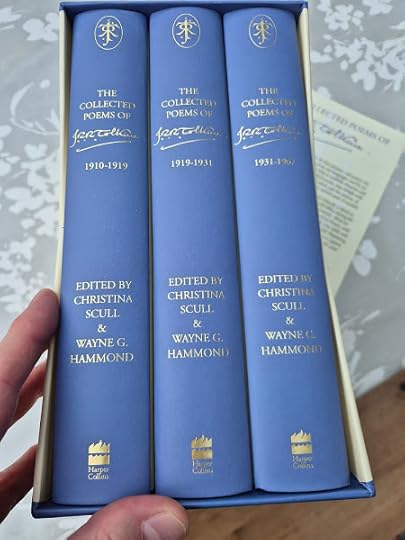 Christina Scull & Wayne G Hammond, ed.: The Collected Poems of J. R. R. Tolkien (3 vols: 2024)
Christina Scull & Wayne G Hammond, ed.: The Collected Poems of J. R. R. Tolkien (3 vols: 2024)"Thrills for Noddy!" - as some of the coarser denizens of my old school used to say when encountering excessive displays of enthusiam. Never mind. Damn them if they can't take a joke. It is quite a thrill - for me, at least.
•
But wait, there's more. As a suitable companion volume, I'd already decided to invest in another absurdly over-elaborate piece of book design, a new edition of Tolkien's The Silmarillion illustrated by its own author!
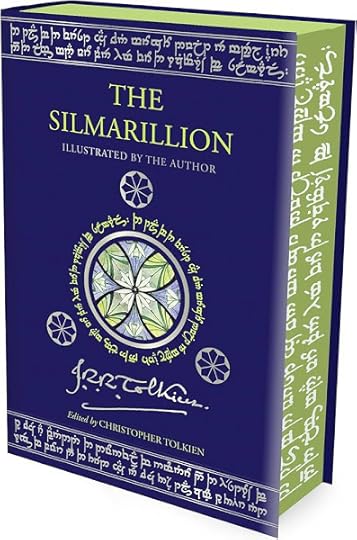 Christopher Tolkien, ed.: The Silmarillion. Illustrated by J. R. R. Tolkien (2022)
Christopher Tolkien, ed.: The Silmarillion. Illustrated by J. R. R. Tolkien (2022)I look forward to rereading it over Summer, savouring Tolkien's clumsy daubs and line-drawings, and perhaps even comparing them from time to time to Ted Nasmith's perhaps slightly over-skilful illustrations for his own 2004 version of The Silmarillion.
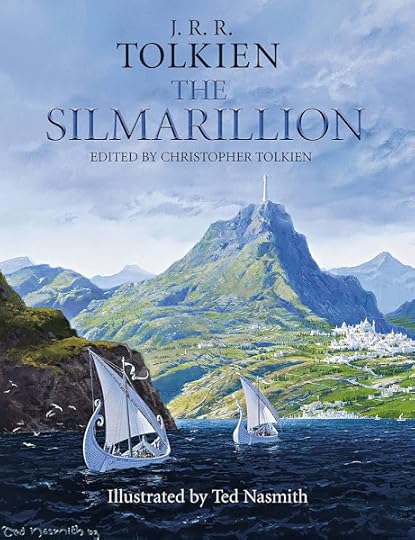 J. R. R. Tolkien: The Silmarillion. Illustrated by Ted Nasmith (2004)
J. R. R. Tolkien: The Silmarillion. Illustrated by Ted Nasmith (2004)•
Curiously enough, I had much the same experience recently comparing two different illustrated texts of Tolkien's masterpiece, The Lord of the Rings.
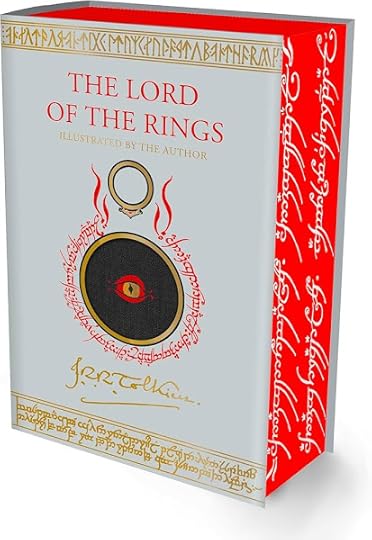 J. R. R. Tolkien: The Lord of the Rings. Illustrated by the author (2021)
J. R. R. Tolkien: The Lord of the Rings. Illustrated by the author (2021)On the one hand, there's this sumptuous new hardback edition, with illustrations culled from the author's papers, which I purchased when it first came out in 2021. I mean, what reasonable person could resist the temptation of owning "the complete text printed in two colors, plus sprayed edges and a ribbon bookmark"?
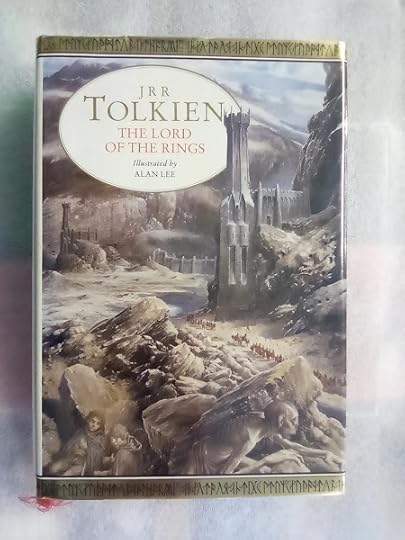 J. R. R. Tolkien: The Lord of the Rings. Illustrated by Alan Lee (1991)
J. R. R. Tolkien: The Lord of the Rings. Illustrated by Alan Lee (1991)But then, on the other hand, there's this thirty-year old veteran I picked up second-hand a couple of months ago, with illustrations that now look rather prophetic of much of the visual imagery of the feature films.
Not, perhaps, that that's all that surprising when you consider that Alan Lee (together with Canadian illustrator John Howe) was one of the two main concept designers on The Lord of the Rings trilogy (2001-03) - as well as working on its prequel, The Hobbit (2012-14).
There's never a shortage of arguments for getting new books, unfortunately - it's persuading yourself that you can jettison some, or (better still) not buy them in the first place, which is hard.
•
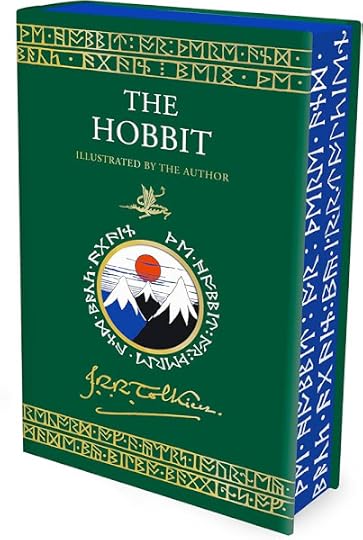 J. R. R. Tolkien: The Hobbit. Illustrated by the author (2023)
J. R. R. Tolkien: The Hobbit. Illustrated by the author (2023)I'm not falling for this one, though. I can promise you that! I mean, who needs it? I already own a nice old hardback copy of the original edition, which was already "illustrated by the author":
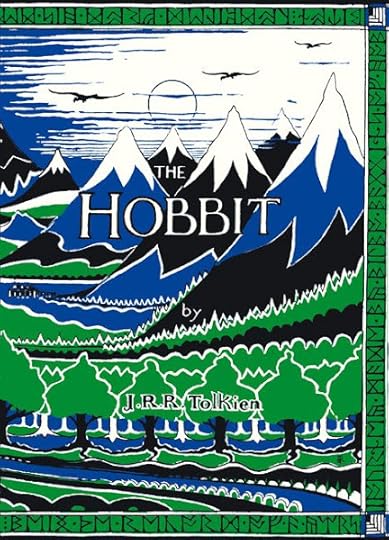 J. R. R. Tolkien: The Hobbit (1937 / 1974)
J. R. R. Tolkien: The Hobbit (1937 / 1974)And, if that's not enough, I also have copies of the two books below which (between them) surely provide more Hobbit-iana than even the most exigent fan could require:
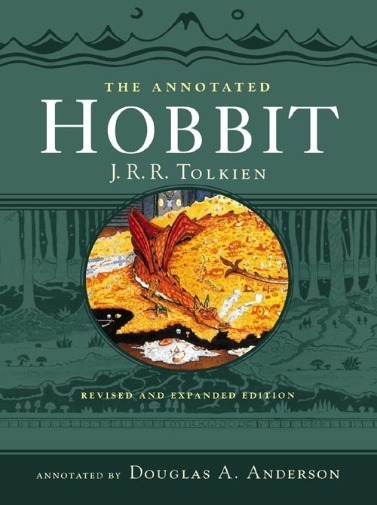 Douglas A. Andersen, ed.: The Annotated Hobbit (1988 / 2002)
Douglas A. Andersen, ed.: The Annotated Hobbit (1988 / 2002)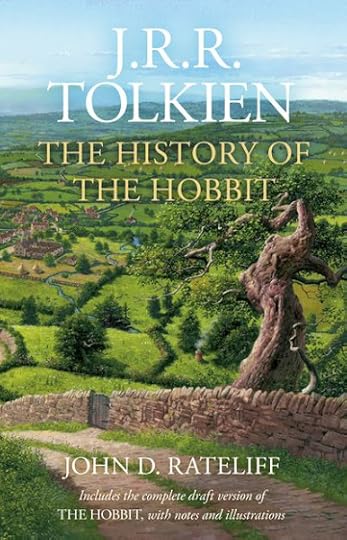 John Rateliff: The History of the Hobbit (2007 / 2011)
John Rateliff: The History of the Hobbit (2007 / 2011)•
What else? Well, there's an intriguing new addition to the Heaney canon, to stand alongside Marco Sonzogni's excellent 2022 edition of The Translations of Seamus Heaney:
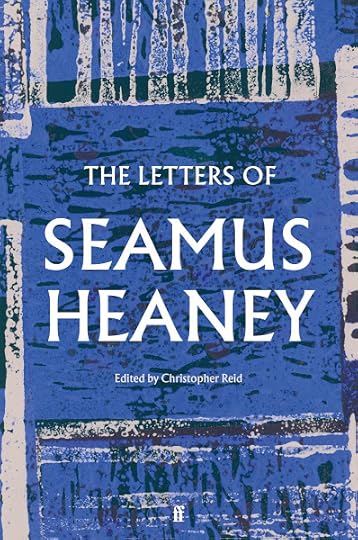 Christopher Reid, ed.: The Letters of Seamus Heaney (2024)
Christopher Reid, ed.: The Letters of Seamus Heaney (2024)There's also the latest Murakami novel, of which I have high hopes after a couple of duds from the Japanese literary superstar:
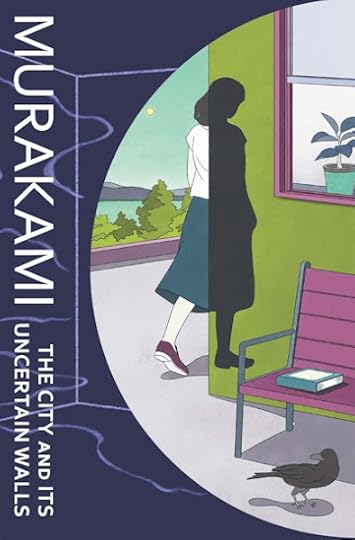 Haruki Murakami: The City and Its Uncertain Walls. Trans. Philip Gabriel (2023 / 2024)
Haruki Murakami: The City and Its Uncertain Walls. Trans. Philip Gabriel (2023 / 2024)•
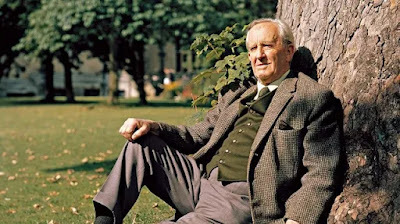 J. R. R. Tolkien (1895-1973)
J. R. R. Tolkien (1895-1973)To return to Tolkien, though ("Tollers" to his friends - just as C. S. Lewis was "Jack" and his brother Major W. H. Lewis "Warnie").
If by any chance you're still having difficulties disentangling the relationships between his various works: the two main ones published during his lifetime - The Hobbit (1937) & The Lord of the Rings (1954-55) - and that other, posthumous compilation - The Silmarillion (1977); together with its myriad supplementary texts - you could certainly do worse than have a quick squiz at the diagram below:
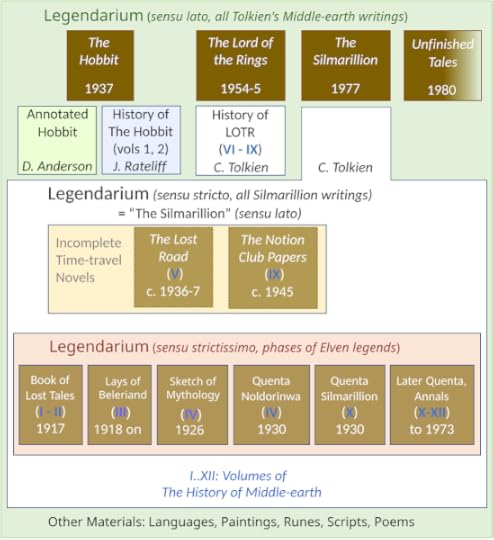 Ian Alexander: Tolkien's Legendarium (2021)
Ian Alexander: Tolkien's Legendarium (2021)Clear as crystal, wouldn't you say? In any case, this is just to wish you all a similarly
MERRY CHRISTMAS
& A Happy New Year
•
Published on December 24, 2024 13:24
December 17, 2024
Was Shakespeare a woman?
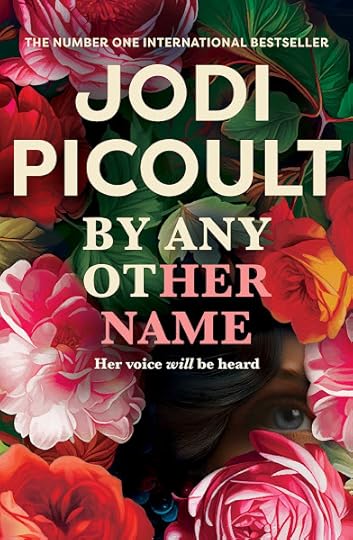 Jodi Picoult: (2024)
Jodi Picoult: (2024)Bronwyn's brother and sister-in-law came to visit us the other day. In the course of a very cordial - and wide-ranging - conversation, my sister-in-law asked me if I thought Shakespeare had really written the plays published under his name. I said that I did. She explained that she'd just finished reading Jodi Picoult's latest novel, which argues otherwise.
I hadn't actually heard of the novel, but what she told us about it did enable me to identify Picoult's principal candidate for authorship of the plays. In fact, I felt quite chuffed to be able to produce my own copy of the book below, A. L. Rowse's edition of The Poems of Shakespeare's Dark Lady, Emilia Lanier.
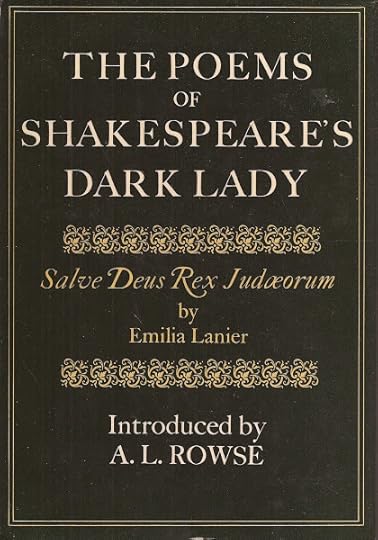 Emilia Lanier: Salve Deus Rex Judæorum (1611 / 1979)
Emilia Lanier: Salve Deus Rex Judæorum (1611 / 1979)Picoult refers to Emilia Lanier under her maiden name, Bassano, but she certainly is the lady in question.
Whether she really was Shakespeare's "dark lady" of the Sonnets, let alone the author of his plays, is of course a matter for speculation, but she was definitely "the first woman in England to assert herself as a professional poet" by publishing the volume above - surely quite an encomium in itself!
It's also, alas - in my view, at least - the biggest stumbling block to Picoult's theory. That is to say, the theory Picoult admits borrowing from journalist Elizabeth Winkler, who argued it in a 2019 essay in the Atlantic, and subsequently in her 2023 book Shakespeare Was a Woman and Other Heresies: How Doubting the Bard Became the Biggest Taboo in Literature .
This hypothesis has now earned its own Wikipedia page: "The Emilia Lanier theory of Shakespeare authorship", which traces the idea back to John Hudson's article "Amelia Bassano Lanier: A New Paradigm", in the anti-Stratfordian journal The Oxfordian, 11 (2009).
•
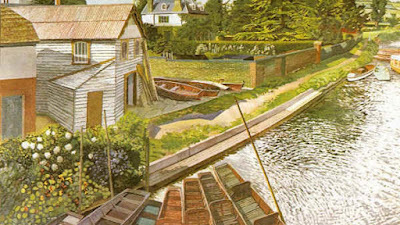 Stanley Spencer: View from Cookham Bridge (1936)
Stanley Spencer: View from Cookham Bridge (1936)Let's look at a few lines from Lanier's book, which can be found reprinted in its entirety on the Renascence Editions website. This passage is taken from the description of "Cooke-ham" which concludes her work:
It's not that these verses are bad. On the contrary, they seem to me very accomplished of their kind. They're regularly end-stopped, conventional in metre, and pious in their overall effect.
Farewell (sweet Cooke-ham) where I first obtain'd
Grace from that Grace where perfit Grace remain'd;
And where the Muses gaue their full consent,
I should haue powre the virtuous to content:
Where princely Palate will'd me to indite,
The sacred Storie of the Soules delight.
Farewell (sweet Place) where Virtue then did rest,
And all delights did harbour in her breast:
Neuer shall my sad eies againe behold
Those pleasures which my thoughts did then vnfold:
Yet you (great Lady) Mistris of that Place,
From whose desires did spring this worke of Grace;
Vouchsafe to thinke vpon those pleasures past,
As fleeting worldly Ioyes that could not last:
Or, as dimme shadowes of celestiall pleasures,
Which are desir'd aboue all earthly treasures.
The fact that the book they come from was published in 1611 does not mean that they were actually written then, but there is a sense in which they belong to a tradition of writing which predates even the first publications of - let's refer to him/her as [Shakespeare] from now on, given the identity questions which continue to bedevil ... them.
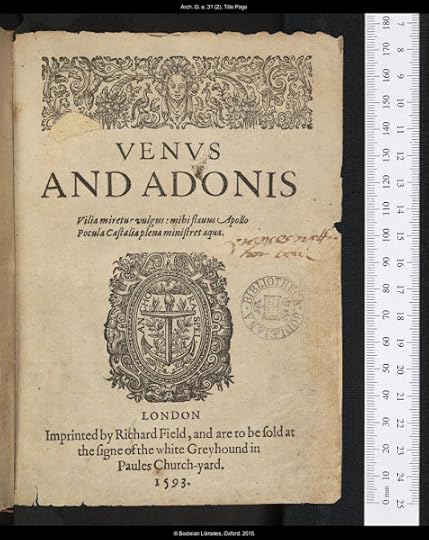 William Shakespeare: Venus and Adonis (1593)
William Shakespeare: Venus and Adonis (1593)Here are the opening lines of Venus and Adonis, first published in 1593, some twenty years before the appearance of Lanier's book:
Even as the sun with purple-colour'd faceEven in this most conventional of [Shakespeare]'s early publications - probably the closest in style to Emilia Lanier's set-piece poems - we note the rhythmic variety ("Hunting he loved, but love he laugh'd to scorn"), and galloping energy of the lines ("The field's chief flower, sweet above compare, / Stain to all nymphs, more lovely than a man"). They could, I suppose, have been written by the same hand, but it doesn't seem very likely to me.
Had ta'en his last leave of the weeping morn,
Rose-cheek'd Adonis hied him to the chase;
Hunting he loved, but love he laugh'd to scorn;
Sick-thoughted Venus makes amain unto him,
And like a bold-faced suitor 'gins to woo him.
'Thrice-fairer than myself,' thus she began,
'The field's chief flower, sweet above compare,
Stain to all nymphs, more lovely than a man,
More white and red than doves or roses are;
Nature that made thee, with herself at strife,
Saith that the world hath ending with thy life.
•
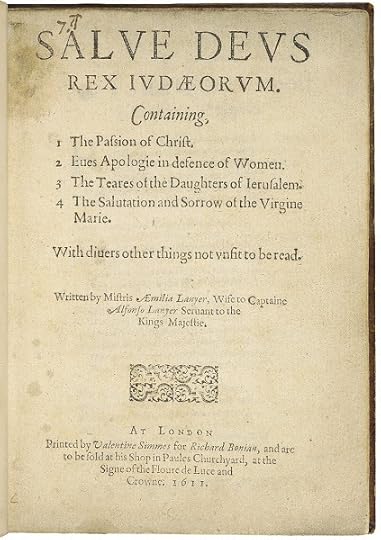 Emilia Lanier: Salve Deus Rex Judæorum (1611)
Emilia Lanier: Salve Deus Rex Judæorum (1611)Moving forward to 1611, the date of Salve Deus Rex Judæorum - what was happening in actor / producer William Shakespeare's life then? It's the year he retired from London and the life of the theatre to return to his roots in Stratford-on-Avon. So what did the writing produced by [Shakespeare] in that year sound like?
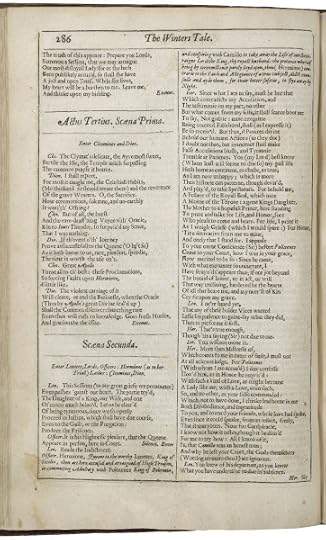 William Shakespeare: The Winter's Tale (First Folio, 1623)
William Shakespeare: The Winter's Tale (First Folio, 1623)Here's a passage from The Winter's Tale , one of [Shakespeare]'s "late Romances", which can either be seen as a retreat from the great tragedies of the early Jacobean period - or, alternatively, as a step on from them into a sense of balance and forgiveness of human frailty. The speaker here is the play's chorus, Time:
Like Emilia Lanier's poem about Cookham, this one is written in rhyming pentameters - or heroic couplets, as they're commonly known. There, however, the resemblance ends. Even at their simplest, as here, [Shakespeare]'s verses are distinguished by complex, at times almost baffling, syntax, together with flights of linguistic derring-do.
I, that please some, try all — both joy and terror
Of good and bad, that makes and unfolds error —
Now take upon me, in the name of Time,
To use my wings. Impute it not a crime
To me or my swift passage that I slide
O’er sixteen years, and leave the growth untried
Of that wide gap, since it is in my power
To o’erthrow law and in one self-born hour
To plant and o’erwhelm custom. Let me pass
The same I am ere ancient’st order was
Or what is now received. I witness to
The times that brought them in. So shall I do
To th’ freshest things now reigning, and make stale
The glistering of this present, as my tale
Now seems to it. Your patience this allowing,
I turn my glass and give my scene such growing
As you had slept between ...
Once again, it's not absolutely impossible that the author of these lines also authored the poems in Salve Deus Rex Judæorum, but if so the latter must have been early experiments - perhaps an adolescent's first attempts at formal verse. It's as close to impossible as makes no matter when you consider the sheer extent of Lanier's book, though. Who on earth would authorise such a publication at such a late stage in their literary career? And if it was unauthorised, why was she so keen to promote it?
If you have a tin ear for verse, which appears to be the case with most anti-Stratfordians (the collective noun for all the various sectaries who doubt Shakespeare was [Shakespeare] - instead favouring a bewildering list of some 80+ other candidates), I suppose that one set of heroic couplets sounds much like another. It doesn't really matter to you whether they were written by [Shakespeare], Jonson, Dryden, or even Alexander Pope. I imagine it's a bit like being tone-deaf in music.
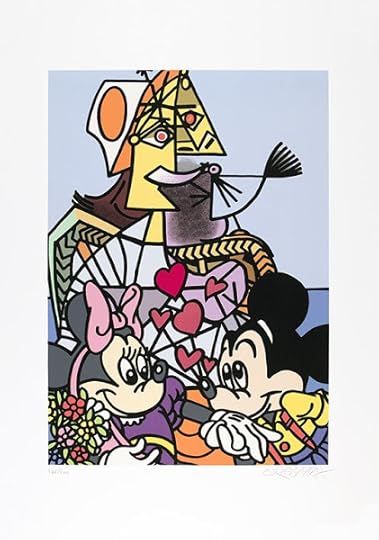 Erró: Homage to Picasso (1998)
Erró: Homage to Picasso (1998)Of course I can't simply ask you to take my word for it, but imho, it's about as likely that the poet of Salve Deus Rex Judæorum wrote the surviving corpus of [Shakespeare]'s works, as that Picasso secretly designed the early Mickey Mouse cartoons: the clash in style and tone is as blatant as that. On the one hand, Steamboat Willie ; on the other, Guernica . Both very good of their type, mind you - but, well, different.
•
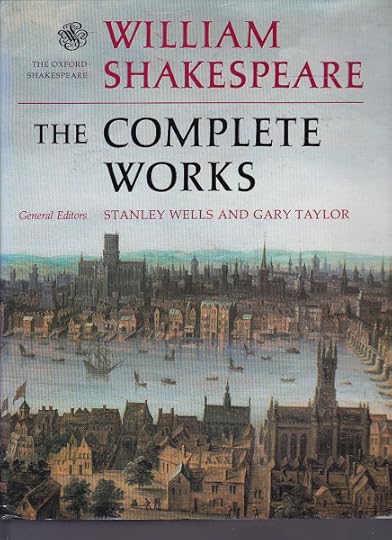 William Shakespeare: The Complete Works. Ed. Gary Taylor & Stanley Wells (1986)
William Shakespeare: The Complete Works. Ed. Gary Taylor & Stanley Wells (1986)It's salutary to note, though, that even the most belaurelled experts can get it wrong. In 1986, prominent Shakespearean Gary Taylor announced his conviction that a poem ascribed to Shakespeare in a manuscript collection of verses probably written in the late 1630s was indeed an authentic addition to the canon. He and his co-editor Stanley Wells therefore decided to include "Shall I die?" in the New Oxford Shakespeare, their revisionist edition of the Complete Works of [Shakespeare].
Judge for yourself:
Whatcha reckon? I remain unconvinced, I'm afraid. If [Shakespeare] did write it, then it must have been during some drunken game of Bouts-rimés at the Mermaid Tavern. It's certainly no adjunct to the bard's diadem: 90 lines of pointless rhyming signifying next-to-nothing.
Shall I die? Shall I fly
Lover's baits and deceits
sorrow breeding?
Shall I tend? Shall I send?
Shall I sue, and not rue
my proceeding?
In all duty her beauty
Binds me her servant for ever.
If she scorn, I mourn,
I retire to despair, joining never.
[and so on in the same vein for another eight 10-line stanzas] ...
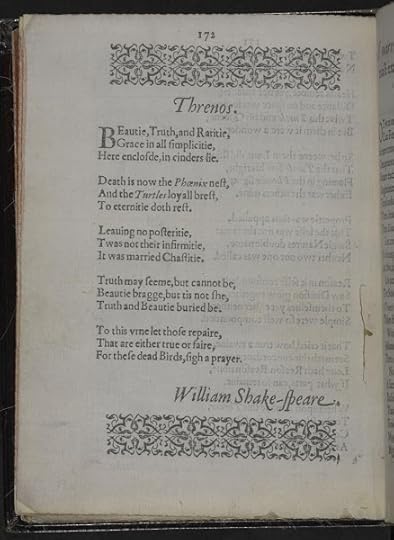 William Shakespeare: The Phoenix and the Turtle, 1601 (2nd ed., 1611)
William Shakespeare: The Phoenix and the Turtle, 1601 (2nd ed., 1611)I suppose Taylor may have been inspired by some fancied resemblance to the clearly genuine "Phoenix and the Turtle" (1601):
Once again, it's chalk and cheese, I'm afraid. [Shakespeare]'s knotty rhymes foreshadow the kinds of paradoxical reasoning familiar to us from the work of such metaphysical poets as John Donne and Andrew Marvell. The lines are both marvellously intricate in style, and deceptively complex in their implications.
Beauty, truth, and rarity,
Grace in all simplicity,
Here enclos'd, in cinders lie.
Death is now the Phoenix' nest,
And the Turtle's loyal breast
To eternity doth rest,
Leaving no posterity:
'Twas not their infirmity,
It was married chastity.
Truth may seem but cannot be;
Beauty brag but 'tis not she;
Truth and beauty buried be.
To this urn let those repair
That are either true or fair;
For these dead birds sigh a prayer.
"Shall I die?", by contrast, is as about as closely argued as "Rock around the Clock" - far less lyrically interesting than Richard Berry's "Louie, Louie", in any of its various versions. But there you go. Great scholar he may be, but it turns out that Gary Taylor has no ear for verse. "It's not a sin" - as an old TV toothpaste jingle familiar to me in youth was wont to assert - "it's how you grin!"
•
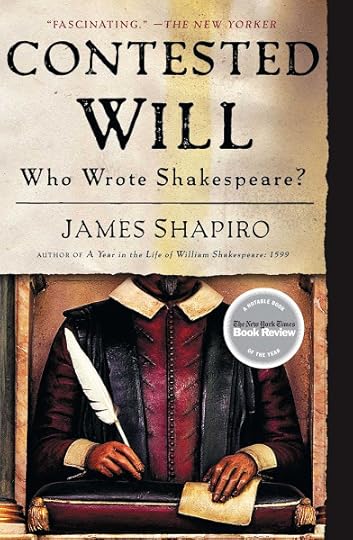 James Shapiro: Contested Will: Who Wrote Shakespeare? (2010)
James Shapiro: Contested Will: Who Wrote Shakespeare? (2010)In a previous post on the (fictional) debate between C. S. Lewis and Sigmund Freud on the probability of the existence of God in the 2024 movie Freud's Last Session, I mentioned Scottish historian and philosopher David Hume's blunt claim about miracles:
No testimony is sufficient to establish a miracle unless it is of such a kind that its falsehood would be more miraculous than the fact that it tries to establish.One could perhaps rephrase this axiom more simply as "extraordinary claims require extraordinary evidence", a pithy restatement of Pierre-Simon Laplace's principle that “the weight of evidence for an extraordinary claim must be proportioned to its strangeness.”
Hume's point is that it's always more probable that the witnesses to an apparent "miracle" were mistaken - or lying - than that the laws of nature were suddenly suspended at that particular place and time.
Did the sun "stand still over Gibeon" when Joshua asked God to suspend the rotation of the earth so that the children of Israel could complete yet another massacre of their enemies (Joshua 10:12-14)? I don't know. I wasn't there. But neither were you, so if you assert that it did, then the burden of proof is on you. Q.E.D.
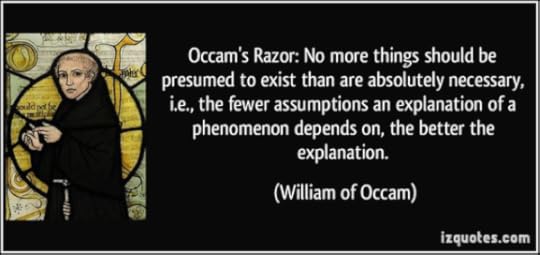 Occam's Razor
Occam's RazorAnother version of this is the famous "Occam's Razor". The original principle argued by 14th-century English monk William of Ockham was (more or less): " Entia non sunt multiplicanda praeter necessitatem ' [Entities must not be multiplied beyond necessity]. This is often paraphrased as "The simplest explanation is usually the best one."
Devotees of secret conspiracies and hidden knowledge are quick to point out that the simplest explanation is not always correct. And of course they're quite right. The popularity of Occam's razor - and the reason that it forms the basis for all scientific method - comes from the fact that you have to begin your investigations somewhere: and the most obvious place is generally the best place to start.
•
 The Many Faces of William Shakespeare:
The Many Faces of William Shakespeare:l-to-r: the Cobbe portrait (1610), the Chandos portrait (early 1600s), & the Droeshout portrait (1622)
Perhaps a more interesting question than "Was Shakespeare a woman?" [or Sir Francis Bacon - or Christopher Marlowe - or the Earl of Oxford - or ... the list goes on and on], then, is "Why do so many people feel the need to dispute that the well-known theatre professional whose name is so clearly printed on the titlepage of his works was actually their author?"
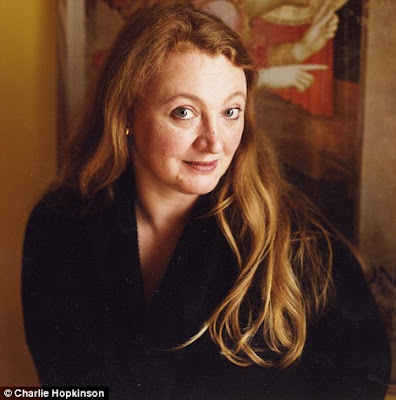 Charlie Hopkinson: Amanda Craig (1959- )
Charlie Hopkinson: Amanda Craig (1959- )British novelist Amanda Craig, in her rather acerbic of Jodi Picoult's By Any Other Name, is in little doubt of the answer:
The conviction that Shakespeare wasn’t posh or pretty enough to have written Shakespeare is a favourite joke to those who satirise conspiracy theorists.Posh, yes. Most of the arguments against the "Stratfordian" being the real Slim Shady boil down to ill-concealed sneers at his lack of breeding, social status, or a university education. And yet there's little in William Shakespeare's background which differs substantially from that of other contemporary playwrights such as the bricklayer Ben Jonson or the shoemaker's son Christopher Marlowe.
Not pretty enough? Well, that's what really gets Craig going:
One problem is that Picoult’s Tudor heroine is basically a 21st-century American feminist who notices “pops of colour”, but nothing about the human condition. One never feels the roil of a gifted writer’s language, observation and ideas ... Nothing explains how or why Shakespeare’s work became a mirror in which we each see our own selves.But surely Picoult's playful thought experiment could still yield some useful ideas about female empowerment? What's wrong with giving the patriarchy a bit of a jolt from time to time? Craig apparently thinks otherwise:
Had this novel’s 500-plus pages been ruthlessly edited, it might have been a diverting romp. As it is, the modern-day parts of By Any Other Name add nothing but polemic. Like Emilia, modern Melina hides her work, in her case behind the identity of her gay Black best friend, leading to predictable professional and romantic complications. In Tudor England, Emilia’s life has a more compelling arc. Sold as a concubine at 13, conducting a passionate affair with Lord Southampton, forcibly married to the abusive Alphonso Lanier, she has a son, fights off the plague, and writes sublime plays and sonnets before dying in obscurity.Ouch! One can't help wondering if Amanda Craig would trade her own position as a respected Guardian critic and well-regarded middle-brow novelist for some small percentage of those 40 million sales per title. I suspect she would. You'd have to be crazy not to, really ...
If [the theory that Shakespeare was a woman] helps to combat the sexism that has serious female authors fighting not to have headless torsos in pink on our jackets, it is welcome. However, anyone who writes such sentences as “she drank from him as if he were an elixir” has not, perhaps, read even their own work attentively.
Picoult’s descriptions of Emilia’s silver eyes, clothes and orgasms plus her campaigning sense of social justice and propulsive storytelling are why she sells 40m copies worldwide ... Commercial or literary? Only a genius gets to be both.
What Craig seems to resent most is Jodi Picoult's usurpation of the underdog role in this conversation:
In 2010, the bestselling American novelist Jodi Picoult complained that her work was suffering from sexism. Her 30 novels address weighty subjects from gay rights to gun control, and if they were written by an author such as Jonathan Franzen or Jeffrey Eugenides, she believed they would not be perceived as beach reads.But, counters Craig, Picoult is not writing "the same kind of fiction as Eugenides or Franzen." They may not aspire to "genius", but they are - in Craig's view, at least - better writers than Picoult is. It's not because they're men that they get critical attention (look at Margaret Atwood, look at Ursula Le Guin), it's because they write books that demand such scrutiny.
In short, Craig concludes, content yourself with those mega-sales and your status as a worldwide literary superstar, and let posterity sort out whether or not you've written anything that will survive you.
•
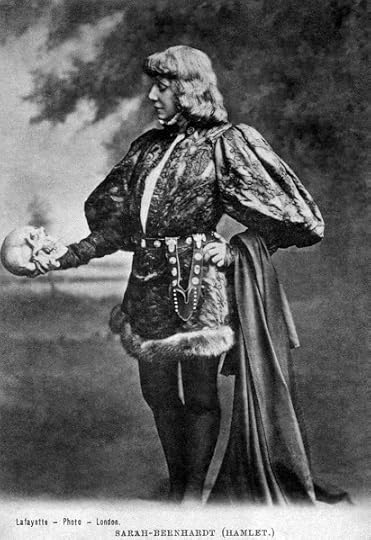 Sarah Bernhardt as Hamlet (1899)
Sarah Bernhardt as Hamlet (1899)But is all there is to it? Is it just snobbery and sexism which explains the continuing vogue of what Wikipedia coyly refers to as the "Shakespearean authorship question"?
Kingsley Amis's bitterly satirical novel Jake's Thing anticipated a number of the points raised by Picoult's book some half a century ago. In particular, he clearly foresaw - or already found himself living in - the world of "alternate facts" which we now definitively inhabit. It doesn't really matter what evidence you have for a thing - whether it makes sense or not. What matters is that you believe it.
There's a rather telling scene in his book where two curmudgeonly old Oxford Dons are discussing the kinds of things students get up to nowadays. The English literature professor, Lancewood, mentions that one of his female students unveiled an interesting hypothesis the day before: Hamlet was a woman.
'Even I know that's not very new,' said Jake [who teaches Ancient History]. 'Didn't Sarah Bernhardt play him, or her?'
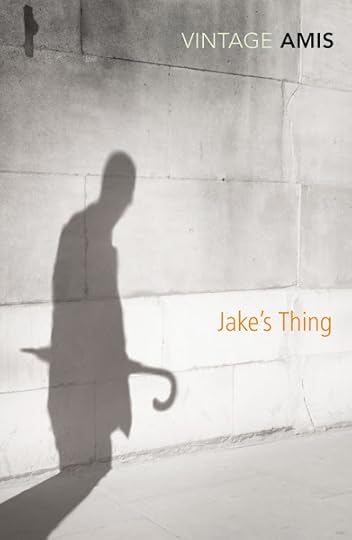 Kingsley Amis: Jake's Thing (1978)
Kingsley Amis: Jake's Thing (1978)But Jake has missed the point. Not that Hamlet can be played by a woman, but that "since Hamlet is far too nice and intelligent to be a man, he must be a woman because there's nothing else for him to be."
Lancewood continues:
I was ready to come back smartly with what about the way he treats Ophelia, male chauvinism if there ever was such a thing, but she'd thought of that - that was how all the men went on in those days, still do really, and it would have been suspicious if she, Hamlet, had behaved differently. What about old Hamlet and Gertrude? - you'd have expected them to notice. Old Hamlet had noticed, but he needed an heir, so he got Polonius to rig things, which gave Polonius the leverage he needed to be kept on at court when all he was fit for was talking balls ...That is the terrifying thing. Not the actual theory that Hamlet is a woman - that's rather fun. And you can hear the two old pricks sounding more and more interested by what you could do with an idea like that as they go along.
I shouldn't be going on like this because it'll only feed your prejudices, but, well, I said, what about the rest of the play, there's nothing in it that suggests that things are any different from what they seem. She didn't know about that, she said; she thought Hamlet was a woman.
What she also thought, in a different sense, was that Hamlet was a woman in some other ... realer sphere than the play or Shakespeare's sources or anything that might historically have taken place at Elsinore or any other actual spot. Some third domain beyond fiction or fact. That's the terrifying thing.
It's never exactly an easy proposition, but if you can set aside for a moment Kingsley Amis's characteristic sneering condescension towards women and, well, the young in general, his exposition of the "Hamlet is a woman" hypothesis really does repay a little scrutiny.
Both Hume's theory of miracles and Occam's razor presuppose a world where people think it important to gather persuasive evidence to substantiate their ideas. Once you throw that antiquated notion out of the window, though, your horizons open up considerably.
You can say anything! You don't need to prove it, just assert it. And if you can find somebody famous who thinks the same thing, well, that just confirms it. It doesn't matter what they're famous for - just that they're click-bait of some sort.
•
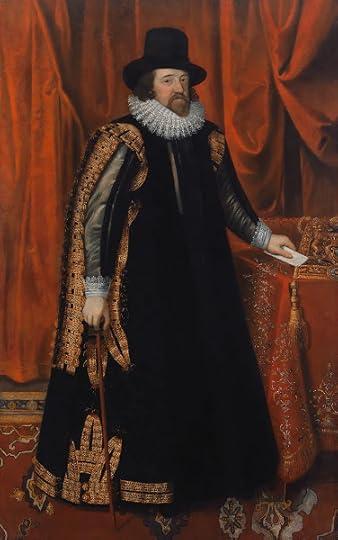 Sir Francis Bacon (1561-1626)
Sir Francis Bacon (1561-1626)Let's take as a test-case the idea that Francis Bacon wrote the works of [Shakespeare]. The long lists of luminaries who have (allegedly) agreed with the Baconian theory at one time or another would stagger you: they include Isaac Asimov, Friedrich Nietzsche, Mark Twain, and a variety of other wiseacres.
And yet, have you ever read any of the works of Sir Francis Bacon? One problem is that there are so many of them. As well as conducting an active political career, he was also an experimental scientist and philosopher and wrote a large number of published works in each of these areas - as well as a massive corpus of letters and notebooks. How could he have had time to write all of [Shakespeare]'s almost equally voluminous corpus as well?
There's also the problem that none of his other works sound even in the slightest bit like [Shakespeare]. Try them. Sit down this minute and start reading The Advancement of Learning (1605), or The New Atlantis (1626), or even his alltime bestseller The Essays (1597-1625). Is there any resemblance in style between them and [Shakespeare]'s poetry or plays? No? How surprising!
Unfortunately for the Baconians, their hero, like most of his contemporaries, wrote some verse of his own. Prominent nineteenth-century literary scholar Sir Sidney Lee concluded: "such authentic examples of Bacon's efforts to write verse as survive prove beyond all possibility of contradiction that, great as he was as a prose writer and a philosopher, he was incapable of penning any of the poetry assigned to Shakespeare."
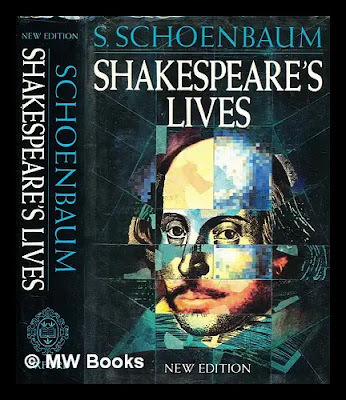 Samuel Schoenbaum: Shakespeare's Lives (1970 / 1991)
Samuel Schoenbaum: Shakespeare's Lives (1970 / 1991)So where did the idea come from in the first place? Well, Baconians are understandably anxious to play down the fact, but the chief proponent and prophet of their theory was a rather eccentric American writer called Delia Bacon (no relation). You can read more about her in the book pictured above, Samuel Schoenbaum's invaluable compendium of three centuries of Shakespeare biography, Shakespeare's Lives.
Delia Bacon's sole research trip to England to test her hypotheses on the spot ended somewhat inconclusively:
In 1853, with the help of Ralph Waldo Emerson, Delia Bacon travelled to England to search for evidence to support her theories. Instead of performing archival research, she sought to unearth buried manuscripts, and unsuccessfully tried to persuade a caretaker to open Bacon's tomb. She believed she had deciphered instructions in Bacon's letters to look beneath Shakespeare's Stratford gravestone for papers that would prove the works were Bacon's, but after spending several nights in the chancel trying to summon the requisite courage, she left without prising up the stone slab.Those nights hiding in the church at Stratford appear to have taken a toll on her health, however:
Delia Bacon died in 1859, having in 1858 been placed by her family in the care of a lunatic asylum at Hartford, Connecticut. According to her nephew, Theodore Bacon, she had been seized by a "violent mania" while in England, and had been "removed to an excellent private asylum for a small number of insane persons" at Henley-in-Arden, Warwickshire, before being brought back to America.To do her justice, Delia Bacon's Shakespearean authorship theory did involve a syndicate of prominent Elizabethan writers, helmed by Sir Francis Bacon, but also including Sir Walter Raleigh and Edmund Spenser, each of whom provided particular sections of the plays ... for various nebulous reasons to do with Francis Bacon's status as the unacknowledged son and heir of Elizabeth 1st, among other things.
The second great proponent of Baconian theory was a certain Ignatius L. Donnelly, whose book The Great Cryptogram: Francis Bacon's Cipher in Shakespeare's Plays (1888) popularised the idea of finding encrypted messages in the First Folio of [Shakespeare]'s works, as well as the various quarto editions of individual plays which preceded it. Donnelly is, of course, better known for his contributions to the burgeoning fields of pseudoscience and pseudohistory, which included the still popular Atlantis: The Antediluvian World (1882), which argued that all known ancient civilizations were descended from this high-Neolithic culture.
One begins to see the relevance of Amis's comment about "some third domain beyond fiction or fact", where anything can be asserted by anyone without blame or consequences. And that, I'm afraid - along with Area 51, the Loch Ness monster, posthumous sightings of Elvis Presley, and other old chestnuts - seems to me an appropriate place to shelve the [Shakespeare]-wasn't-Shakespeare controversy.
Extraordinary claims require extraordinary evidence: so far no actual proof of any kind has been forthcoming. And that's despite repeated rummaging through sites clearly indicated by encoded documents: the bed of the River Wye near Chepstow Castle; behind the panels of Canonbury Tower in Islington; even in the tomb of the poet Edmund Spenser in Westminster Abbey (nothing was found there, astonishingly, but "some old bones").
It's fine to live in hope - but probably best, eventually, to come back down to earth.
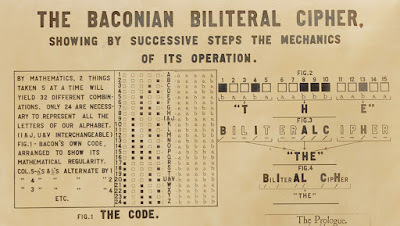 The Baconian Biliteral Cipher (1916)
The Baconian Biliteral Cipher (1916)•
Published on December 17, 2024 11:47
December 11, 2024
Redology
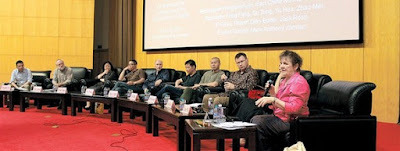
Xu Qin: "Story event a tale of literary exploration" (24/7/16)
When I attended an international Short Story Conference in Shanghai in 2016, I was asked to take part in the opening plenary session. Heaven knows why! I suspect it may have had something to do with the fact that they'd never had any New Zealanders attending their celebrations before ...
There I am above, a couple of seats from the right end of the row.
At one point the moderator enquired if any of us Westerners had been influenced by Chinese models in our own writing. I replied: "Yes, I have - by the Chinese novel."
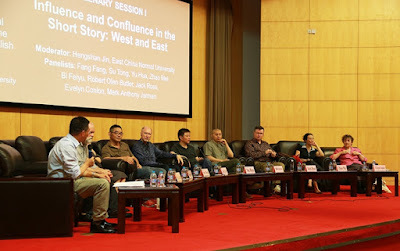
JR being quizzed on the Chinese novel
Was I right to detect a little scepticism in his voice when he asked me just how I'd been affected by Chinese fiction?

JR attempts to explain his love for the traditional Chinese novel
I learned very early in my Academic career never to lie about having read something if you haven't actually done so. Once or twice I've fallen into one of those awkward situations where everyone assumes that you, too, have read a book just because the discussion's moved onto it - but even then I find it's best to break in at some point and confess your ignorance.
So, while I don't speak or read Chinese, and therefore have no direct knowledge of Chinese literature beyond my extensive reading of translations, I don't really think that there's much on the great classic Chinese novels in English which I haven't pored over at one time or another.
 Cao Xueqin: Hung Lou Meng: The Story of the Stone (5 vols: 1973-86)
Cao Xueqin: Hung Lou Meng: The Story of the Stone (5 vols: 1973-86)In particular, I wrote an essay, "In Love with the Chinese Novel: A Voyage around the Hung Lou Meng", which appeared in brief 37 (2009), after being long-listed for the Landfall Essay Prize. I've also put up a number of posts on the Four Great Classical Chinese Novels on this blog at various times.
I didn't have time to go into all that in my remarks at the conference. But I did try to explain my fascination with the structural methods used by the Old Masters who wrote - or compiled - the traditional Chinese novels: in particular their use of self-contained, short-story-like chapters to build up their immense fictional structures.
Among other things, I mentioned that I first started reading the Hung Lou Meng, or "Red Chamber Dream" - in translation - when I bought a second-hand copy of the first volume of the complete Beijing Foreign Languages Publishing House version as a teenager in the late 1970s. 3 November 1979 is the date I find written on the flyleaf of the book, which I still own ...
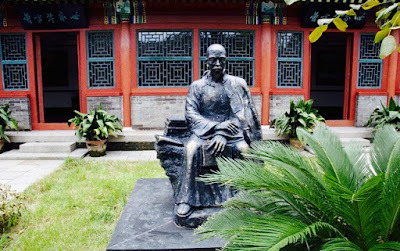
Cao Xueqin, author of the Hung Lou Meng (c.1715-1764)
While I meant nothing but the profoundest respect for the genius of Cao Xueqin and his great novel with these remarks, they do appear to have given offence. A couple of days later I was chairing a session which included one of the numerous well-known Chinese writers who attended the conference. His English was not good, but his translator conveyed a few comments of his à propos of the Hung Lou Meng and the impossibility that any non-Chinese speaker could ever possibly understand it.
In particular, he mentioned that he'd just finished reading it for the first time, in his mid-forties, and doubted that an adolescent could appreciate its emotional and cultural complexities - any claim to have read it at such a young age was clearly mendacious.
We'd already strayed past the end of our allotted time, and while it was fairly apparent that his comments were mostly directed at me, I had to let them go unchallenged. I've thought quite a lot about what he had to say since, though.
Mainly because I agree with him. Of course I have no claim to understand the Hung Lou Meng. I didn't when I first encountered it, and I don't now. But I have read both of the complete English translations several times, as well as various abridgements and commentaries. All that would have to be seen as analogous with reading Dante or Shakespeare in translation, though: something of the drama may come across, but virtually none of the actual poetry.
My riposte to him, however, would have been that he himself was ready enough to cite Chekhov and Mansfield and other writers whom he'd only encountered in translation. How is that different from my own attempts to glean something of the original Hung Lou Meng through these artful and erudite translations? Did he grudge me that? In a weird way, I felt he was almost jealous of the amount of time I'd spend reading this novel. I was seventeen when I bought my first copy. It's never really been out of my mind since.
It was as if it had been such a great experience for him to read it, that he hated the thought that anyone else - especially an impudent foreigner - could be allowed to undermine his achievement. That, too, was something I could certainly empathise with. "Been there; done that" is the last thing you want to hear about such a profoundly life-changing moment.

Cao Xueqin Memorial, Beijing
•
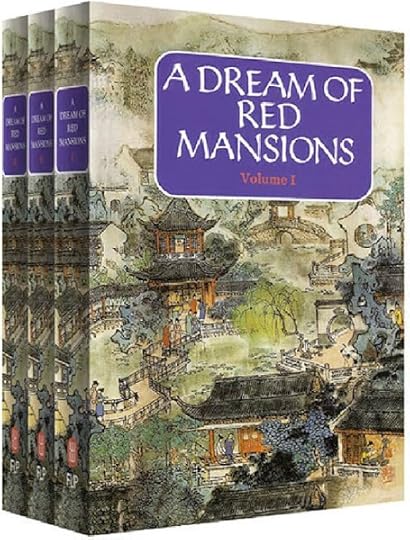 Cao Xueqin: Hung Lou Meng: A Dream of Red Mansions (3 vols: 1978-80)
Cao Xueqin: Hung Lou Meng: A Dream of Red Mansions (3 vols: 1978-80)[Books I own are marked in bold]:
Tsao Hsueh-Chin & Kao Ngo. A Dream of Red Mansions. Trans. Yang Hsien-Yi & Gladys Yang. 3 vols. Peking: Foreign Languages Press, 1978-80.
Redology, according to Wikipedia, is:
the academic study of Cao Xueqin's Dream of the Red Chamber, one of the Four Great Classical Novels of China. There are numerous researchers in this field; most can be divided into four general groups: the first group are the commentators, ...; the second group is the index group, ...; the third group are the textual critics, ...; the final group are the literary critics.
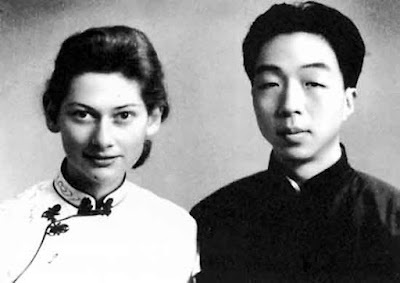 Gladys Taylor & Yang Xianyi (Chongoing, 1941)
Gladys Taylor & Yang Xianyi (Chongoing, 1941)The first of the two major English translations of this work, begun in 1961 and published in three volumes from 1978 to 1980, was by Yang Xianyi & Gladys Yang, whose names can be found on the title-pages of a great many of the - then Peking, now Beijing - Foreign Languages Press editions of classic Chinese texts.
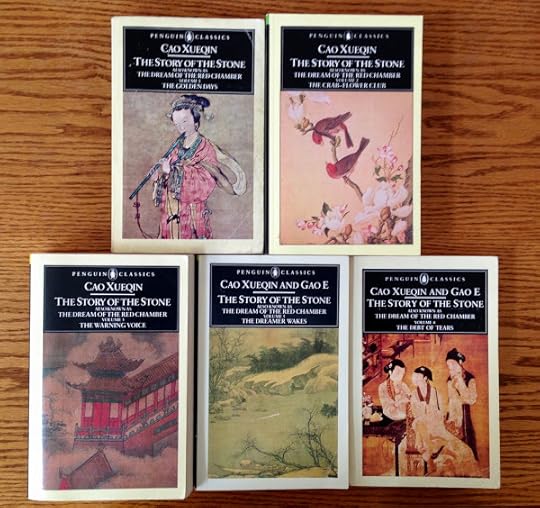 Cao Xueqin: The Story of the Stone (1973-86)
Cao Xueqin: The Story of the Stone (1973-86)Cao Xueqin. The Story of the Stone: A Chinese Novel by Cao Xueqin in Five Volumes. Trans. David Hawkes. Penguin Classics. Harmondsworth: Penguin, 1973-80.Vol. 1: The Golden Days (1973)Vol. 2: The Crab-Flower Club (1977)Vol. 3: The Warning Voice (1980) Cao Xueqin & Gao E. The Story of the Stone (Also Known as The Dream of the Red Chamber): A Chinese Novel by Cao Xueqin in Five Volumes, edited by Gao E. Trans. John Minford. Penguin Classics. Harmondsworth: Penguin, 1982-86.Vol. 4: The Debt of Tears (1982)Vol. 5: The Dreamer Wakes (1986)
The second was also a joint effort, composed in close collaboration by two British-born academics, David Hawkes and his son-in-law John Minford, who worked on it - together and apart - over a period of roughly fifteen years. I've made some comments on this version here.
Jean & David Hawkes (Peking, 1951)
 John Minford (Australia, 2015)
John Minford (Australia, 2015)Alongside these two monumental achievements, there are a few other incomplete versions which ought to be acknowledged:
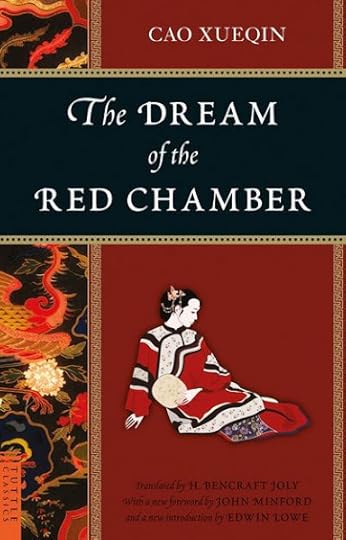 H. Bencraft Joly, trans. The Dream of the Red Chamber (1892-93 / 2010)
H. Bencraft Joly, trans. The Dream of the Red Chamber (1892-93 / 2010)Cao Xueqin. The Dream of the Red Chamber. Trans. H. Bencraft Joly. 1892-93. Foreword by John Minford. Introduction by Edwin Lowe. Tokyo / Rutland, Vermont / Singapore: Tuttle Publishing, 2010.
This was the first real attempt at a full translation into English. Its author, Henry Bencraft Joly (1857-1898), was the British Vice-Consul in Macao, where he finished his version of Chapters 1-56, published in two volumes in 1892-93. In his informative introduction to the 2010 reprint, John Minford is honest both about its merits and its shortcomings:
Bencraft Joly's incomplete translation has the merit of being quite a literal one ... He admits that "shortcomings" will be discovered, "both in the prose, and among the doggerel and uncouth rhymes, in which the text has been more adhered to than rhythm."Minford adds that "one should not be too critical of Joly's refusal to deal with the mildly erotic layer of the novel ... Joly's contemporary Herbert Giles, in translating the Strange Tales from a Chinese Studio of Pu Songling, also bowlderised. They were both creatures of their time."
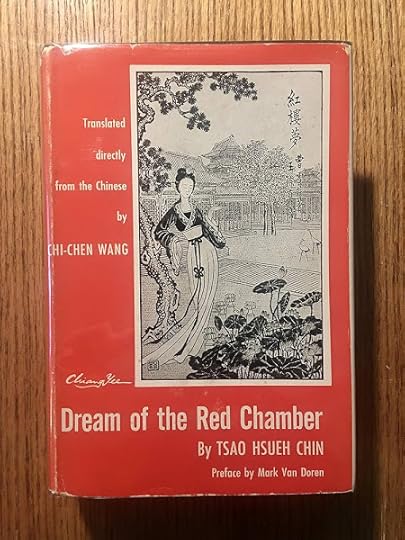 Chi-chen Wang, trans. Dream of the Red Chamber (1929 / 1959)
Chi-chen Wang, trans. Dream of the Red Chamber (1929 / 1959)Tsao Hsueh-Chin. Dream of the Red Chamber. Trans. Chi-chen Wang. 1929. Preface by Mark van Doren. London: Vision Press, 1959.
Wang Chi-chen (1899-2001) revised and enlarged his 1929 abridgement of the novel for the 1959 edition. As he himself explains in his introduction to the new version:
The present translation just about doubles the old one in the actual amount of significant material included, if not in actual number of words ... In my first translation, I took the Dream to be essentially a love story, and omitted many episodes made up of what then seemed to me like trivial details. But I have since come to realize that what Tsao Hsueh-Chin tried to do is to describe the life of a large household and that these "trivial details" are as important to the book as the story of of Pao-yu and Black Jade [Lin Dai-yu]."In general," he concludes. "I have omitted nothing from the first 80 chapters which I consider significant."
In his preface, Mark Van Doren praises Mr. Wang's "admirable style, which is colloquial as that of the original is colloquial, and which does not hesitate to use modern terms in the faith that their equivalent existed in the matchless novel of manners he translates." This slightly barbed encomium would probably be echoed by most modern readers. Wang's version is certainly readable enough, but it's more of an interpretation than an actual translation of the Hung Lou Meng itself, in all its layered detail.
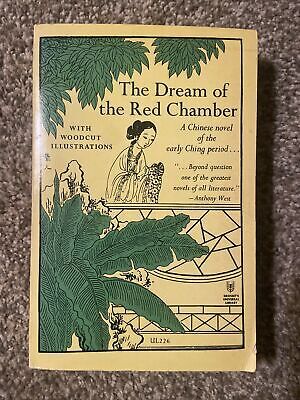 Franz Kuhn, ed. Hung Lou Meng (1958)
Franz Kuhn, ed. Hung Lou Meng (1958)Kuhn, Franz, ed. Hung Lou Meng: The Dream of the Red Chamber – A Chinese Novel of the Early Ching Period. 1932. Trans. Isabel and Florence McHugh. 1958. The Universal Library. New York: Grosset & Dunlop, 1968.
This was an English translation of an abridged German version of the novel. Franz Kuhn (1884-1961) also made translations of other Chinese novels, such as the Ch'in P'ing Mei (1930), which at least filled the gap until more complete translations from the Chinese could be provided.
In his introduction, Kuhn claims of his version that it "presents about five-sixths of the original ... Though my translation is not a complete one, I may still claim to be the first Westerner to have made acessible the monumental structure of the Hung Lou Meng. My version gives a full rendering of the main narrative, which is organised around the three figures of Pao Yu, Black Jade [Dai-yu] and Precious Clasp [Bao-chai]."
It's a little difficult to see how he arrives at that estimate of "five-sixths of the original", but his version remains a convenient one for those unwilling to undertake the full adventurous journey through the novel itself.
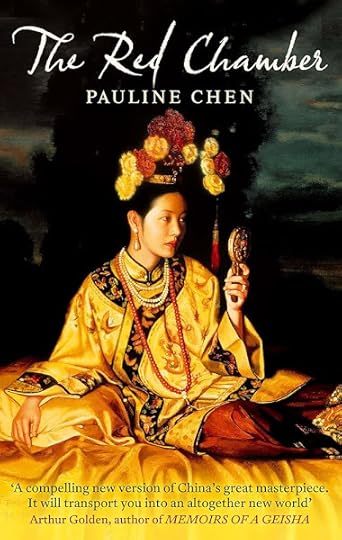 Pauline Chen: The Red Chamber (2012)
Pauline Chen: The Red Chamber (2012)Pauline Chen. The Red Chamber. Virago Press. London: Little, Brown Book Group, 2012.
There's something rather cunning about the idea of adapting the Hung Lou Meng into a more conventional modern historical romance, centred around the fateful love story between Lin Dai-yu and Jia Bao-yu. Pauline A. Chen certainly has strong qualifications for the task.
The American-born daughter of Taiwanese parents, she completed her PhD in East Asian Studies at Princeton, focussing on pre-modern Chinese poetry. She is now a Professor of Chinese language and literature in Ohio. She comments in the author's note to her novel:
Cao's masterpiece is largely unknown to Western audiences, perhaps due to its daunting length (2,500 pages) and complex cast of characters (more than 400). My book, The Red Chamber, makes little attempt to remain faithful to the original plot, but is a reimagining of the inner lives and motivations of the three major female characters ...She goes on to observe that "like many readers, I was haunted by a sense of incompletion: Cao's original ending has been lost, and a new ending was written by another hand after his death. What follows is my attempt to finish the story for myself, while paying homage to this beloved masterpiece and sharing it with a larger audience."
I'd second those sentiments. Scholarly bickering aside, it's hard for me to see the last forty chapters of the Hung Lou Meng as anything but "a new ending ... written by another hand" after the author's death.
•
 Etsy: Book Trough
Etsy: Book TroughThe other day I bought a small, two-level book trough from a vintage shop, where it was sitting neglected in a dusty corner.
After a couple of false starts, it occurred to me that it was just the right size to hold my copies of the various translations and other texts related to the Hung Lou Meng.
So here it is: my Redology bookshelf.
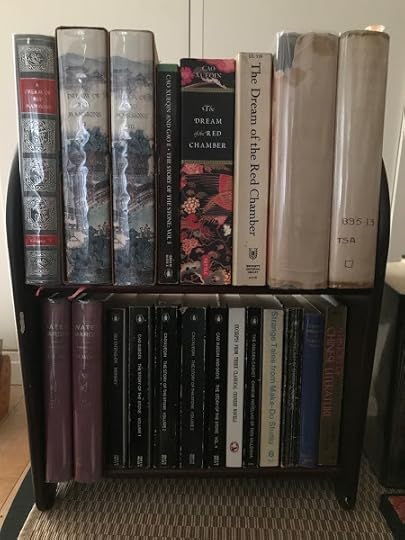 Bronwyn Lloyd: Redology Bookshelf (11/12/24)
Bronwyn Lloyd: Redology Bookshelf (11/12/24)As well as the four categories of Redologists mentioned in the Wikipedia page above, there's also a chronological breakdown of the various eras of study of the novel, compiled by Joey Bonner in 1976:
Pre-1791:Commentators on the pre-publication manuscripts, such as Rouge Inkstone and Odd Tablet, who mainly provide literary analysis of the first 80 chapters.
1791–1900:Post-publication questions over authorship of the addendum, speculation upon esoteric aspects of the book. After 1875 using the term "Redology" for the studies.
1900–1922:Mainly political interpretations.
1922–1953:"New Redology", led by Hu Shih, approaches questions of textual authenticity, documentation, dating, with a strong biographical focus. The labelling of previous periods as "Old Redology".
1954–1975:Marxist literary criticism: the book seen as a criticism of society's failures. Li Xifan's criticism of both Old Redology and Neo-Redologists such as Hu Shih and Yu Pingbo.
So what exactly has changed in Redology since 1976, which is (after all) half a century ago?
It's clearly a field of study for expert Sinologists only, but I suppose - in general terms - the "class" analysis of the novel has continued in Mainland China, whereas scholars at universities elsewhere have tended to stress other contextual and stylistic details of Cao's work.
One can see this even in the two major translations of the novel: the very literal Yang version, with its emphasis on the decadence of the Jia family's "Dream of Red Mansions" even in its title; whereas the more liberally interpretative Hawkes / Minford version tries to avoid the "Red Chamber Dream" label altogether, instead choosing to refer it by the name of the earlier, 80-chapter text, The Story of the Stone.
Speaking for myself, I'm glad to have access to both of these traditions: it is, after all, a book to be read - not simply one to pore over and annotate - and one advantage of the Marxist approaches prevalent in China has been that the novel has remained available there through all the turbulent years since 1949.
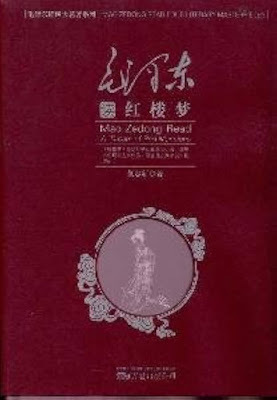 Dong Zhixin: Mao Zedong Reads Dream of the Red Chamber (2011)
Dong Zhixin: Mao Zedong Reads Dream of the Red Chamber (2011)Or, as Johannes Kaminski explains it in the abstract to his 2017 article "Toward a Maoist Dream of the Red Chamber: Or, How Baoyu and Daiyu Became Rebels Against Feudalism":
Mao Zedong’s views on literature were enigmatic: although he coerced writers into “learning the language of the masses,” he made no secret of his own enthusiasm for Dream of the Red Chamber, a novel written during the Qing dynasty. In 1954 this paradox appeared to be resolved when Li Xifan and Lan Ling presented an interpretation that saw the tragic love story as a manifestation of class struggle. Ever since, the conception of Baoyu and Daiyu as class warriors has become a powerful and unquestioned cliché of Chinese literary criticism ...
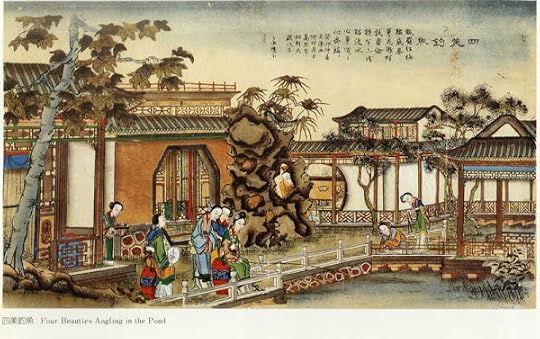 Yangliuqing New Year’s print: Four Beauties Angling in the Pond (late 18th-early 19th century)
Yangliuqing New Year’s print: Four Beauties Angling in the Pond (late 18th-early 19th century)The fact is that the Hung Lou Meng is, in many ways, a very frustrating book.
There's an old legend, reported by his early biographer Giovanni Boccaccio, that Dante Alighieri died leaving the last 13 cantos of his Divine Comedy incomplete. Dante’s sons, Jacopo and Piero, were about to start the presumptuous task of completing the work themselves, when the poet appeared to them in a dream and pointed out a sealed window alcove which turned out to contain a somewhat mildewed copy of the missing pages.
If only the same thing had happened with the Hung Lou Meng! The first 80 chapters of Cao Xueqin's work - all that was available in the earliest manuscripts - seem all to be by the same hand: albeit with marginal comments and revisions by a variety of commentators, possibly from the writer's own family.
The final 40 chapters in the 1791 printed version, which the book's editors, Gao E and Cheng Weiyuan, claimed to have compiled from the author's own remaining manuscripts, are very different in tone:
In 2014, three researchers using data analysis of writing styles announced that "Applying our method to the Cheng–Gao version of Dream of the Red Chamber has led to convincing if not irrefutable evidence that the first 80 chapters and the last 40 chapters of the book were written by two different authors."Whatever the status of these final chapters, they certainly don't fulfil the plot-expectations set up in the first part of the novel. It is, of course, possible that some of the writing contained in them comes from fragments left behind by Cao Xueqin, but there's no definitive evidence either way.
So the novel, albeit labelled as "complete" in its 120-chapter version, remains a magnificent fragment. But then, the same must be said of the Aeneid or The Canterbury Tales: works left incomplete on their authors' desks when they died. That doesn't hinder them from being considered as cornerstones of world literature. Cao Xueqin's novel is on that level - an immortal work of genius which repays endless study.
If you're curious to know more and (like me) you lack competence in Chinese, here are some possible starting points:
•
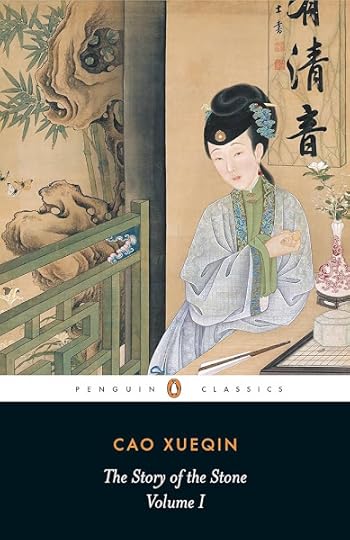 Cao Xueqin: Hung Lou Meng: The Story of the Stone (1973-86)
Cao Xueqin: Hung Lou Meng: The Story of the Stone (1973-86)Hongxue (Redology)
Lu Hsun. A Brief History of Chinese Fiction. 1923-24. Trans. Yang Hsien-Yi & Gladys Yang. 1959. Peking: Foreign Languages Press, 1982.Wu Shih-Ch’Ang. On The Red Chamber Dream: A Critical Study of Two Annotated Manuscripts of the XVIIIth Century. Oxford: Clarendon Press, 1961.Hsia, C. T. The Classic Chinese Novel: A Critical Introduction. 1968. Bloomington: Indiana University Press, 1980.Plaks, Andrew H. Archetype and Allegory in the Dream of the Red Chamber. Princeton, NJ: Princeton University Press, 1976.Hegel, Robert E. The Novel in Seventeenth-Century China. New York: Columbia University Press, 1981.Plaks, Andrew H. The Four Masterworks of the Ming Novel: Ssu ta ch'i-shu. Princeton, NJ: Princeton University Press, 1987.Rolston, David L., ed. How to Read the Chinese Novel. Contributions from Shuen-fu Lin, David T. Roy, Andrew H. Plaks, John C. Y Wang, David L. Rolston, Anthony C. Yu. Princeton Library of Asian Translations. Princeton, NJ: Princeton University Press, 1990.Edwards, Louise P. Men & Women in Qing China: Gender in The Red Chamber Dream. Sinica Leidensia #31. Leiden: E. J. Brill, 1994.Rolston, David L. Traditional Chinese Fiction and Fiction Commentary: Reading and Writing Between the Lines. Stanford, CA: Stanford University Press, 1997.Yu, Anthony C. Rereading the Stone: Desire and the Making of Fiction in Dream of the Red Chamber. Princeton, NJ: Princeton University Press, 1997.Liu Zaifu. Reflections on Dream of the Red Chamber. 2005. Trans. Shu Yanzhong. Amherst, NY: Cambria Press, 2008.Wu I-Hsien. Eroticism and Other Literary Conventions in Chinese Literature: Intertextuality in The Story of the Stone. Amherst, NY: Cambria Press, 2017.
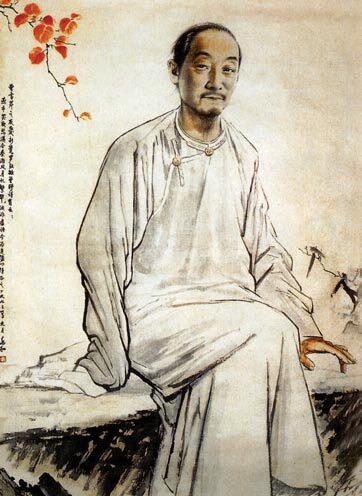 Cao Xueqin (c.1715-1763)
Cao Xueqin (c.1715-1763)•
Published on December 11, 2024 12:27
December 6, 2024
Jack Ross: Poems
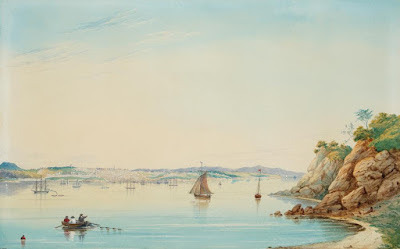 J.B.C. Hoyte: Auckland Harbour from Midway Between Flagstaff & O'Neill's Point (1870)
J.B.C. Hoyte: Auckland Harbour from Midway Between Flagstaff & O'Neill's Point (1870)Preface
Blue of sea and sky and distance, and white vaporous cloud. Light in Auckland dominates, penetrates, suffuses, as nowhere else in New Zealand; it envelops earth and trees, buildings, people, in a liquid air which at any moment might dissolve them into itself. Land and its solids are there only a condition, changing all the time, of water, air, light. - Charles Brasch. Indirections: A Memoir 1909-1947 (Wellington: Oxford University Press, 1980): 180.
The other day I took a drive out to Stokes Point in Northcote, a little reserve nestled under the pylons of the Auckland Harbour Bridge. It's a strange place: half building site, half architecturally designed park. It does, however, offer a marvellous view of the city.
A few years ago I was asked to assist with finding suitable texts to inscribe on the concrete pillars which hold up the underpinnings of the bridge. It was a somewhat vexed project (which you can read about here), but in the end most of the choices I offered - texts by prominent North Shore authors - did indeed end up getting plastered onto the stonework in question.
So if you want to encounter the "blue of sea and sky and distance" Charles Brasch described as characteristic of Auckland in the 1930s, Stokes Point is a good place to start. And there's the added bonus, too, of being able to see how it once looked through the eyes of expatriate British artist John Barr Clark Hoyte (1835-1913):
 J.B.C. Hoyte: View of Auckland from Stokes Point North (1871)
J.B.C. Hoyte: View of Auckland from Stokes Point North (1871)I feel a certain fondness for Hoyte's paintings. They're intensely idealised portraits of a land I think we'd all like to inhabit - a kind of lost paradise of gentle breezes and azure skies.
He apparently spent much of the 16 years he lived in New Zealand travelling "assiduously in search of new scenes to exploit" - whether it be Fiordland, the Volcanic Plateau, or picturesque views of the Pink and White Terraces. However, despite the dramatic character of most of these places:
it appears that his preference was for a more gentle, picturesque mode of landscape art rather than the heightened tensions of the sublime. The Otago Guardian in 1876 described 'the aspect of repose which usually characterises Mr Hoyte's illustrations of native landscapes'.That's it exactly: "the aspect of repose." What I like best about his views of Auckland harbour, in particular, is the way it becomes, for him (and thus for us as viewers), a place of light and beauty, with nature and man in perfect harmony.
It wasn't, of course. Te Kooti Arikirangi Te Tūruki was still waging guerilla war down on the East Coast. Auckland had just been supplanted as capital of New Zealand by a cabal of Australian commissioners. The economy was perilously up and down, and the relations between settlers and tangata whenua shaky at best.
Hoyte looks at all these things from afar. His fascination with light allows them to disappear for him. But that's what gives his work - for me, at least - its sense of historical irony.
Life was never like that in Auckland; but sometimes, when we kids sailed round the bays of the upper harbour in my father's little trailer-sailer, that sense of unattainable perfection seemed perilously close.
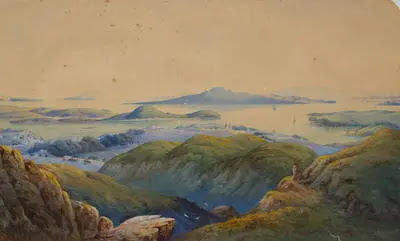 J.B.C. Hoyte: Auckland Harbour from Mt Eden (1873)
J.B.C. Hoyte: Auckland Harbour from Mt Eden (1873)I suppose that's why I chose these paintings by John Hoyte as the backdrop for my new website: a collection of most of my published poems to date.
There's much to be said for trying to break new ground. I imagine we all like to think ourselves as fresh and original in our writing and thinking. Sometimes, though - perhaps most of the time? - "the way up is the way down, the way forward is the way back" (T. S. Eliot, The Dry Salvages ). This site, then:
Jack Ross: Poems
contains the texts of all of the full-length poetry collections I've published over the years. As well as that, I've reprinted most of the poetry chapbooks which came out over the same period. And on top of that, there's a grab-bag category of my published but uncollected poems, which I've grouped chronologically or under categories (poems included in Novels or Stories, for instance).
Before listing them in order, with their separate links, however, I thought I'd better say some more about the structure of the site itself.

The first thing you see, if you click on this link, will be the warning above.
This is because some of my poems contain swear words and bad language of various kinds, and I've noticed in the past that this tends to get flagged by roving web editors, who red flag and - in some cases - actually take down any pages which offend in this way.
I've therefore decided to mark this site - along with those devoted to my three novels, Nights with Giordano Bruno (2000), The Imaginary Museum of Atlantis (2006), and E M O (2008) - as containing "Adult content".
This means that the "sensitive content" warning above is shown automatically to all potential readers, who will then have to log in with a Google ID to verify their age and adult status.
No doubt this will have the effect of reducing the number of clicks on each of these websites, but it also means that you have to be quite motivated to reach them - not in itself a bad thing. Bona fide readers are always very welcome, though.
Here, then, is a breakdown of the contents of my new poetry website:
•
Poetry BooksJack Ross: City of Strange Brunettes (1998)
City of Strange Brunettes. ISBN 0-473-05446-9. Auckland: Pohutukawa Press, 1998.Jack Ross: Chantal’s Book (2002)
Chantal’s Book. ISBN 0-473-08744-8. Wellington: HeadworX, 2002.Jack Ross: To Terezín (2007)
To Terezín. Afterword by Martin Edmond. Social and Cultural Studies, 8. ISSN 1175-7132. Auckland: Massey University, 2007.Jack Ross & Emma Smith: Celanie (2012)
Celanie: Poems & Drawings after Paul Celan. by Jack Ross & Emma Smith, with an Afterword by Bronwyn Lloyd. ISBN 978-0-473-22484-4. Auckland: Pania Press, 2012.Jack Ross: A Clearer View of the Hinterland (2014)
A Clearer View of the Hinterland: Poems & Sequences 1981-2014. ISBN 978-0-473-29640-7. Wellington: HeadworX, 2014.Jack Ross: The Oceanic Feeling (2021)
The Oceanic Feeling. Drawings by Katharina Jaeger. Afterword by Bronwyn Lloyd. ISBN 978-0-473-55801-7. Auckland: Salt & Greyboy Press, 2021.
•
Poetry ChapbooksJack Ross: Pound’s Fascist Cantos (1997)
Ezra Pound’s Fascist Cantos (72 & 73) together with Rimbaud’s “Poets at Seven Years Old.” Translated by Jack Ross. Auckland: Perdrix Press, 1997.
Jack Ross & Gabriel White: A Town Like Parataxis (2000)
A Town Like Parataxis. Photographs by Gabriel White. ISBN 0-473-07104-5. Auckland: Perdrix Press, 2000.Jack Ross & Gabriel White: The Perfect Storm (2000)
The Perfect Storm. Video by Gabriel White. ISBN 0-473-07350-1. Auckland: Perdrix Press, 2000.
Jack Ross: The Britney Suite (2001)
The Britney Suite. Auckland: Perdrix Press, 2001.Jack Ross: A Bus Called Mr Nice Guy (2005)
A Bus Called Mr Nice Guy. ISBN 0-473-10526-8. Auckland: Perdrix Press, 2005.Jack Ross: Love in Wartime (2006)
Love in Wartime. Wellington: Pania Press, 2006.Jack Ross: Papyri (2007)
Papyri: Love poems & fragments from Sappho & elsewhere. ISBN 978-0-473-12397-0. Auckland: Soapbox Press, 2007.Jack Ross: The Return of the Vanishing New Zealander (2009)
The Return of the Vanishing New Zealander. ISBN 978-0-9864507-6-1. Dunedin: Kilmog Press, 2009.Jack Ross & William T. Ayton: Scenes from The Puppet Oresteia (2011)
Scenes from The Puppet Oresteia. Artwork by William T. Ayton. ISBN 978-0-473-18881-8. Rhinebeck, NY: Narcissus Press / Auckland: Perdrix Press, 2011.Jack Ross & Karl Chitham: Fallen Empire (2012)
Fallen Empire: Museum of True History in Collaboration with Karl Chitham and Jack Ross. Dunedin: Blue Oyster Art Project Space, 2012.
•
MiscellaneousJack Ross: Collage Poems (2018)
Collage Poems (1997-2005)Poems from Novels (2000-2008)Poems from Stories (2004-2019)Tree Worship (2011-2012)Jack Ross: Tree Worship (2012)
•
Uncollected PoemsJack Ross: Newmarket (2006)
Poems: 1981-1999Poems: 2000-2004Poems: 2005-2009Poems: 2010-2015Poems: 2016-2024Dianne Firth: Canberra Tales (2017)
I'm not sure I'd recommend this approach to anyone else. I was inspired by Peter Simpson and Margaret Edgcumbe's online edition of Kendrick Smithyman's Collected Poems 1943-1995 . If I'd had any idea of how much work it would be, though, I would probably just have contented myself with my old MSWord files.
•
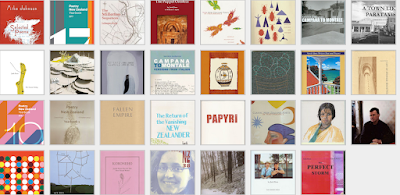 Jack Ross: Showcase (2023)
Jack Ross: Showcase (2023)•
Published on December 06, 2024 12:11
November 22, 2024
Jimmy's Riddles
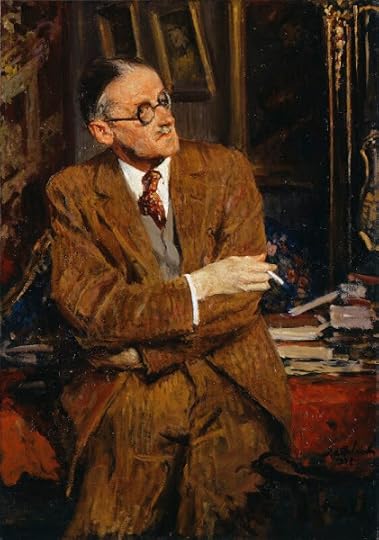 Jacques-Emile Blanche: James Joyce (1935)
Jacques-Emile Blanche: James Joyce (1935)This year, 2024, marks the fortieth anniversary of the publication of Hans Walter Gabler's still controversial "Critical and Synoptic Edition" of James Joyce's Ulysses.
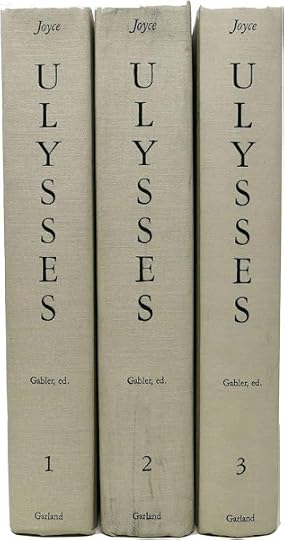 James Joyce: Ulysses (1922 / 1984)
James Joyce: Ulysses (1922 / 1984)In a on this blog, I discussed one of the most notorious features of Gabler's edition, his alleged discovery of the answer to Stephen Dedalus's question to his mother's ghost in the crucial Nighttown chapter (XV: Circe) of Joyce's novel:
Ulysses: A Critical and Synoptic Edition. Edited by Hans Walter Gabler with Wolfhard Steppe & Claus Melchior. 3 vols. New York and London: Garland, 1984.
Tell me the word, mother, if you know now. The word known to all men.In the original, 1922 text, the ghost instead urges Stephen to repent his sins:
Prayer is all powerful. Prayer for the suffering souls in the Ursuline manual, and forty days' indulgence. Repent, Stephen.which drives him off into further ravings: "The ghoul! Hyena!"
In Gabler's text, thanks to the fortuitous discovery of a ms. passage which may have escaped its own author's eye ("Mr. Gabler postulates the skip of an eye from one ellipsis to another, leading to the omission of several lines - the longest omission in the book," as Richard Ellmann helpfully explains in his preface to the 1986 paperback reprint), the word itself was at last revealed:
Do you know what you are talking about? Love, yes. Word known to all men. Amor vero aliquid alicui bonum vult unde et ea quae concupiscimus ...Ellmann glosses the Latin as a conjunction of two phrases from Thomas Aquinas's Summa Contra Gentiles:
Aquinas is distinguishing between love, which, as he says in the first six words, "genuinely wishes another's good," and, in the next five, a selfish desire to secure our own pleasure "on account of which we desire these things," meaning lovelessly and for our own good, not another's.
•
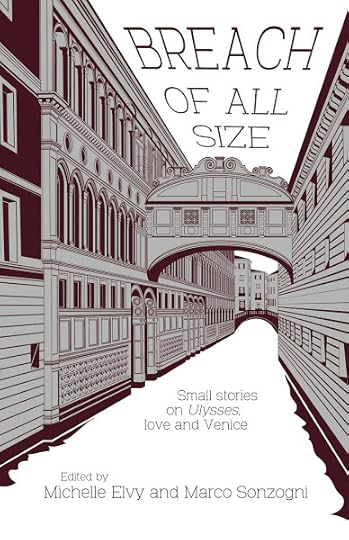 Michelle Elvy and Marco Sonzogni, ed.: Breach of All Size (2022)
Michelle Elvy and Marco Sonzogni, ed.: Breach of All Size (2022)A couple of years ago I was asked to contribute to a collection of "small love stories from 36 Aotearoa New Zealand writers set in or related to Venice and inspired by one of the world’s great (in size and impact) novels: James Joyce’s Ulysses."
Here are the rest of the instructions we were given:
Each story will be 421 words and begin with a phrase taken from the book (two from each chapter), used as the title. Beyond that, you can take your story in whatever creative direction you like (with the idea of ‘love story’ also interpreted by each individual writer).I do like working with the stimulation of a set of constraints - even ones as arbitrary as these - but the fact that I'd been assigned a phrase from chapter XV, the infamous brothel sequence from the novel, seemed more than a simple coincidence. Hans Walter Gabler, Stephen's mother, and the "word known to all men" duly took their places in the 421-word "love story" I eventually came up with.
Your title is:Skeleton tracks– which is from the fifteenth chapter of the novel (you can find the whole online at Project Gutenberg, here). You may use this in the story / prose poem, or just keep it as the title – that's up to you.
Why 421 words, and why the lines from the text? We are celebrating the 100th anniversary of the publication of Ulysses on 2 February 1922, the 1600th anniversary of the founding of Venice in 421. We like the creative clash between flash fiction, championing the micro-story, and Joyce’s sprawling modernist classic. As well, this is a nod to the relationship between New Zealand and Venice that began with Venetian Antonio Ponto’s arrival here aboard James Cook’s Endeavour. Ponto was Aotearoa’s first recorded Venetian visitor; his surname means ‘bridge’.
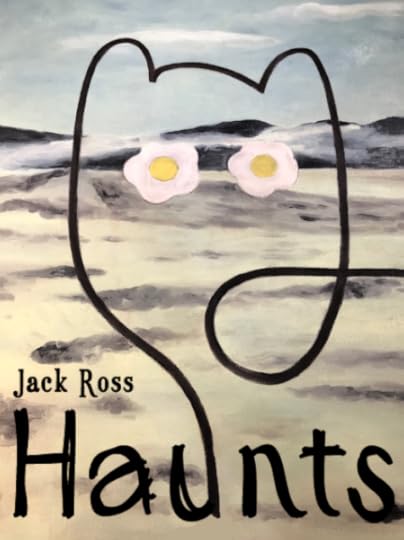 Jack Ross: Haunts (2024)
Jack Ross: Haunts (2024)And, yes, I did call it "Skeleton Tracks," as the editors suggested. You can find it reprinted in my latest collection Haunts, published earlier this year by Lasavia Publishing.
•
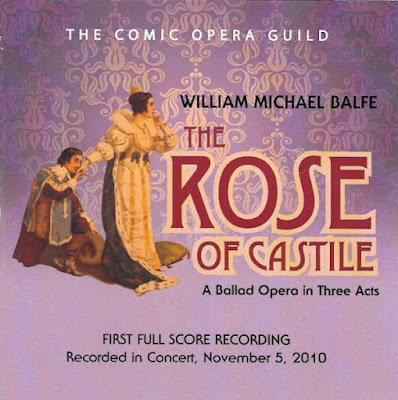 William Michael Balfe: The Rose of Castile (1857 / 2010)
William Michael Balfe: The Rose of Castile (1857 / 2010)When you start to pick at one detail in Joyce's masterpiece, though, it has a way of leading you on and on through the maze of his infinitely associative mind. "Skeleton Tracks" - I knew it reminded me of something. It turned out to be the "railway line" riddle in chapter VII: Aeolus (the god of wind):
Lenehan extended his hands in protest.While trying to locate this passage, I had the good luck to chance upon the brilliantly informative multi-authored website James Joyce Online Notes , which I can confidently recommend to any other novice adventurers setting out for Joyceland.
- But my riddle! he said. What opera is like a railway line?
- Opera? Mr O'Madden Burke's sphinx face reriddled.
Lenehan announced gladly:
- The Rose of Castile. See the wheeze? Rows of cast steel. Gee!
The Allusions section of this very compendious site offers the following sources for Lenehan's dreadful pun:
In “Two Gallants” Lenehan is described as “a sporting vagrant armed with a vast stock of stories, limericks and riddles”. The most conspicuous one is quoted above. But when Lenehan demands: "Silence for my brandnew riddle!" ... he is slightly overstating his case, for the first documented punning riddle about Balfe's successful opera turned up only six years after it was premiered in October 1857.Thanks Harald! Much appreciated. If you only knew how much time I've spent trying to track down such inconceivable minutiae through the pages of annotated copies of Ulysses, you'd understand how exciting it is to run across a (constantly expanding) website which answers so many of your nagging questions.Of what new opera do the present petticoats remind one?One year later the Birmingham Daily Post of Friday, 27 May informs its readers that The Rose of Castile (also Castille) is "popularly miscalled in allusion to its enduring pretensions to public favour, 'The Rose of Cast Steel'".
Rose of Castile (rows of cast steel)- The Boy's Handy Book ... (1863)
Punch followed in 1865:By the bye, if for burlesquing they want to find an opera in which they might most fitly introduce this magnet scene, they had better try their wits upon The Rose of Cast Steel.The closest forerunner of Lenehan's version was published in “Clippings from the weekly journals” in The Hull Packet and East Riding Times (Hull, England) on Friday, 28 May, 1880:"What favourite opera," enquires Bauldy, with a hiccup, "does the tramway lines remind one of?" and he replies with a hee-haw when eberybody gibs it up, "Why, the Rows of Cast Steel, to be sure!"- Harald Beck
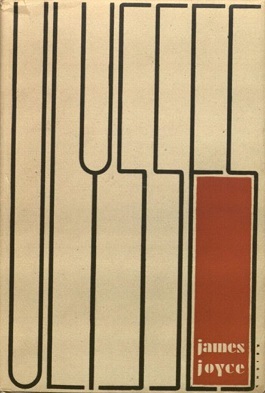 James Joyce: Ulysses (1934)
James Joyce: Ulysses (1934)Mind you, that same "Rose of Castile / Rows of Cast Steel" pun was also used by Henry Morton Robinson in his 1950 bestseller The Cardinal (1950), but of course that was long after the long-banned Ulysses finally became available in a commercial edition in America in 1934.
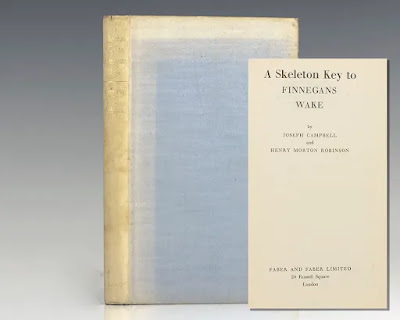 Campbell & Robinson: A Skeleton Key to Finnegans Wake (1947)
Campbell & Robinson: A Skeleton Key to Finnegans Wake (1947)Joseph Campbell, & Henry Morton Robinson. A Skeleton Key to Finnegans Wake. 1944. London: Faber, 1947.Henry Morton Robinson is perhaps better known as the co-author, with folklorist and philosopher Joseph Campbell, of A Skeleton Key to Finnegans Wake (1944), the first substantive attempt to explore the intricacies of Joyce's last - and definitely least accessible - work.
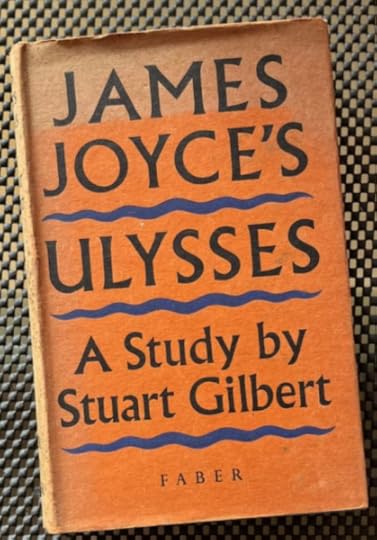 Stuart Gilbert: James Joyce's Ulysses (1930)
Stuart Gilbert: James Joyce's Ulysses (1930)Stuart Gilbert. James Joyce’s Ulysses: A Study. 1930. London: Faber, 1960.Campbell & Robinson's work was presumably meant to capitalise on the success of Stuart Gilbert's 1930 book about Joyce's Ulysses. But it wasn't so much Gilbert that punters assumed they were reading in that case - it was James Joyce himself. It was well known that Joyce had supplied Gilbert with much of the detail about the novel's structure and themes included in his text: so it had - and in some ways continues to have - a quasi-authorial status for fans.
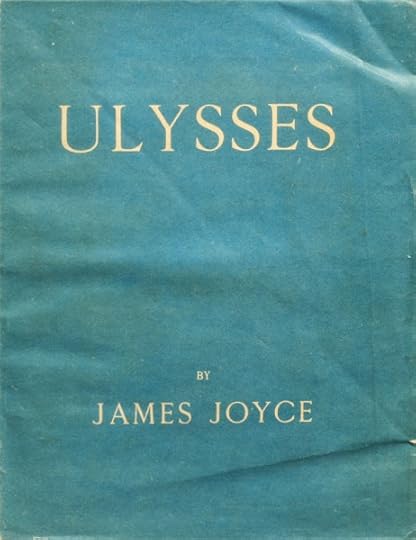 James Joyce: Ulysses (1922)
James Joyce: Ulysses (1922)Interestingly enough, as the online Literary Hub article "Ulysses: A History in Covers - The Many Lives of a High-Modern Classic" (2015) reveals:
While bookstores in America were still being persecuted for illegally selling the Shakespeare edition, Beach had the German Albatross Press take over the book’s European publishing; they established an imprint called the Odyssey Press for this purpose. To avoid legal problems, they inscribed this edition’s back page with a note reading, “Not to be introduced into the British Empire or the U.S.A.” This is considered to be the most accurate representation of Joyce’s authorial intent and contains corrections by Stuart Gilbert, who had claimed the title of “the official Joycean.”
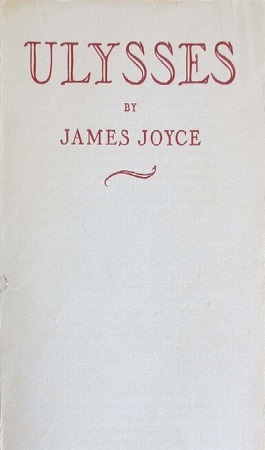 James Joyce: Ulysses (1933)
James Joyce: Ulysses (1933)You see what I mean? To a certain sort of mind, following such skeins of association and allusion is almost irresistible. It's not for nothing that Joyce himself said:
The demand that I make of my reader is that he should devote his whole life to reading my works.
•
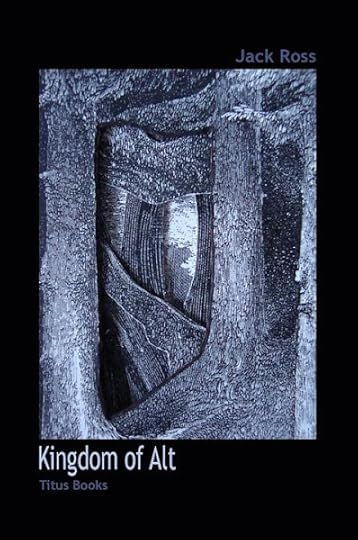 Jack Ross: Kingdom of Alt (2010)
Jack Ross: Kingdom of Alt (2010)Take, for example, the riddling postcard in chapter VIII: Lestrygonians (a tribe of man-eating giants, encountered by Odysseus on his voyage home to Ithaka):
She took a folded postcard from her handbag."U. p: up." What on earth does that mean? I tried in vain to solve it myself. "You pee," perhaps - some kind of gibe about urination. But why "up"? Was I reading too much into it? In any case, why was this card thought to be important enough to be shown around to friends and acquaintances?
— Read that, she said. He got it this morning.
— What is it? Mr Bloom asked, taking the card. U. P.?
— U. p: up, she said. Someone taking a rise out of him. It’s a great shame for them whoever he is.
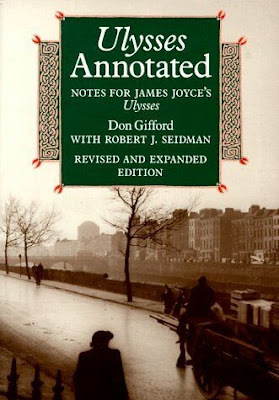 Don Gifford & Robert J. Seidman: Ulysses Annotated (1989)
Don Gifford & Robert J. Seidman: Ulysses Annotated (1989)Stuart Gilbert clearly considered it beneath his notice; but neither could I get much satisfaction from Don Gifford & Robert J. Seidman's annotated version of the novel.
So I asked a distinguished Joycean of my acquaintance to unravel it for me. To no avail. It did inspire a poem, though:
Later I added it to the novella "Coursebook found in a Warzone," included in my 2010 collection Kingdom of Alt:
U.p.: Up
I thought of a story about an Academic
one who hadn’t noticed he was dead
because they never opened up
the windows in his room
He sat there at his desk
book-ended by his filing cabinets
fading patterns on the wall
where his photographs had been
From time to time he’d look up from the pages
of last century’s quarterlies
see that day had shifted into dusk
& the streetlights had come on
The air was stale in there
he didn’t care
no need to tweak & update
the same old lectures now
•
“U.P.: Up” – Ulysses
I asked you to define it for me once
you couldn’t
not to my satisfaction anyway
I wonder if you’ll find it easier
alone there in the dark
pebbles in your pockets
chattering
to anyone who’ll listen?
Ave atque Vale then
to your Van Dyke beard
defiant little puku
amused bravado
whatever you deserved it wasn’t this
embarrassed silence these
absurd periphrases this
hermetically-sealed chamber
whose contents must
at the stroke of dawn
turn into dust
[2/7-21/10/08]
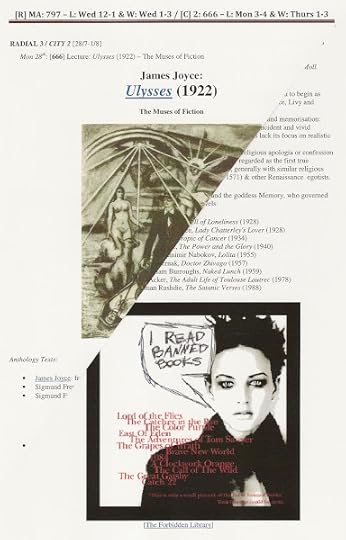
So what does designated hitter John Simpson have to say about it on the James Joyce Online Notes site?
Well, for a start, he takes the matter quite seriously, and admits its complexity:
Sometimes there are too many options available to allow us to be confident about the meaning (or a set of meanings) that should be ascribed to a term. Joyce’s use of “U. p: up” with reference to the slightly crack-brained Denis Breen is regarded as just such a problem, and it is one that has puzzled Joyce scholars for decades.Wisely, he begins with a summary of the context of the pun, or gag, or insult, or whatever it is:
Denis Breen receives a postcard. The message on the postcard seems to be U.P. Breen himself is infuriated, and wants to sue the sender for the astronomical sum of £10,000. Mrs Breen folds the postcard up and puts it in her bag, but still shows it to Bloom, who needs an explanation for the abbreviation. When others hear of the message they laugh. Why is the message so potent? Why does Joyce repeat the expression fourteen times in the pages of Ulysses?Why, indeed?
I should add to the note above the explanation that "fou tu" translates literally as "mad you" but also resembles a ruder word, "foutu", which translates (again literally) as "fucked."
Robert Martin Adams carefully reviews five principal options (Surface and Symbol, pp. 192-3). Don Gifford follows other commentators by throwing in one or two more possibilities. Vladimir Nabokov preferred to associate the expression with “U.P. spells goslings”, apparently a schoolboy insult recorded principally in the English midlands. Richard Ellmann is attracted to the schoolboy humour of “you pee up”, apparently the source of various potential urinatory or sexual innuendoes. Leah Harper Bowron carries the speculation game to the extreme, with a specific medical diagnosis:Denis Breen 'pees up' or sprays his urine upward when urinating from a standing position because he has hypospadias and his urethral opening is within or behind his testes.To avoid the pitfalls of retrofitting the sense of the message it seems safer, from a linguistic point of view, to look at what the expression “U. P.” might mean. Sam Slote sensibly offers a conservative view:We know that the French translation of Ulysses (at least approved in general if not at every turn by Joyce) takes a similar line:
U. P.: up - 'U.P., the spelling pronunciation of UP adverb, = over, finished, beyond remedy' (OED, s.vv., U; u.p.). The expression 'U.P.: up' dates at least as far back as Dickens (as quoted in OED).In the French edition of Ulysses the postcard is translated fou tu, "you're nuts, you've been screwed, you're all washed up". (Gifford: p. 163)
The notes on the Joyce website continue as follows:
We might look at how Joyce himself employs the term in a letter to Valery Larbaud of 17 October, 1928:And so on and so forth. A section quoting innumerable earlier uses of the expression follows, which I won't trouble you by sampling from in detail. However, it's worth mentioning the conclusion:Apparently I have completely overworked myself and if I don't get back sight to read it is all U-P up.Joyce includes a reference to the expression in a Cyclops notebook (dated to June – September 1919 in Zurich). As he had finished Lestrygonians in the autumn of 1918 this was probably just a reminder, but the entry seems to make it clear that “U. P.” is regarded by Joyce as being equivalent to “up” ...
We should remember, too, that just before Mrs Breen takes the folded postcard from her handbag to show it to Bloom, she says that her husband has been frightened by a nightmare in which he saw “the ace of spades” climbing “up” the stairs. The “ace of spades” is “a widow, esp. one wearing mourning weeds”, according to the OED. The expression is listed in Heinrich Baumann’s Londinismen, a catalogue of London cant and slang which Joyce knew and cites elsewhere. Perhaps that helps to explain Mr Breen’s eccentric reaction.
The general opinion within Joyce’s texts is that the unusual expression “U. p.: up” means more or less what the Oxford English Dictionary says: “over, finished, beyond remedy”.
At present the balance of evidence between the numerous potential meanings is more or less equal, with only one or two elements of support for each. But a review of contemporaneous attestations makes us realise that the traditional, conservative meaning (“all up”, finished, over) was much better known in Joyce’s day and for over half a century before than is remembered today. This does not rule out other interpretations, but it does tend to isolate the dominant sense.In overall summary, then:
Joyce uses variations of the expression “U P: up” fourteen times in Ulysses. The colon seems to indicate that the two sections of the expression have equivalent status and are not part of a longer abbreviation. The evidence is overwhelming that the ordinary person in the late nineteenth century would have known “U.P.” or “U.P. up” as a slang expression meaning “all up”, “over, finished, without remedy”, even “not likely to survive”. We know from a letter in 1928 that Joyce knew this explanation, and we assume that this is the meaning of the term he wrote down on one of his notesheets. In some circles, “U.P.” was also a well established abbreviation for “United Presbyterian”, but it is questionable how relevant this is to Denis Breen.
From the internal dynamics of Ulysses and from the social etiquette of the day (would Mrs Breen show Molly's husband a postcard with a virtually unspeakable obscenity?) we might regard the “You pee up” interpretation, which has sometimes found favour, to be laboured. The final occurrence of the abbreviation in the novel is found in Molly’s monologue ...:Now hes going about in his slippers to look for £10000 for a postcard U p up O sweetheart May wouldn’t a thing like that simply bore you stiff to extinction actually too stupid even to take his boots offAfter the I-narrator of “Cyclops” Molly has perhaps the most slanderous tongue in Ulysses. And yet she passes up the opportunity to make a malicious comment on the supposedly obscene allusion behind the wording of Breen’s postcard. She simply regards him as a forlorn-looking spectacle of a husband who is mad enough on occasions to go to bed with his boots on. This is in keeping with the way in which Breen is regarded generally in the novel – the cronies in Cyclops collapse with laughter at his lunatic behaviour, not because of some urinary or sexual irregularity.
There have been many other interpretations of the expression, normally made without appreciating the strength of the traditional meaning. One or other of these alternative readings may of course still be valid in a context of multiple interpretation, but without additional understanding of why Denis Breen runs to lawyers when he sees the postcard it is probably safest to stick to the conservative reading and to regard the others as only distant possibilities.
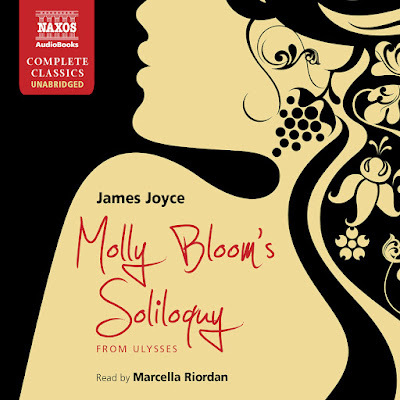 James Joyce: Molly Bloom's Soliloquoy (read by Marcella Riordan)
James Joyce: Molly Bloom's Soliloquoy (read by Marcella Riordan)Mind you, I'm not entirely convinced. I do still feel there's some urinary (or sexual) gibe underlying the sinister postcard - I can't see why Dennis Breen, eccentric though he undoubtedly is, would have reacted to it so strongly otherwise. And the "slanderous" Molly Bloom's use of the expression "bore you stiff to extinction" sounds a little pointed to me, in context.
I suppose, though, that the whole ridiculous farrago goes to illustrate a celebrated dictum from Vladimir Nabokov which I used to quote when introducing James Joyce's story "Clay" to my first-year Creative Writing students:
In reading, one should notice and fondle details. There is nothing wrong with the moonshine of generalization when it comes after the sunny trifles of the book have all been lovingly collected. If one begins with a ready-made generalization, one begins at the wrong end …It may well seem a waste of time to worry about the implications of the term “U. p.: up” instead of pondering the larger influence of Ulysses on twentieth-century European literature, but trying to do that would be (according to Nabokov) to start at the wrong end.
His remarks continue as follows:
Let me submit the following practical suggestion. Literature, real literature, must not be gulped down like some potion which may be good for the heart or good for the brain ... Literature must be taken and broken to bits, pulled apart, squashed - then its lovely reek will be smelt in the hollow of the palm, it will be munched and rolled upon the tongue with relish; then, and only then, its rare flavour will be appreciated at its true worth and the broken and crushed parts will again come together in your mind and disclose the beauty of a unity to which you have contributed something of your own blood.- Vladimir Nabokov, Lectures on Russian Literature (1981)Hopefully that's something we can all assent to.
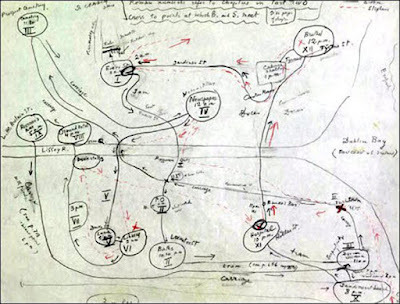 Vladimir Nabokov: A Map of Joyce's Ulysses (c.1948)
Vladimir Nabokov: A Map of Joyce's Ulysses (c.1948)•
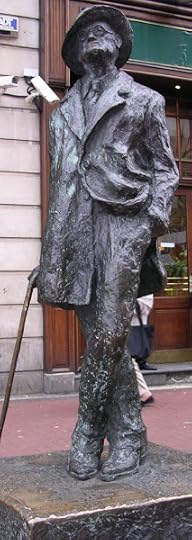 Marjorie Fitzgibbon: James Joyce (1990s)
Marjorie Fitzgibbon: James Joyce (1990s)James Augustine Aloysius Joyce
(1882-1941)
Fiction:
Dubliners (1914)The SistersAn EncounterArabyEvelineAfter the RaceTwo GallantsThe Boarding HouseA Little CloudCounterpartsClayA Painful CaseIvy Day in the Committee RoomA MotherGraceThe Dead Dubliners. 1914. London: Jonathan Cape, 1944.Dubliners: The Corrected Text. 1914. Explanatory Note by Robert Scholes. 1967. Jonathan Cape Paperback JCP 58. London: Jonathan Cape, 1968.Dubliners. 1914. Ed. Terence Brown. 1992. Penguin Classics. Harmondsworth: Penguin, 2000.Included in: The Essential James Joyce. Ed. Harry Levin. 1948. London: Jonathan Cape, 1952. A Portrait of the Artist as a Young Man (1916)A Portrait of the Artist as a Young Man: The Definitive Text, Corrected from the Dublin Holograph by Chester G. Anderson. 1916. Ed. Richard Ellmann. 1964. Jonathan Cape Paperback JCP 59. London: Jonathan Cape, 1968.A Portrait of the Artist as a Young Man. 1916. Ed. Seamus Deane. 1992. Penguin Classics. Harmondsworth: Penguin, 1999.Included in: The Essential James Joyce. Ed. Harry Levin. 1948. London: Jonathan Cape, 1952. Ulysses (1922)Ulysses, with ‘Ulysses: A Short History’, by Richard Ellmann. 1922. Penguin Modern Classics. Harmondsworth: Penguin, 1968.Ulysses. 1922. Illustrated by Kenneth Francis Dewey. Franklin Centre, Pennsylvania: The Franklin Library, 1979.Ulysses: The Corrected Text. 1922. Ed. Hans Walter Gabler with Wolfhard Steppe & Claus Melchior. 1984. Preface by Richard Ellmann. Penguin Modern Classics. Harmondsworth: Penguin, 1986.Ulysses: The 1922 Text. Ed. Jeri Johnson. The World’s Classics. Oxford: Oxford University Press, 1993.Gilbert, Stuart. James Joyce’s Ulysses: A Study. 1930. London: Faber, 1960.Gifford, Don, with Robert J. Seidman. Notes For Joyce: An Annotation of James Joyce’s Ulysses. New York: E. P. Dutton & Co., Inc., 1974.Delaney, Frank. James Joyce’s Odyssey: A Guide to the Dublin of Ulysses. Photographed by Jorge Lewinski. 1981. A Paladin Book. London: Granada Publishing Limited, 1983. Finnegans Wake (1939)Finnegans Wake. 1939. London: Faber, 1949.Scribbledehobble: The Ur-Workbook for Finnegans Wake. Ed. Thomas E. Connolly. Evanston, Illinois: Northwestern University Press / Oxford: Oxford University Press, 1961.A Shorter Finnegans Wake. Ed. Anthony Burgess. 1966. London: Faber, 1968.Beckett, Samuel, Marcel Brion, Frank Budgen, Stuart Gilbert, Eugene Jolas, Victor Llona, Robert McAlmon, Thomas McGreevy, Elliot Paul, John Rodker, Robert Sage, & William Carlos Williams. Our Exagmination Round His Factification For Incamination Of Work In Progress. With Letters of Protest by G. V. L. Slingsby & Vladmir Dixon. 1929. Faber Paper Covered Editions. London: Faber, 1972.Campbell, Joseph, & Henry Morton Robinson. A Skeleton Key to Finnegans Wake. 1944. London: Faber, 1947.McHugh, Roland. Annotations to Finnegans Wake. London: Routledge & Kegan Paul, 1980. Stephen Hero. 1904–06 (1944)Stephen Hero: Part of the First Draft of “A Portrait of the Artist as a Young Man”. 1904-6. Ed. Theodore Spencer. 1944. Revised Edition with Additional Material. Ed. John J. Slocum & Herbert Cahoon. 1956. London: Jonathan Cape, 1969.
Poetry:
Chamber Music (1907)Included in: The Essential James Joyce. Ed. Harry Levin. 1948. London: Jonathan Cape, 1952. Pomes Penyeach (1927)Pomes Penyeach and Other Verses. 1927. London: Faber, 1968. Collected Poems (1936)Giacomo Joyce. 1907 (1968)Giacomo Joyce. 1907. Ed. Richard Ellmann. 1968. Faber Paperbacks. London: Faber, 1983.
Plays:
Exiles (1918)Exiles: A Play in Three Acts. 1918. Introduction by Padraic Colum. N.E.L. Signet Modern Classics. 1962. London: the New English Library Limited, 1968.Included in: The Essential James Joyce. Ed. Harry Levin. 1948. London: Jonathan Cape, 1952.
For Children:
The Cat and the Devil (1965)The Cats of Copenhagen (2012)
Miscellaneous:
The Essential James Joyce. Ed. Harry Levin (1948)Levin, Harry, ed. The Essential James Joyce. ['Dubliners', 1914; 'A Portrait of the Artist as a Young Man', 1916; 'Exiles', 1918; 'Chamber Music', 1907]. 1948. London: Jonathan Cape, 1952. The Critical Writings of James Joyce. Ed. Ellsworth Mason & Richard Ellmann (1959)Ellmann, Richard, & Ellsworth Mason, ed. The Critical Writings of James Joyce. London: Faber, 1959. Poems and Shorter Writings (1991)Poems and Shorter Writings: Including Epiphanies, Giacomo Joyce and ‘A Portrait of the Artist.’ Ed. Richard Ellmann, A. Walton Litz & John Whittier-Ferguson. London: Faber, 1991.
Letters:
Letters of James Joyce. Ed. Stuart Gilbert (1957)Gilbert, Stuart, ed. Letters of James Joyce. Chronology by Richard Ellmann. London: Faber, 1957. Letters of James Joyce, Vol. 2. Ed. Richard Ellmann (1966)Letters of James Joyce, Vol. 3. Ed. Richard Ellmann (1966)Selected Letters of James Joyce. Ed. Richard Ellmann (1975)Ellmann, Richard, ed. Selected Letters of James Joyce. 1957 & 1966. London: Faber, 1975.
Secondary:
Eliot, T. S., ed. Introducing James Joyce: A Selection of Joyce’s Prose. 1942. Faber Paper Covered Editions. London: Faber, 1964.Ellmann, Richard. James Joyce: New and Revised Edition. 1959 & 1982. Oxford University Press Paperback. Oxford: Oxford University Press, 1983.Ellmann, Richard. Ulysses on the Liffey. 1972. London: Faber, 1974.Joyce, Stanislaus. My Brother’s Keeper. Ed. Richard Ellmann. Preface by T. S. Eliot. London: Faber, 1958.Levin, Harry. James Joyce: A Critical Introduction. 1944. Faber Paper Covered Editions. London: Faber, 1960.Power, Arthur. Conversations with James Joyce. Ed. Clive Hart. 1974. London: Millington Books Ltd., 1978.Walsh, Keri, ed. The Letters of Sylvia Beach. Preface by Noel Riley Fitch. New York: Columbia University Press, 2010.
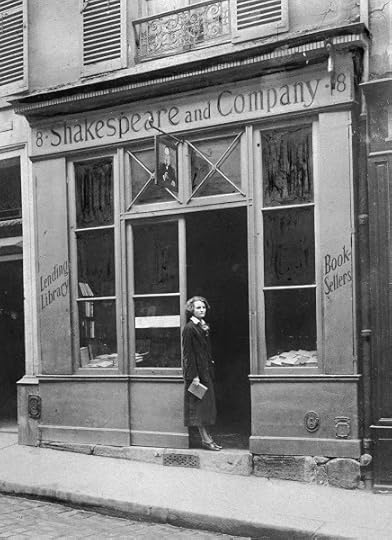 Sylvia Beach and her Bookshop (1922)
Sylvia Beach and her Bookshop (1922)•
Published on November 22, 2024 11:23
November 6, 2024
Pressure Cooker
 Netflix: Pressure Cooker (2023)
Netflix: Pressure Cooker (2023)Warning: numerous plot-spoilers ahead!
Over the years, Bronwyn and I have worked out the parameters for our own personal taste in Reality TV.
We're not particularly interested in people in bikinis and speedos arranging trysts on far-off tropical islands. Nor do we like eye-on-the-wall programmes about people having spiteful arguments in cramped apartments. Nor vote-them-off-the-island Survivor-type gamesmanship shows.
Not that we're throwing shade on anyone who does, mind you. Quot homines tot sententiæ, as the Latin dramatist Terence once put it: "So many people, so many opinions". Or, as Clint Eastwood paraphrased it in The Dead Pool: "Opinions are like assholes. Everbody's got one."
So where does that leave us? What we do seem to like consistently are programmes where a group of people compete in terms of some particular skill they all share.
 Vogue: Tracing Reality TV Style (2020)
Vogue: Tracing Reality TV Style (2020)As a result, we've watched competitions between fashion designers ( Project Runway / Next in Fashion ), glass artists ( Blown Away ), interior designer experts ( Interior Design Masters / The Big Interiors Battle ), make-up artists [MUAs] ( Face Off / Glow Up: Britain's Next Make-Up Star ), metalworkers ( Forged in Fire / Metal Shop Masters ), potters ( The Great Pottery Throw Down ), home sewers ( The Great British Sewing Bee ), woodworkers ( Good with Wood: Britain's Best Woodworker ) - even Drag fashion designers ( Sew Fierce! )
It sounds like quite a lot, when you list them like that. Every single one of them started off strange, then quickly became compelling. The intensity and sheer talent of the competitors was inspiring and (to be honest) a little intimidating at times.
 Entertainment Weekly: The 20 best cooking competition shows (2024)
Entertainment Weekly: The 20 best cooking competition shows (2024)What I haven't yet mentioned are the innumerable cooking programmes we've watched - some featuring trained chefs, others inspired amateurs - most of them designed to crown some "Top Chef" or "Master Chef" or "Best Baker" at the end of a series of gruelling contests.
 Netflix: Culinary Class Wars (2024)
Netflix: Culinary Class Wars (2024)At one time or another, we've probably tried them all. We don't have much patience left for the quasi-ubiquitous Gordon Ramsay, and neither of us ever really took to My Kitchen Rules , but we're always ready to give a newcomer a go. Recently that's included the intense Korean cooking competition Culinary Class Wars , as well as the new American show, Pressure Cooker , which - according to Wikipedia:
has been described as a mix of Top Chef and Big Brother - combining the cooking challenges of the former, and the social politicking of the latter.
 Tudum: Pressure Cooker Contestants
Tudum: Pressure Cooker ContestantsBy contrast, for all its Squid Game -style trappings, and its attempts to whip up class resentment along the lines of Oscar-winning Korean movie Parasite , Culinary Class Wars was really just a standard competitive cooking show like any other: the whims of the judges were what counted most.
 Eater: Culinary Class Wars Judges & Contestants
Eater: Culinary Class Wars Judges & ContestantsIn this case the two judges - veteran restaurateur Paik Jong-won, and Michelin three-star chef Anh Sung-jae - were presumably chosen for their respective penchants for traditional Korean cookery and international fine-dining.
As it turned out, they didn't always vote according to formula - nor did they really clearly embody the Old Guard / Young Turk divide which the show was designed to highlight. But when Anh Sung-jae announced that he would never give any dish - even one of his own - much more than 90 out of 100 ("since there's always room for improvement"), while Paik Jong-won regularly awarded much higher grades, the fairness of this system did seem a little open to question.
In essence, to quote a Stephen King-ism, SSDD [Same Shit, Different Day]. The focus throughout was too much on the judges, and the preprogrammed nature of the eventual decision led us to suspect that the producers had pretty much decided in advance that a young Black Shirt had to win over an old White Shirt, and a "genuine" Korean had to defeat the multicultural outsider Edward Lee.
The unpleasant arrogance of the young victor "Napoli Matfia" [? misspelling of Mafia?], whose predilection for pasta and other Italian dishes throughout made one question whether he could possibly have won fair and square if he, too, had been forced to undergo the interminable penultimate tofu challenge, left a somewhat bitter taste in the mouth.
What's more, Edward Lee's imperturbable courtesy, combined with his virtuosity and encyclopedic knowledge of the culinary arts, made him seem a more appropriate judge than competitor in such an exhausting ordeal.
The fact that Lee has gone from strength to strength since, whereas the actual "winner", Kwon Sung-jun, has been forced to eat humble pie and apologise profusely on social media for his churlish remarks and attitude throughout the series, combined to create a less than satisfactory experience.
 Stephanie Diani: Top Chef (2023)
Stephanie Diani: Top Chef (2023)l-to-r: Tom Colicchio, Padma Lakshi, Gail Simmons
To me, the whole thing illustrated the twin pitfalls of the TV cooking competition:the vogue of the celebrity judge:
As the number of series mounts up, contestants have come and gone in their droves; as a result, the presenters and judges have a tendency to become the real stars. Padma Lakshmi and her right-hand man Chef Tom Colicchio in Top Chef, Paul Hollywood and Prue Leith in The Great British Bake Off, and the various generations of Australian Masterchef judges all have their own catchphrases and mannerisms. At least the American shows have eschewed the tiresome British formula of having one or two clapped-out comedians to front each show, alongside some more sober-sided experts, but they too have their increasingly cast-iron tics and conventions.ubiquitous (and often inappropriate) product placement:
So why is Pressure Cooker such a refreshing departure from this model? Well, put simply, because it lacks judges and presenters: only the competing chefs are on display. Also, however, because the emphasis is on what the various cooks do with their ingredients, not on who supplied them in the first place.
Top Chef is a particular offender in this regard. Challenges sponsored by some particular junk-food manufacturer have become increasingly common, and increasingly obtrusive. Sponsorship should not come with tacit endorsement of such products in defiance of all the laws of good nutrition ...
So here they all are - all 11 contestants - in order of dismissal (you can see why I warned you about spoilers at the head of this post!)
•
Pressure Cooker Contestants
in order of departure
 1: Liv Ben
1: Liv BenLiv was sent home for serving undercooked chicken during the first challenge.
 2: Christan Willis
2: Christan WillisThis was the first piece of game-playing. The contestants had to choose between Christan and Brian, and the latter persuaded them that although he might be a weaker cook, he'd be a more grateful ally down the road.
 3: Brian Nadeau
3: Brian NadeauIn the breakfast cook-off between Brian and Ed, more people voted to keep the latter than the former.
 4: Lana Lagomarsini
4: Lana LagomarsiniMore gamesmanship. The devious Jeana persuaded the others that Lana was more of a threat to them than she was, given the latter's greater skill as a chef.
 5: Ed Porter
5: Ed PorterEd didn't stay for the customary goodbyes, but simply walked out on hearing that his dish had been judged last.
 6: Jeana Pecha
6: Jeana PechaIt had to happen. Jeana's intriguing finally caught up with her, and the vote to expel her was unanimous.
 7: Caroline Gutierrez
7: Caroline GutierrezCaroline made a tiny error in her dish, and that was enough to condemn her, given the very high standard of all the food by this stage in the competition.
 8: Renee Blackman
8: Renee BlackmanThere was a bizarre twist towards the end when Mike's winning dish earned him the right to decide which of the other three would face him in the final. He chose Robbie, possibly because he considered him a weaker opponent than either Renee or Sergei.
 9: Sergei Simonov
9: Sergei SimonovSergei was rather lost in any case without his "work wife" Caroline (her phrase). The others had taken to referring to the duo as "Sergoline," and saw their apparently unbreakable alliance as a looming threat.
 10: Mike Eckles
10: Mike EcklesMike assumed that his fine dining skills would bring him victory, but unfortunately for him, other factors - such as day-to-day behaviour in the house - came into the final decision as well.
 11: Robbie Jester
11: Robbie JesterAnd so Robbie, the underdog, carried off a popular and well-deserved victory. Despite his great talents, he probably wasn't the stronger chef, but he seemed to a majority of the others to be a more worthy human being.
•
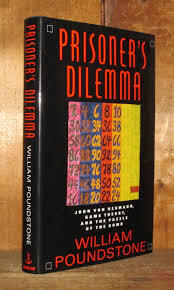 William Poundstone: Prisoner's Dilemma (1992)
William Poundstone: Prisoner's Dilemma (1992)William Poundstone. Prisoner’s Dilemma: John von Neumann, Game Theory, and the Puzzle of the Bomb. New York: Doubleday, 1992.
I certainly don't claim to be any authority on Game Theory, though I have dutifully worked my way through the book pictured above. Much of it was, alas, over my head. In particular, understanding the complexities of the "Prisoner's Dilemma" concept requires a grasp of mathematics which I simply don't have.
What I do understand about it seems, however - to me, at least - directly relevant to this competition. It's for this reason that I included so much detailed information about the fortunes of each contestant under the list of cast photographs above.
But what exactly is this "Prisoner's Dilemma"? This is how William Poundstone explains it:
Two members of a criminal gang are arrested and imprisoned. Each prisoner is in solitary confinement with no means of speaking to or exchanging messages with the other. The police admit they don't have enough evidence to convict the pair on the principal charge. They plan to sentence both to a year in prison on a lesser charge. Simultaneously, the police offer each prisoner a Faustian bargain. If he testifies against his partner, he will go free while the partner will get three years in prison on the main charge.So the dilemma is simply this: should they both clam up, or should they testify against each other? But wait, there's more:
Oh, yes, there is a catch ... If both prisoners testify against each other, both will be sentenced to two years in jail. The prisoners are given a little time to think this over, but in no case may either learn what the other has decided until he has irrevocably made his decision. Each is informed that the other prisoner is being offered the very same deal. Each prisoner is concerned only with his own welfare — with minimizing his own prison sentence.So, in other words, there are four different possible outcomes for prisoners A and B:
If A and B both remain silent, they will each serve one year in prison. If A testifies against B but B remains silent, A will be set free while B serves three years in prison.If A remains silent but B testifies against A, A will serve three years in prison and B will be set free.If A and B testify against each other, they will each serve two years.
Here's a little diagram to illustrate these various scenarios:
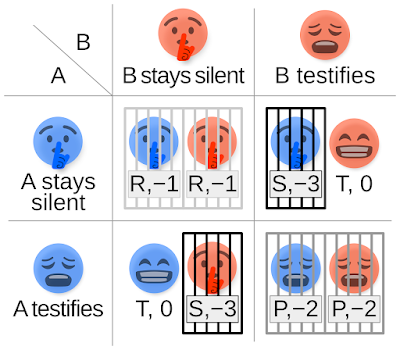 Wikipedia: Prisoner's Dilemma
Wikipedia: Prisoner's DilemmaSo if I'm A and you're B, what's my best line of action? If I think that you're likely to stay silent, then it would be best for me to turn you in. If, however, I think you're likely to talk, then it would be best for me to talk too, rather than staying silent and getting three years instead of two.
Is it best to be selfish, or to show solidarity with my fellow prisoner?
The Wikipedia article on the subject sums it up as follows:
Regardless of what the other decides, each prisoner gets a higher reward by betraying the other ("defecting"). The reasoning involves analyzing both players' best responses: B will either cooperate or defect. If B cooperates, A should defect, because going free is better than serving 1 year. If B defects, A should also defect, because serving 2 years is better than serving 3. So, either way, A should defect since defecting is A's best response regardless of B's strategy. Parallel reasoning will show that B should defect.So far, so easy. That's pretty much Adam Smith's prescription of enlightened self-interest and the invisible hand of the market. But life isn't always as simple as that. There are also variants on the game:
Defection always results in a better payoff than cooperation, so it is a strictly dominant strategy for both players.
If two players play the prisoner's dilemma more than once in succession, remember their opponent's previous actions, and are allowed to change their strategy accordingly, the game is called the iterated prisoner's dilemma.This "iterated prisoner's dilemma" is also called the "peace-war game":
The iterated prisoner's dilemma is fundamental to some theories of human cooperation and trust. Assuming that the game effectively models transactions between two people that require trust, cooperative behavior in populations can be modeled by a multi-player iterated version of the game.The value of cooperation cannot be taken for granted, however:
If the iterated prisoner's dilemma is played a finite number of times and both players know this, then the dominant strategy ... is to defect in all rounds. The proof is inductive: one might as well defect on the last turn, since the opponent will not have a chance to later retaliate. Therefore, both will defect on the last turn. Thus, the player might as well defect on the second-to-last turn, since the opponent will defect on the last no matter what is done, and so on. The same applies if the game length is unknown but has a known upper limit.
For cooperation to emerge between rational players, the number of rounds must be unknown or infinite. In that case, "always defect" may no longer be a dominant strategy. ... rational players repeatedly interacting for indefinitely long games can sustain cooperation. Specifically, a player may be less willing to cooperate if their counterpart did not cooperate many times, which causes disappointment. Conversely, as time elapses, the likelihood of cooperation tends to rise, owing to the establishment of a "tacit agreement" among participating players. In experimental situations, cooperation can occur even when both participants know how many iterations will be played. [my emphases]
•
 Tudum: Pressure Cooker Contestants
Tudum: Pressure Cooker ContestantsThe analogies with the game-show Pressure Cooker are, of course, far from exact. For a start, there are 11 players, not 2, and the competition rules change unpredictably with each challenge.
From my own observations - particularly of the straight-to-camera footage of each contestant - virtually all of them came into this situation determined to look after number one, and to follow the strategy most likely to earn them victory.
And yet, by the end of the programme, even the most arrogant and driven of the various competitors - Mike - was at least paying lip service to the amount he'd "learned" from the other chefs, and the ways in which he'd grown as a person as a result.
In fact, the only one of them who had much to fear when this footage was screened to the world - and her fellow contestants - was Jeana. She'd told a number of lies in the course of the episodes, and was suspected of duplicity by most of the others as a result. She justified all this as simply "playing the game," but the fact that none of her dishes ever came top at any point made it seem as if she saw this as her only chance of winning.
Everyone else formed alliances and friendships, but during the "blind tastings" of each other's food, there was not a single occasion when any of them applied any criterion except simple merit - although some of them discussed the idea of trying to detect and vote down the work of more powerful players, they didn't actually do it.
The strong abilities of almost all of the chefs - even Jeana, whose mastery of Mexican cuisine became apparent as the contest went on - made it clear that they were learning from each other as they got more familiar with one another, and that in many ways this was supplanting the increasingly distant prospect of that single cash prize.
In the end, Robbie's final meal was described by him as an hommage to the other chefs, with explicit references to particular dishes they'd cooked coded into each course. This "heart on his sleeve" approach - compassionate towards the others, but also honest about his own feelings - appears to be what won him the competition.
His younger opponent Mike, almost certainly his superior in technique and inventiveness, lost by a margin of one vote, mainly because - as a few of them remarked - he was guaranteed great success in his career in the long run, in any case.
Even though the participants did know how many iterations of the basic game would be played, the elements of uncertainty in each round seem to have made cooperation and mutual respect not only a viable but a winning strategy. The most orthodox gameplayer, Jeana, was eliminated because the others all had memories of her previous action. They could compare what she was saying now with what she'd done previously.
And, in the eyes of the larger community outside the game, almost all of the contestants - besides Jeana - had shown themselves skilful and cooperative in all sorts of cooking situations. Who would hesitate to work with any one of them? Jeana, however, had failed the job interview. Her longterm prospects of opening a restaurant with her long-estranged father seem dubious. All this despite the fact that her skill at blending flavours, and in Mexican cooking in particular, were strongly in evidence on screen.
To quote one Reddit commentator's blunt assessment:
She was so grimy for what she did to christian and lana. So many alligator tears and fake encounters, she was my least favorite 1000%Jeana, I wish you well, but I doubt that you have much prospect of remaining friends with any of the other cast members. I just hope your strict adherence to self-advantage, the optimum strategy within a single-iteration version of Prisoner's Dilemma, doesn't cost you too dearly in the other parts of your life.
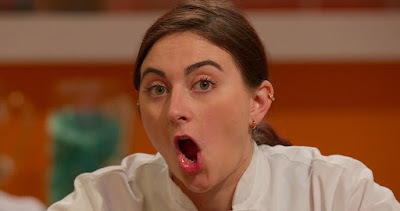 Jeana Pecha
Jeana Pecha•
Published on November 06, 2024 18:24



